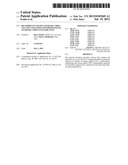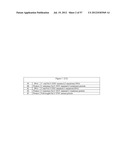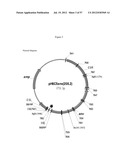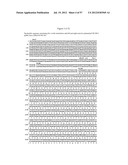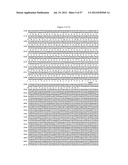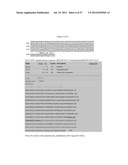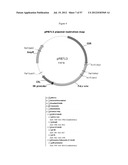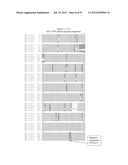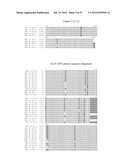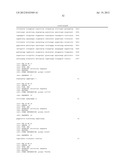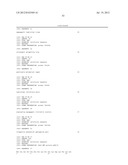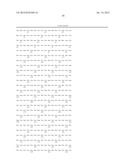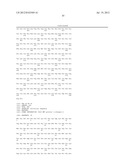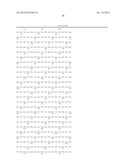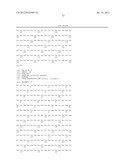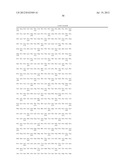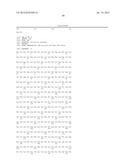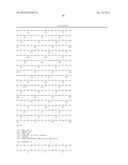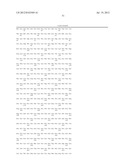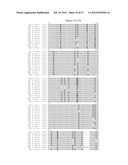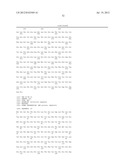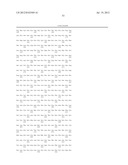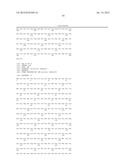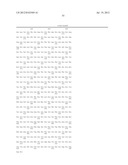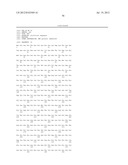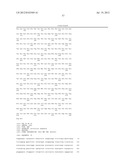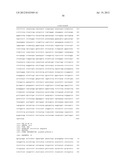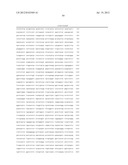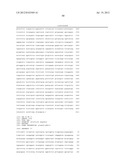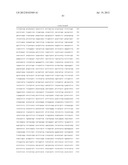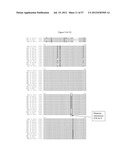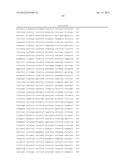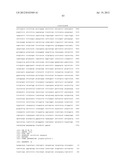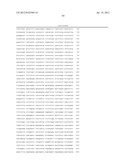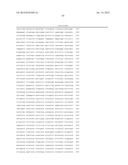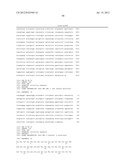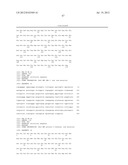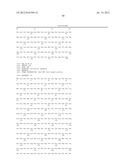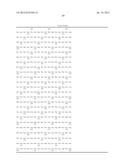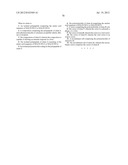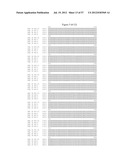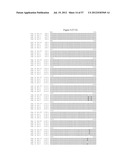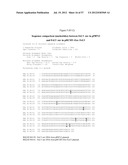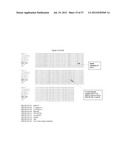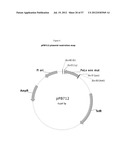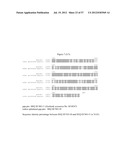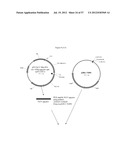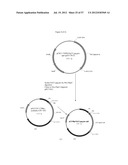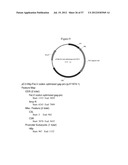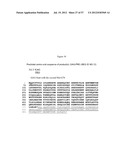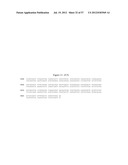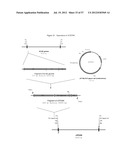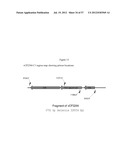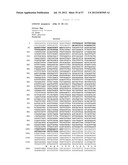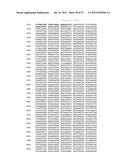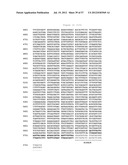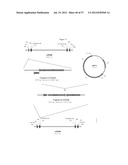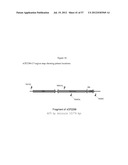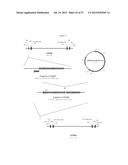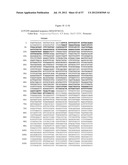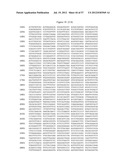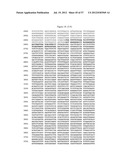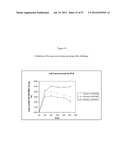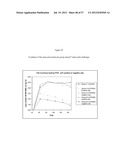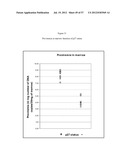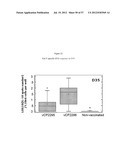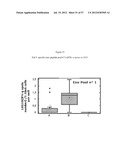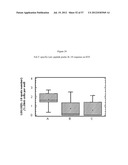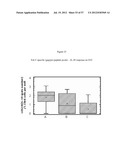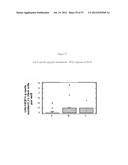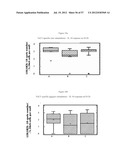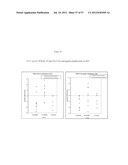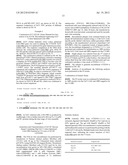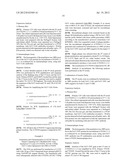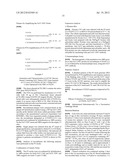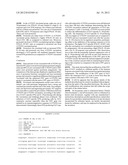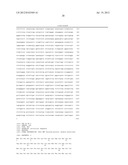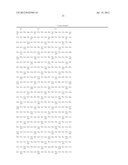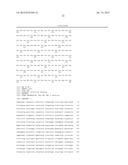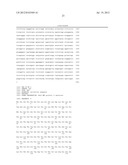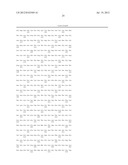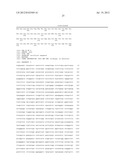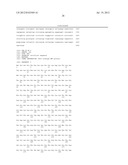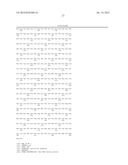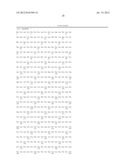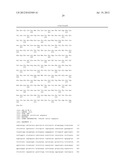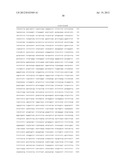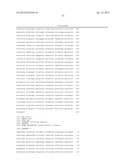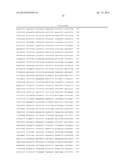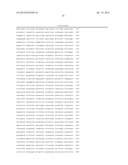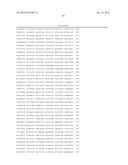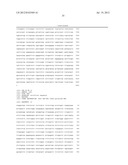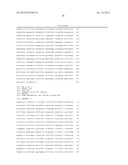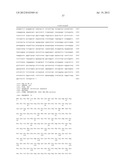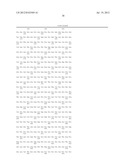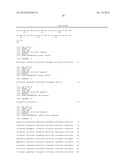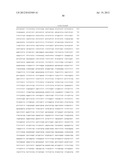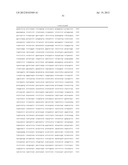Patent application title: RECOMBINANT FELINE LEUKEMIA VIRUS VACCINE CONTAINING OPTIMIZED FELINE LEUKEMIA VIRUS ENVELOPE GENE
Inventors:
Hervé Poulet (Sainte Foy-Les-Lyon, FR)
Thierry Heidmann (Paris, FR)
Thierry Heidmann (Paris, FR)
IPC8 Class: AA61K3921FI
USPC Class:
4241871
Class name: Amino acid sequence disclosed in whole or in part; or conjugate, complex, or fusion protein or fusion polypeptide including the same disclosed amino acid sequence derived from virus retroviridae (e.g., feline leukemia, etc.)
Publication date: 2012-07-19
Patent application number: 20120183569
Abstract:
The present invention provides vectors that contain and express in vivo
or in vitro FeLV antigens that elicit an immune response in animal or
human against FeLV, compositions comprising said vectors and/or FeLV
polypeptides, methods of vaccination against FeLV, and kits for use with
such methods and compositions.Claims:
1. An isolated polypeptide comprising the amino acid sequence of SEQ ID
NO:2 or SEQ ID NO:4.
2. A composition comprising the polypeptide of claim 1, and a pharmaceutically or veterinary acceptable vehicle, diluent or excipient.
3. The composition of claim 2, wherein the composition is capable of eliciting an immune response in a host.
4. The isolated polypeptide of claim 1 consisting of the amino acid sequence of SEQ ID NO:2 or SEQ ID NO:4.
5. An isolated polynucleotide coding for the polypeptide of claim 1.
6. The polynucleotide of claim 4 comprising the nucleic acid sequence of SEQ ID NO:1 or SEQ ID NO:3.
7. A vector comprising the polynucleotide of claim 5 or 6.
8. The vector of claim 7, wherein the vector is a plasmid, a phage, or a virus.
9. The vector of claim 8, wherein the vector is a viral vector.
10. The vector of claim 9, wherein the viral vector is an avipox vector.
11. A recombinant cell comprising the polynucleotide of claim 5 or 6.
12. The recombinant cell of claim 11, wherein the recombinant vector comprises the vector of claim 6.
Description:
CROSS-REFERENCE TO RELATED APPLICATIONS
[0001] This application claims priority to U.S. provisional application 61/509,912 filed Jul. 20, 2011, and is a continuation-in-part of U.S. application Ser. No. 11/547,399 filed Mar. 30, 2005.
FIELD OF THE INVENTION
[0002] The present invention relates to compositions or vaccines for combating feline leukemia virus infections in animals. Specifically, the present invention provides vectors that contain and express in vivo or in vitro optimized feline leukemia virus envelope antigens that elicit an immune response in animals against feline leukemia virus, including compositions comprising said vectors, methods of vaccination against feline leukemia virus, and kits for use with such methods and compositions.
BACKGROUND OF THE INVENTION
[0003] Feline Leukemia Virus (FeLV) is a common cause of infection of domestic cats throughout the world and a cause of significant morbidity and mortality. The prevalence of antigenaemia may vary from 1 to 5 percent in healthy cats to 15 to 30 percent in sick cats (Hosie M. J. et al., Veterinary Records, 1989, 128, 293-297; Braley J., Feline Practice, 1994, 22, 25-29; Malik R. et al., Australian Veterinary Journal, 1997, 75, 323-327; Arjona A. et al., Journal of Clinical Microbiology, 2000, 38, 3448-3449). The virus may establish a life-long infection characterized by a persistent viraemia and a fatal outcome. Most FeLV-related diseases occur persistently in infected animals, and they are always serious and most likely fatal. Among the most frequently diagnosed conditions are lymphomas, myeloid leukaemias, immunodeficiency and non-regenerative anaemia. The infection can be controlled by the identification and isolation of persistently viraemic cats, which are the source of the infection. Vaccines have also helped to prevent the virus spreading. Several FeLV vaccines are available. Most of them contain either inactivated virus or recombinant subunits. Their efficacy is controversial (Sparkes A. H., Journal of Small Animal Practice, 1997, 38, 187-194). Vaccine breakdowns have been observed.
[0004] An alternative way would be to use recombinant viral vector. The canarypox virus vector and especially the ALVAC vector have been tested for the expression of FeLV genes (Tartaglia J. et al., Journal of Virology, 1993, 67, 2370-2375; Poulet H. et al., Veterinary Record, 2003, 153, 141-145). A commercial recombinant FeLV vaccine is also available (EURIFEL® FeLV, Merial).
[0005] The FeLV genome codes for three genes: a GAG gene coding for the major structural components of the virus, an ENV gene which codes for the envelope glycoprotein, and a POL gene cndoing the polymerase protein (Thomsen D. R., et al., Journal of General Virology, 73, 1819-1824, 1992). The FeLV envelope (ENV) gene encodes a gp85 precursor protein which is proteolytically processed by cellular enzymes(s) to yield the major envelope glycoprotein gp70 and the associated transmembrane protein p15E (DeNoronha, F., et al., 1978, Virology 85:617-621; Nunberg, J. H., et al., 1983, PNAS 81:3675-3679). The transmembrane protein p15E contains a sequence conserved among gammaretroviruses with immunosuppressive properties (Mathes, L. E. et al., 1978, Nature). FeLV envelope glycoprotein is one of the major immunogens and is the target of FeLV-specific cytotoxic T cell responses as well as neutralizing antibodies (Flynn, J. N., et al., 2002, J. Virol.). US patent application US 2008/0008683 discussed a polypeptide that is capable of modulating the immunosuppressive properties of a viral protein against the host in which it is expressed. The FeLV GAG gene encodes a precursor polyprotein which is cleaved by the protease (FeLV PRO gene) to generate the capsid proteins. The capsid proteins are also a major immunogen inducing FeLV-specific cytotoxic T cell responses as well as neutralizing antibodies (Flynn, J. N., et al., 2002, J. Virol.). The POL gene encodes three proteins: protease (PRO), reverse transcriptase and integrase. Autoprocessing by the protease portion of the gene gives rise to all three proteins of the POL region (Thomsen D. R., et al., 1992).
[0006] There is a general need for an improvement in efficacy and safety of the FeLV vaccines and for more effective protection in field conditions.
SUMMARY OF THE INVENTION
[0007] An object of this invention can be any one or all of providing recombinant vectors or viruses as well as methods for making such viruses, and providing compositions and/or vaccines as well as methods for treatment and prophylaxis of infection by FeLV.
[0008] The invention provides a recombinant vector, such as a recombinant virus, e.g., a recombinant poxvirus, that contains and expresses at least one exogenous nucleic acid molecule and, the at least one exogenous nucleic acid molecule may comprise a nucleic acid molecule encoding an immunogen or epitope of interest from FeLV proteins, such as FeLV ENV and/or FeLV GAG/PRO.
[0009] In particular, the present invention provides a recombinant vector, such as a recombinant virus, e.g., a recombinant poxvirus, that contains and expresses at least one exogenous nucleic acid molecule and, the at least one exogenous nucleic acid molecule may comprise FeLV polypeptides and/or variants or fragments thereof.
[0010] The invention further provides compositions or vaccine comprising such an expression vector or the expression product(s) of such an expression vector.
[0011] The invention further provides methods for inducing an immunological (or immunogenic) or protective response against FeLV, as well as methods for preventing FeLV or disease state(s) caused by FeLV, comprising administering the expression vector or an expression product of the expression vector, or a composition comprising the expression vector, or a composition comprising an expression product of the expression vector.
[0012] The invention also relates to expression products from the virus as well as antibodies generated from the expression products or the expression thereof in vivo and uses for such products and antibodies, e.g., in diagnostic applications.
[0013] These and other embodiments are disclosed or are obvious from and encompassed by, the following Detailed Description.
BRIEF DESCRIPTION OF DRAWINGS
[0014] The following detailed description, given by way of example, and which is not intended to limit the invention to specific embodiments described, may be understood in conjunction with the accompanying figures, incorporated herein by reference, in which:
[0015] FIG. 1 provides a table identifying the SEQ ID NO assigned to the polynucleotide and protein sequence.
[0016] FIG. 2 depicts a plasmid map of pH6C5env (208.2).
[0017] FIG. 3 provides the sequences for plasmid pCXL208.2 (pH6C5env) fragment containing FeLV ENV DNA and left and right arms (SEQ ID NO:36) and FeLV ENV protein (SEQ ID NO:7) from plasmid pHCMV-ENV FeLV.
[0018] FIG. 4 provides the restriction map for plasmid pPB713.
[0019] FIG. 5 provides the sequence alignments of the FeLV ENV DNA and proteins.
[0020] FIG. 6 provides the plasmid pPB712 restriction map.
[0021] FIG. 7 shows the DNA sequence alignment between wild-type GAG/PRO DNA (SEQ ID NO:11) and codon-optimized GAG/PRO DNA (SEQ ID NO:10).
[0022] FIG. 8 provides the cloning scheme.
[0023] FIG. 9 provides the restriction map of plasmid pJY1874.1.
[0024] FIG. 10 provides the FeLV GAG-PRO protein sequence.
[0025] FIG. 11 shows the nucleotide sequence of the pJY1874.1 DNA fragment containing the arms and insert (SEQ ID NO:38).
[0026] FIG. 12 provides the cloning scheme for making vCP2294 plasmid.
[0027] FIG. 13 shows the vCP2294 plasmid C3 region map with primer locations.
[0028] FIG. 14 depicts the vCP2294 plasmid sequence (annotated).
[0029] FIG. 15 provides the cloning scheme for making vCP2296 plasmid.
[0030] FIG. 16 shows the vCP2296 plasmid C5 region map with primer locations.
[0031] FIG. 17 provides the cloning scheme for making vCP2295 plasmid.
[0032] FIG. 18 depicts the vCP2295 plasmid sequence.
[0033] FIG. 19 is a graph showing the evolution of the mean proviremia per group after challenge.
[0034] FIG. 20 is a graph showing the evolution of the mean proviremia per group and p27 status after challenge.
[0035] FIG. 21 is a graph showing the proviremia in marrow correlating to p27 status.
[0036] FIG. 22 shows the FeLV specific-IFNγ response on D35.
[0037] FIG. 23 shows the FeLV specific (ENV peptide pool No. 1) IFNγ response on D35.
[0038] FIG. 24 shows the FeLV specific (ENV peptide pools) IL-10 response on D35.
[0039] FIG. 25 shows the FeLV specific (GAG/PRO peptide pools)--IL-20 response on D35.
[0040] FIGS. 26a-b show the FeLV specific (ENV stimulation)--IFNγ/IL-10 ratio on D35.
[0041] FIG. 27 shows the FeLV specific (GAG/PRO stimulation)--IFNγ response on D126.
[0042] FIG. 28a shows the FeLV specific (ENV stimulation)--IL-10 response on D126.
[0043] FIG. 28b shows the FeLV specific (GAG/PRO stimulation)--IL-10 response on D126.
[0044] FIG. 29 shows the FeLV specific IFNγ/IL-10 ratio FeLV ENV and GAG/PRO peptide pools on D35.
DETAILED DESCRIPTION
[0045] It is noted that in this disclosure and particularly in the claims, terms such as "comprises", "comprised", "comprising" and the like can have the meaning attributed to it in U.S. Patent law; e.g., they can mean "includes", "included", "including", and the like; and that terms such as "consisting essentially of" and "consists essentially of" have the meaning ascribed to them in U.S. Patent law, e.g., they allow for elements not explicitly recited, but exclude elements that are found in the prior art or that affect a basic or novel characteristic of the invention.
[0046] Unless otherwise noted, technical terms are used according to conventional usage. Definitions of common terms in molecular biology may be found in Benjamin Lewin, Genes V. published by Oxford University Press, 1994 (ISBN 0-19-854287-9); Kendrew et al. (eds.), The Encyclopedia of Molecular Biology, published by Blackwell Science Ltd., 1994 (ISBN 0-632-02182-9); and Robert A. Meyers (ed.), Molecular Biology and Biotechnology: a Comprehensive Desk Reference, published by VCH Publishers, Inc., 1995 (ISBN 1-56081-569-8).
[0047] The singular terms "a," "an," and "the" include plural referents unless context clearly indicates otherwise. Similarly, the word "or" is intended to include "and" unless the context clearly indicate otherwise. The word "or" means any one member of a particular list and also includes any combination of members of that list.
[0048] The term "FeLV ENV polypeptide or DNA" refers to any native or optimized/mutated FeLV ENV polypeptide or DNA, and their derivatives and variants. For example, the optimized/mutated FeLV ENV DNA may be codon-optimized FeLV DNA, the FeLV ENV DNA may be optimized to produce a single amino acid mutation in the FeLV polypeptide. The optimized/mutated FeLV ENV polypeptide may comprise a single amino acid mutation, or a double amino acid mutation, or a multiple amino acid mutation.
[0049] The term "animal" is used herein to include all mammals, birds and fish. The animal as used herein may be selected from the group consisting of equine (e.g., horse), canine (e.g., dogs, wolves, foxes, coyotes, jackals), feline (e.g., lions, tigers, domestic cats, wild cats, other big cats, and other felines including cheetahs and lynx), bovine (e.g., cattle), porcine (e.g., pig), ovine (e.g., sheep, goats, lamas, bisons), avian (e.g., chicken, duck, goose, turkey, quail, pheasant, parrot, finches, hawk, crow, ostrich, emu and cassowary), primate (e.g., prosimian, tarsier, monkey, gibbon, ape), humans, and fish. The term "animal" also includes an individual animal in all stages of development, including embryonic and fetal stages.
[0050] The terms "polypeptide" and "protein" are used interchangeably herein to refer to a polymer of consecutive amino acid residues.
[0051] The term "nucleic acid", "nucleotide", and "polynucleotide" refers to RNA or DNA and derivatives thereof, such as those containing modified backbones. It should be appreciated that the invention provides polynucleotides comprising sequences complementary to those described herein. Polynucleotides according to the invention can be prepared in different ways (e.g. by chemical synthesis, by gene cloning etc.) and can take various forms (e.g. linear or branched, single or double stranded, or a hybrid thereof, primers, probes etc.).
[0052] The term "gene" is used broadly to refer to any segment of polynucleotide associated with a biological function. Thus, genes or polynucleotides include introns and exons as in genomic sequence, or just the coding sequences as in cDNAs, such as an open reading frame (ORF), starting from the start codon (methionine codon) and ending with a termination signal (stop codon). Genes and polynucleotides can also include regions that regulate their expression, such as transcription initiation, translation and transcription termination. Thus, also included are promoters and ribosome binding regions (in general these regulatory elements lie approximately between 60 and 250 nucleotides upstream of the start codon of the coding sequence or gene; Doree S M et al.; Pandher K et al.; Chung J Y et al.), transcription terminators (in general the terminator is located within approximately 50 nucleotides downstream of the stop codon of the coding sequence or gene; Ward C K et al.). Gene or polynucleotide also refers to a nucleic acid fragment that expresses mRNA or functional RNA, or encodes a specific protein, and which includes regulatory sequences.
[0053] The term "immunogenic polypeptide" or "immunogenic fragment" as used herein refers to a polypeptide or a fragment of a polypeptide which comprises an allele-specific motif, an epitope or other sequence such that the polypeptide or the fragment will bind an MHC molecule and induce a cytotoxic T lymphocyte ("CTL") response, and/or a B cell response (for example, antibody production), and/or T-helper lymphocyte response, and/or a delayed type hypersensitivity (DTH) response against the antigen from which the immunogenic polypeptide or the immunogenic fragment is derived. A DTH response is an immune reaction in which T cell-dependent macrophage activation and inflammation cause tissue injury. A DTH reaction to the subcutaneous injection of antigen is often used as an assay for cell-mediated immunity.
[0054] By definition, an epitope is an antigenic determinant that is immunologically active in the sense that once administered to the host, it is able to evoke an immune response of the humoral (B cells) and/or cellular type (T cells). These are particular chemical groups or peptide sequences on a molecule that are antigenic. An antibody specifically binds a particular antigenic epitope on a polypeptide. Specific, non-limiting examples of an epitope include a tetra- to penta-peptide sequence in a polypeptide, a tri- to penta-glycoside sequence in a polysaccharide. In the animal most antigens will present several or even many antigenic determinants simultaneously. Such a polypeptide may also be qualified as an immunogenic polypeptide and the epitope may be identified as described further.
[0055] An "isolated" biological component (such as a nucleic acid or protein or organelle) refers to a component that has been substantially separated or purified away from other biological components in the cell of the organism in which the component naturally occurs, for instance, other chromosomal and extra-chromosomal DNA and RNA, proteins, and organelles. Nucleic acids and proteins that have been "isolated" include nucleic acids and proteins purified by standard purification methods. The term also embraces nucleic acids and proteins prepared by recombinant technology as well as chemical synthesis.
[0056] The term "purified" as used herein does not require absolute purity; rather, it is intended as a relative term. Thus, for example, a purified polypeptide preparation is one in which the polypeptide is more enriched than the polypeptide is in its natural environment. A polypeptide preparation is substantially purified such that the polypeptide represents several embodiments at least 60%, at least 70%, at least 80%, at least 90%, at least 95%, or at least 98%, of the total polypeptide content of the preparation. The same applies to polynucleotides. The polypeptides disclosed herein can be purified by any of the means known in the art.
[0057] A recombinant polynucleotide is one that has a sequence that is not naturally occurring or has a sequence that is made by an artificial combination of two otherwise separated segments of sequence. This artificial combination is often accomplished by chemical synthesis or, more commonly, by the artificial manipulation of isolated segments of nucleic acids, for example, by genetic engineering techniques. In one embodiment, a recombinant polynucleotide encodes a fusion protein.
[0058] In one aspect, the present invention provides optimized or mutated polypeptides from FeLV. In another aspect, the present invention provides optimized or mutated FeLV ENV polypeptides. In yet another aspect, the present invention provides an optimized FeLV ENV protein wherein a mutation occurs at, but not limited to, the amino acid position 527 of SEQ ID NOs: 2, 4, 6, 27, 28, 29, 30, 31, 32, 33, 34, or 43 or amino acid position 533 of SEQ ID NO:7. In yet another aspect, the mutation is a substitution of arginine (R), aspartic acid (D), or methionine (M) for glutamic acid (E) at amino acid position 527 of SEQ ID NOs: 2, 4, 6, 27, 28, 29, 30, 31, 32, 33, 34, or 43, or amino acid position 533 of SEQ ID NO:7. It is appreciated by a person skilled in the art that based on sequence alignment, the described mutation encompasses the mutation at the corresponding amino acid position in other FeLV ENV polypeptides which are not listed in the present application, wherein the corresponding amino acid position is equivalent to the amino acid position 527 of SEQ ID NOs: 2, 4, 6, 27, 28, 29, 30, 31, 32, 33, 34, or 43, or amino acid position 533 of SEQ ID NO:7. The protein sequence alignment of some of the FeLV ENV polypeptides is exemplified in FIG. 1d. In one embodiment, the optimized or mutated FeLV ENV polypeptide comprises an amino acid mutation at amino acid position 527 of SEQ ID NO:6 or at the corresponding amino acid position of FeLV ENV proteins. In yet another embodiment, the optimized or mutated FeLV ENV polypeptide comprises the amino acid substitution of R, D or M for E at amino acid position 527 of SEQ ID NO:6 or at the corresponding amino acid position of FeLV ENV polypeptide. In yet another embodiment, the optimized or mutated FeLV ENV polypeptide comprises the amino acid substitution of R for E at amino acid position 527 of SEQ ID NO:6 or at the corresponding amino acid position of FeLV ENV polypeptide. In yet another embodiment, the mutated FELV ENV polypeptide has the sequence as set forth in SEQ ID NO:2, 4, 7, or 43.
[0059] Moreover, homologs of polypeptides from FeLV are intended to be within the scope of the present invention. As used herein, the term "homologs" includes orthologs, analogs and paralogs. The term "anologs" refers to two polynucleotides or polypeptides that have the same or similar function, but that have evolved separately in unrelated organisms. The term "orthologs" refers to two polynucleotides or polypeptides from different species, but that have evolved from a common ancestral gene by speciation. Normally, orthologs encode polypeptides having the same or similar functions. The term "paralogs" refers to two polynucleotides or polypeptides that are related by duplication within a genome. Paralogs usually have different functions, but these functions may be related. Analogs, orthologs, and paralogs of a wild-type FeLV polypeptide can differ from the wild-type FeLV polypeptide by post-translational modifications, by amino acid sequence differences, or by both. In particular, homologs of the invention will generally exhibit at least 80-85%, 85-90%, 90-95%, or 95%, 96%, 97%, 98%, 99% sequence identity, with all or part of the wild-type FeLV polypeptide or polynucleotide sequences, and will exhibit a similar function.
[0060] In another aspect, the present invention provides an optimized or mutated FeLV ENV polypeptide having at least 70%, at least 75%, at least 80%, at least 85%, at least 90%, at least 95%, 96%, 97%, 98% or 99% sequence identity to a polypeptide having a sequence as set forth in SEQ ID NO: 2, 4, 6, 27, 28, 29, 30, 31, 32, 33, or 34.
[0061] In yet another aspect, the present invention provides fragments and variants of the optimized or mutated FeLV ENV polypeptides identified above, which may readily be prepared by one of skill in the art using well-known molecular biology techniques.
[0062] Variants are homologous polypeptides having an amino acid sequence at least 75%, 80%, 85%, 90%, 95%, 96%, 97%, 98%, or 99% identity to the amino acid sequence as set forth in SEQ ID NO: 2, 4, 6, 27, 28, 29, 30, 31, 32, 33, or 34.
[0063] Variants include allelic variants. The term "allelic variant" refers to a polynucleotide or a polypeptide containing polymorphisms that lead to changes in the amino acid sequences of a protein and that exist within a natural population (e.g., a virus species or variety). Such natural allelic variations can typically result in 1-5% variance in a polynucleotide or a polypeptide. Allelic variants can be identified by sequencing the nucleic acid sequence of interest in a number of different species, which can be readily carried out by using hybridization probes to identify the same gene genetic locus in those species. Any and all such nucleic acid variations and resulting amino acid polymorphisms or variations that are the result of natural allelic variation and that do not alter the functional activity of gene if interest, are intended to be within the scope of the invention.
[0064] As used herein, the term "derivative" or "variant" refers to a polypeptide, or a nucleic acid encoding a polypeptide, that has one or more conservative amino acid variations or other minor modifications such that (1) the corresponding polypeptide has substantially equivalent function when compared to the wild type polypeptide or (2) an antibody raised against the polypeptide is immunoreactive with the wild-type polypeptide. These variants or derivatives include polypeptides having minor modifications of the optimized or mutated FeLV ENV polypeptide primary amino acid sequences that may result in peptides which have substantially equivalent activity as compared to the unmodified counterpart polypeptide. Such modifications may be deliberate, as by site-directed mutagenesis, or may be spontaneous. The term "variant" further contemplates deletions, additions and substitutions to the sequence, so long as the polypeptide functions to produce an immunological response as defined herein. The modifications may be any amino acid change at amino acid positions other than position 527 of SEQ ID NOs: 2, 4, 6, 27, 28, 29, 30, 31, 32, 33, 34, or 43, or amino acid position 533 of SEQ ID NO:7.
[0065] The term "conservative variation" denotes the replacement of an amino acid residue by another biologically similar residue, or the replacement of a nucleotide in a nucleic acid sequence such that the encoded amino acid residue does not change or is another biologically similar residue. In this regard, particularly preferred substitutions will generally be conservative in nature, i.e., those substitutions that take place within a family of amino acids. For example, amino acids are generally divided into four families: (1) acidic--aspartate and glutamate; (2) basic--lysine, arginine, histidine; (3) non-polar--alanine, valine, leucine, isoleucine, proline, phenylalanine, methionine, tryptophan; and (4) uncharged polar--glycine, asparagine, glutamine, cysteine, serine, threonine, tyrosine. Phenylalanine, tryptophan, and tyrosine are sometimes classified as aromatic amino acids. Examples of conservative variations include the substitution of one hydrophobic residue such as isoleucine, valine, leucine or methionine for another hydrophobic residue, or the substitution of one polar residue for another polar residue, such as the substitution of arginine for lysine, glutamic acid for aspartic acid, or glutamine for asparagine, and the like; or a similar conservative replacement of an amino acid with a structurally related amino acid that will not have a major effect on the biological activity. Proteins having substantially the same amino acid sequence as the reference molecule but possessing minor amino acid substitutions that do not substantially affect the immunogenicity of the protein are, therefore, within the definition of the reference polypeptide. All of the polypeptides produced by these modifications are included herein. The term "conservative variation" also includes the use of a substituted amino acid in place of an unsubstituted parent amino acid provided that antibodies raised to the substituted polypeptide also immunoreact with the unsubstituted polypeptide.
[0066] An immunogenic fragment of an FeLV ENV polypeptide includes at least 8, 10, 15, or 20 consecutive amino acids, at least 21 amino acids, at least 23 amino acids, at least 25 amino acids, or at least 30 amino acids of an FeLV ENV polypeptide having a sequence as set forth in SEQ ID NO: 2, 4, 6, 7, 27, 28, 29, 30, 31, 32, 33, 34, or 43, or variants thereof. In another embodiment, a fragment of an FeLV ENV polypeptide includes a specific antigenic epitope found on a full-length FeLV ENV polypeptide.
[0067] Procedures to determine fragments of polypeptide and epitope such as, generating overlapping peptide libraries (Hemmer B. et al.), Pepscan (Geysen H. M. et al., 1984; Geysen H. M. et al., 1985; Van der Zee R. et al.; Geysen H. M.) and algorithms (De Groot A. et al.; Hoop T. et al.; Parker K. et al.), can be used in the practice of the invention, without undue experimentation. Generally, antibodies specifically bind a particular antigenic epitope. Specific, non-limiting examples of epitopes include a tetra- to penta-peptide sequence in a polypeptide, a tri- to penta glycoside sequence in a polysaccharide. In animals most antigens will present several or even many antigenic determinants simultaneously. Preferably wherein the epitope is a protein fragment of a larger molecule it will have substantially the same immunological activity as the total protein.
[0068] In one aspect, the present invention provides a polynucleotide encoding an FeLV ENV polypeptide. In another aspect, the present invention provides an FeLV ENV polynucleotide encoding an optimized or mutated FeLV ENV polypeptide, wherein the mutation occurs at the amino acid position 527 of SEQ ID NOs: 2, 4, 6, 27, 28, 29, 30, 31, 32, 33, 34, or 43, or amino acid position 533 of SEQ ID NO:7. In yet another aspect, the FeLV ENV polynucleotide encodes an optimized or mutated FeLV ENV polypeptide wherein the mutation is a substitution of arginine (R), aspartic acid (D), or methionine (M) for glutamic acid (E) at the amino acid position 527 of SEQ ID NOs: 2, 4, 6, 7, 28, 29, 30, 31, 32, 33, 34, or 43, or amino acid position 533 of SEQ ID NO:7. In yet another aspect, the FeLV ENV polynucleotide encodes an optimized or mutated FeLV ENV polypeptide having an amino acid mutation at amino acid position 527 of SEQ ID NO:6 or at the corresponding amino acid position of FeLV ENV proteins. In another aspect, the FeLV ENV polynucleotide encodes an optimized or mutated FeLV ENV polypeptide having the amino acid change of E to R, D or M at amino acid position 527 of SEQ ID NO:6 or at the corresponding amino acid position of FeLV ENV polypeptide. In yet another aspect, the FeLV ENV polynucleotide encodes an optimized or mutated FeLV ENV polypeptide having the amino acid change of E to R at amino acid position 527 of SEQ ID NO:6 or at the corresponding amino acid position of FeLV ENV polypeptide. In yet another embodiment, the FeLV ENV polynucleotide encodes an FeLV ENV polypeptide having the sequence as set forth in SEQ ID NO:2, 4, 7, or 43. In yet another embodiment, the FeLV ENV polynucleotide encodes an FeLV ENV polypeptide having at least 70%, at least 75%, at least 80%, at least 85%, at least 90%, at least 95%, 96%, 97%, 98% or 99% sequence identity to a polypeptide having a sequence as set forth in SEQ ID NO: 2, 4, 6, 7, 27, 28, 29, 30, 31, 32, 33, 34, or 43, or a conservative variant, an allelic variant, a homolog or an immunogenic fragment comprising at least eight or at east ten consecutive amino acids of one of these polypeptides, or a combination of these polypeptides.
[0069] In another aspect, the present invention provides an FeLV GAG-PRO polypeptide having at least 70%, at least 75%, at least 80%, at least 85%, at least 90%, at least 95%, 96%, 97%, 98% or 99% sequence identity to a polypeptide having a sequence as set forth in SEQ ID NO: 12.
[0070] In another aspect, the present invention provides an FeLV ENV polynucleotide having a nucleotide sequence as set forth in SEQ ID NO: 1, 3, or 5, or a variant thereof. In yet another aspect, the present invention provides an FeLV ENV polynucleotide having at least 70%, at least 75%, at least 80%, at least 85%, at least 90%, at least 95%, at least 95%, 96%, 97%, 98% or 99% sequence identity to a polynucleotide having a sequence as set forth in SEQ ID NO: 1, 3, or 5, or a variant thereof.
[0071] In yet another aspect, the present invention provides an FeLV GAG-PRO polynucleotide having at least 70%, at least 75%, at least 80%, at least 85%, at least 90%, at least 95%, at least 95%, 96%, 97%, 98% or 99% sequence identity to a polynucleotide having a sequence as set forth in SEQ ID NO: 10, or 11, or a variant thereof.
[0072] These polynucleotides may include DNA, cDNA, and RNA sequences that encode FeLV ENV or GAG-PRO polypeptides. It is understood that all polynucleotides encoding FeLV ENV or GAG-PRO polypeptides are also included herein, as long as they encode a polypeptide with the recognized activity, such as the binding to an antibody that recognizes the polypeptide, the induction of an immune response to the polypeptide, or an effect on survival of Leukemia disease when administered to a subject exposed to the parasite or who undergoes a decrease in a sign or a symptom of FeLV infection.
[0073] The polynucleotides of the disclosure include sequences that are degenerate as a result of the genetic code, e.g., optimized codon usage for a specific host. As used herein, "optimized" refers to a polynucleotide that is genetically engineered to increase its expression in a given species. To provide optimized polynucleotides coding for an FeLV ENV or GAG-PRO polypeptide, the DNA sequence of the FeLV ENV or GAG-PRO gene can be modified to 1) comprise codons preferred by highly expressed genes in a particular species; 2) comprise an A+T or G+C content in nucleotide base composition to that substantially found in said species; 3) form an initiation sequence of said species; or 4) eliminate sequences that cause destabilization, inappropriate polyadenylation, degradation and termination of RNA, or that form secondary structure hairpins or RNA splice sites. Increased expression of FeLV protein in said species can be achieved by utilizing the distribution frequency of codon usage in eukaryotes and prokaryotes, or in a particular species. The term "frequency of preferred codon usage" refers to the preference exhibited by a specific host cell in usage of nucleotide codons to specify a given amino acid. There are 20 natural amino acids, most of which are specified by more than one codon. Therefore, all degenerate nucleotide sequences are included in the disclosure as long as the amino acid sequence of the FeLV polypeptide encoded by the nucleotide sequence is functionally unchanged.
[0074] The sequence identity between two amino acid sequences may be established by the NCBI (National Center for Biotechnology Information) pairwise blast and the blosum62 matrix, using the standard parameters (see, e.g., the BLAST or BLASTX algorithm available on the "National Center for Biotechnology Information" (NCBI, Bethesda, Md., USA) server, as well as in Altschul et al.; and thus, this document speaks of using the algorithm or the BLAST or BLASTX and BLOSUM62 matrix by the term "blasts").
[0075] Sequence identity between two nucleotide sequences also may be determined using the "Align" program of Myers and Miller, ("Optimal Alignments in Linear Space", CABIOS 4, 11-17, 1988) and available at NCBI, as well as the same or other programs available via the Internet at sites thereon such as the NCBI site.
[0076] Alternatively or additionally, the term "identity", for instance, with respect to a nucleotide or amino acid sequence, may indicate a quantitative measure of homology between two sequences. The percent sequence homology may be calculated as:
[0077] (Nref-Ndif)*100/Nref, wherein Ndif is the total number of non-identical residues in the two sequences when aligned and wherein Nref is the number of residues in one of the sequences. Hence, the DNA sequence AGTCAGTC will have a sequence identity of 75% with the sequence AATCAATC(Nref=8; Ndif=2).
[0078] Alternatively or additionally, "identity" with respect to sequences can refer to the number of positions with identical nucleotides or amino acids divided by the number of nucleotides or amino acids in the shorter of the two sequences wherein alignment of the two sequences can be determined in accordance with the Wilbur and Lipman algorithm (Wilbur and Lipman), for instance, using a window size of 20 nucleotides, a word length of 4 nucleotides, and a gap penalty of 4, and computer-assisted analysis and interpretation of the sequence data including alignment can be conveniently performed using commercially available programs (e.g., Intelligenetics® Suite, Intelligenetics Inc. CA). When RNA sequences are said to be similar, or have a degree of sequence identity or homology with DNA sequences, thymidine (T) in the DNA sequence is considered equal to uracil (U) in the RNA sequence. Thus, RNA sequences are within the scope of the invention and can be derived from DNA sequences, by thymidine (T) in the DNA sequence being considered equal to uracil (U) in RNA sequences.
[0079] The sequence identity or sequence similarity of two amino acid sequences, or the sequence identity between two nucleotide sequences can be determined using Vector NTI software package (Invitrogen, 1600 Faraday Ave., Carlsbad, Calif.).
[0080] The FeLV ENV or GAG-PRO polynucleotides may include a recombinant DNA which is incorporated into a vector, into an autonomously replicating plasmid or virus, or into the genomic DNA of a prokaryote or eukaryote, or which exists as a separate molecule (for example, a cDNA) independent of other sequences.
[0081] Recombinant vectors disclosed herein may include a polynucleotide encoding a polypeptide, a variant thereof or a fragment thereof. Recombinant vectors may include plasmids and viral vectors and may be used for in vitro or in vivo expression. Recombinant vectors may include further a signal peptide. Signal peptides are short peptide chain (3-60 amino acids long) that direct the post-translational transport of a protein (which are synthesized in the cytosol) to certain organelles such as the nucleus, mitochondrial matrix, endoplasmic reticulum, chloroplast, apoplast and peroxisome. Typically, the naturally occurring FeLV ENV proteins may be translated as precursors, having an N-terminal signal peptide sequence and a "mature" protein domain. The signal peptide may be cleaved off rapidly upon translation. The signal sequence may be the natural sequence from the FeLV ENV protein or a peptide signal from a secreted protein e.g. the signal peptide from the tissue plasminogen activator protein (tPA), in particular the human tPA (S. Friezner Degen et al.; R. Rickles et al.; D. Berg. et al.), or the signal peptide from the Insulin-like growth factor 1 (IGF1), in particular the equine IGF1 (K. Otte et al.), the canine IGF1 (P. Delafontaine et al.), the feline IGF1 (WO03/022886), the bovine IGF1 (S. Lien et al.), the porcine IGF1 (M. Muller et al.), the chicken IGF1 (Y. Kajimoto et al.), the turkey IGF1 (GenBank accession number AF074980). The signal peptide from IGF1 may be natural or optimized which may be achieved by removing cryptic splice sites and/or by adapting the codon usage. Upon translation, the unprocessed polypeptide may be cleaved at a cleavage site to lead to the mature polypeptide. The cleavage site may be predicted using the method of Von Heijne (1986).
[0082] A plasmid may include a DNA transcription unit, for instance a nucleic acid sequence that permits it to replicate in a host cell, such as an origin of replication (prokaryotic or eukaryotic). A plasmid may also include one or more selectable marker genes and other genetic elements known in the art. Circular and linear forms of plasmids are encompassed in the present disclosure.
[0083] In a further aspect, the present invention relates to an in vivo expression vector comprising a polynucleotide sequence, which contains and expresses in vivo in a host the optimized or mutated FeLV ENV polypeptides and/or variants or fragments thereof. The expression vector may further comprise a polynucleotide encoding an FeLV GAG-PRO polypeptide and/or variants or fragments thereof.
[0084] The in vivo expression vector may include any transcription unit containing a polynucleotide or a gene of interest and those essential elements for its in vivo expression. These expression vectors may be plasmids or recombinant viral vectors. For in vivo expression, the promoter may be of viral or cellular origin. In one embodiment, the promoter may be the cytomegalovirus (CMV) early promoter (CMV-IE promoter), the SV40 virus early or late promoter or the Rous Sarcoma virus LTR promoter, a promoter of a cytoskeleton gene, such as the desmin promoter (Kwissa M. et al.), or the actin promoter (Miyazaki J. et al.). When several genes are present in the same plasmid, they may be provided in the same transcription unit or in different units.
[0085] As used herein, the term "plasmid" may include any DNA transcription unit comprising a polynucleotide according to the invention and the elements necessary for its in vivo expression in a cell or cells of the desired host or target; and, in this regard, it is noted that a supercoiled or non-supercoiled, circular plasmid, as well as a linear form, are intended to be within the scope of the invention. The plasmids may also comprise other transcription-regulating elements such as, for example, stabilizing sequences of the intron type. In several embodiments, the plasmids may include the first intron of CMV-IE (WO 89/01036), the intron II of the rabbit beta-globin gene (van Ooyen et al.), the signal sequence of the protein encoded by the tissue plasminogen activator (tPA; Montgomery et al.), and/or a polyadenylation signal (polyA), in particular the polyA of the bovine growth hormone (bGH) gene (U.S. Pat. No. 5,122,458) or the polyA of the rabbit beta-globin gene or of SV40 virus.
[0086] In a further aspect, the present invention relates to a composition comprising: a) an in vivo expression vector, wherein the vector comprises a polynucleotide encoding one or more polypeptide selected from the group consisting of an FeLV ENV polypeptide, a variant or fragment of the FeLV ENV polypeptide, and a mixture thereof; and b) a pharmaceutically or veterinary acceptable vehicle, diluent or excipient.
[0087] In another aspect, the present invention relates to a composition comprising: a) an in vivo expression vector, wherein the vector comprises a polynucleotide encoding one or more polypeptide selected from the group consisting of an FeLV ENV polypeptide, an FeLV GAG/PRO polypeptide, a variant or fragment of the FeLV ENV polypeptide, and a mixture thereof; and b) a pharmaceutically or veterinary acceptable vehicle, diluent or excipient.
[0088] In yet another aspect, the present invention relates to a composition comprising: a) an in vivo expression vector, wherein the vector comprises a polynucleotide encoding an FeLV ENV polypeptide, an FeLV GAG/PRO polypeptide; and b) a pharmaceutically or veterinary acceptable vehicle, diluent or excipient.
[0089] The FeLV ENV and FeLV GAG/PRO polypeptides are described above.
[0090] In one embodiment, the present invention relates to a composition comprising: a) an in vivo expression vector, wherein the vector comprises a polynucleotide encoding an optimized or mutated FeLV ENV having the amino acid substitution of R, D or M for E at amino acid position 527 of SEQ ID NO:6 or at the corresponding amino acid position of FeLV polypeptide and a polynucleotide encoding an FeLV GAG/PRO polypeptide having at least 90% sequence identity to a polypeptide having the sequence as set forth in SEQ ID NO:12; and b) a pharmaceutically or veterinary acceptable vehicle, diluent or excipient.
[0091] The term "composition" comprises any vaccine or immunological composition, once it has been injected to a host, including canines, felines and humans, that induces an immune response in the host, and/or protects the host from leukemia, and/or which may prevent implantation of the parasite, and/or which may prevent disease progression in infected subjects, and/or which may limit the diffusion of runaway parasites to internal organs. This may be accomplished upon vaccination according to the present invention through the induction of cytokine secretion, notably IFN-gamma secretion (as example of a method of measurement of IFN-gamma secretion, the Quantikine® immunoassay from R&D Systems Inc. (catalog number# CAIF00) could be used (Djoba Siawaya J F et al.)).
[0092] The pharmaceutically acceptable vehicles or excipients of use are conventional. Remington's Pharmaceutical Sciences, by E. W. Martin, Mack Publishing Co., Easton, Pa., 15th Edition (1975), describes compositions and formulations suitable for pharmaceutical delivery of the polypeptides, plasmids, viral vectors herein disclosed. In general, the nature of the vehicle or excipient will depend on the particular mode of administration being employed. For instance, parenteral formulations usually comprise injectable fluids that include pharmaceutically and physiologically acceptable fluids such as water, physiological saline, balanced salt solutions, aqueous dextrose, glycerol or the like as a vehicle. For solid compositions (for example, freeze-dried pastille, powder, pill, tablet, or capsule forms), conventional non-toxic solid vehicles or excipients can include, for example, pharmaceutical grades of mannitol, lactose, starch, or magnesium stearate. In addition to biologically neutral vehicles or excipients, immunogenic compositions to be administered can contain minor amounts of non-toxic auxiliary substances, such as wetting or emulsifying agents, preservatives, and pH buffering agents and the like, for example sodium acetate or sorbitan monolaurate.
[0093] The compositions or vaccines according to the instant invention may include vectors encoding any polynucleotide according to the present invention as described above.
[0094] Multiple insertions may be done in the same vector using different insertion sites or using the same insertion site. When the same insertion site is used, each polynucleotide insert, which may be any polynucleotide of the present invention aforementioned, may be inserted under the control of the same and/or different promoters. The insertion can be done tail-to-tail, head-to-head, tail-to-head, or head-to-tail. IRES elements (Internal Ribosome Entry Site, see EP 0803573) can also be used to separate and to express multiple inserts operably linked to the same and/or different promoters.
[0095] In one embodiment, the present invention relates to an expression vector comprising a polynucleotide aforementioned. The expression vector may be an in vivo expression vector, or an in vitro expression vector.
[0096] More generally, the present invention encompasses in vivo expression vectors including any plasmid (EP-A2-1001025; Chaudhuri P.) containing and expressing in vivo in a host the polynucleotide or gene of FeLV ENV polypeptide, variant thereof or fragment thereof and elements necessary for its in vivo expression.
[0097] In a specific, non-limiting example, the pVR1020 or pVR1012 plasmid (VICAL Inc.; Luke C. et al.; Hartikka J. et al.), pVR2001-TOPA (or pVR2001-TOPO) (Oliveira F. et al.) or pAB110 (U.S. Pat. No. 6,852,705) can be utilized as a vector for the insertion of a polynucleotide sequence. The pVR1020 plasmid is derived from pVR1012 and contains the human tPA signal sequence. The pVR1020 is a plasmid backbone available from Vical, Inc., (San Diego, Calif.) which has been previously used, see, e.g., U.S. Pat. Nos. 6,451,769 and 7,078,507. As described in Oliveira et al., plasmid pVR2001-TOPO (or pVR2001-TOPA) is pVR1020 modified by the addition of topoisomerases flanking the cloning site and containing coding for and expressing a signal secretory peptide, for example, tissue plasminogen activator signal peptide (tPA), that increases the likelihood of producing a secreted protein, (see FIG. 1 in Oliveira F. et al.).
[0098] Each plasmid may comprise or contain or consist essentially of, the polynucleotide according to the present invention, operably linked to a promoter or under the control of a promoter or dependent upon a promoter, wherein the promoter may be advantageously adjacent to the polynucleotide for which expression is desired. In general, it is advantageous to employ a strong promoter that is functional in eukaryotic cells. One example of a useful promoter may be the immediate early cytomegalovirus promoter (CMV-IE) of human or murine origin, or it may optionally have another origin such as from rat or guinea pig. The CMV-IE promoter may comprise the actual promoter part, which may or may not be associated with the enhancer part. Reference can be made to EP 260 148, EP 323 597, U.S. Pat. Nos. 5,168,062, 5,385,839, and 4,968,615, as well as to WO 87/03905. The CMV-IE promoter may advantageously be a human CMV-IE (Boshart M. et al.) or murine CMV-IE. In more general terms, the promoter may have either a viral or a cellular origin. A strong viral promoter other than CMV-IE that may be usefully employed in the practice of the invention is the early/late promoter of the SV40 virus or the LTR promoter of the Rous sarcoma virus. A strong cellular promoter that may be usefully employed in the practice of the invention is the promoter of a gene of the cytoskeleton, such as the desmin promoter (Kwissa M. et al.), or the actin promoter (Miyazaki J. et al.). Functional sub fragments of these promoters, i.e., portions of these promoters that maintain adequate promoter activity, are included within the present invention, e.g. truncated CMV-IE promoters according to WO 98/00166 or U.S. Pat. No. 6,156,567 and may be used in the practice of the invention. A promoter useful in the practice of the invention consequently may include derivatives and/or sub fragments of a full-length promoter that maintain adequate promoter activity and hence function as a promoter, and which may advantageously have promoter activity that is substantially similar to that of the actual or full-length promoter from which the derivative or sub fragment is derived, e.g., akin to the activity of the truncated CMV-IE promoters of U.S. Pat. No. 6,156,567 in comparison to the activity of full-length CMV-IE promoters. Thus, a CMV-IE promoter in the practice of the invention may comprise or consist essentially of or consist of the promoter portion of the full-length promoter and/or the enhancer portion of the full-length promoter, as well as derivatives and/or sub fragments thereof.
[0099] Advantageously, the plasmids comprise or consist essentially of other expression control elements. It is especially advantageous to incorporate stabilizing sequence(s), e.g., intron sequence(s), for example, the first intron of the hCMV-IE (WO 89/01036), the intron II of the rabbit β-globin gene (van Ooyen et al.). As to the polyadenylation signal (polyA) for the plasmids and viral vectors other than poxviruses, use can be made of the poly(A) signal of the bovine growth hormone (bGH) gene (see U.S. Pat. No. 5,122,458), or the poly(A) signal of the rabbit β-globin gene or the poly(A) signal of the SV40 virus.
[0100] More generally, the present invention encompasses in vivo expression vectors including any recombinant viral vector containing a polynucleotide or gene encoding one or more FeLV ENV and/or variants or fragments thereof, including any elements necessary for its in vivo expression.
[0101] Said recombinant viral vectors could be selected from, for example, the poxviruses, especially avipox viruses, such as fowlpox viruses or canarypox viruses. In one embodiment, the fowlpox virus is a TROVAC (see WO 96/40241). In another embodiment, the canarypox vector is an ALVAC. The use of these recombinant viral vectors and the insertion of polynucleotides or genes of interest are fully described in U.S. Pat. No. 5,174,993; U.S. Pat. No. 5,505,941 and U.S. Pat. No. 5,766,599 for fowlpox, and in U.S. Pat. No. 5,756,103 for canarypox. More than one insertion site inside the viral genome could be used for the insertion of multiple genes of interest.
[0102] In one embodiment the viral vector is an adenovirus, such as a human adenovirus (HAV) or a canine adenovirus (CAV).
[0103] In another embodiment the viral vector is a human adenovirus, specifically a serotype 5 adenovirus, rendered incompetent for replication by a deletion in the E1 region of the viral genome, especially from about nucleotide 459 to about nucleotide 3510 by reference to the sequence of the hAd5 disclosed in Genbank under the accession number M73260 and in the referenced publication Chroboczek et al, 1992. The deleted adenovirus is propagated in E1-expressing 293 (Graham et al., 1977) or PER cells, especially PER.C6 (Falloux et al., 1998). The human adenovirus can additionally or alternatively be deleted in the E3 region, especially from about nucleotide 28592 to about nucleotide 30470. The deletion in the E1 region can be done in combination with a deletion in the E3 region (see, e.g. Shriver et al.; Graham et al.; Ilan et al.; U.S. Pat. Nos. 6,133,028 and 6,692,956; Tripathy et al.; Tapnell; Danthinne et al.; Berkner; Berkner et al.; Chavier et al.). The insertion sites can be the E1 and/or E3 loci (region) eventually after a partial or complete deletion of the E1 and/or E3 regions. Advantageously, when the expression vector is an adenovirus, the polynucleotide to be expressed is inserted under the control of a promoter functional in eukaryotic cells, such as a strong promoter, advantageously a cytomegalovirus immediate-early gene promoter (CMV-IE promoter), especially the enhancer/promoter region from about nucleotide -734 to about nucleotide +7 in Boshart et al., or the enhancer/promoter region from the pCI vector from Promega Corp. The CMV-IE promoter is advantageously of murine or human origin. The promoter of the elongation factor 1α can also be used. A muscle specific promoter can also be used (Li et al.). Strong promoters are also discussed herein in relation to plasmid vectors. In one embodiment, a splicing sequence can be located downstream of the enhancer/promoter region. For example, the intron 1 isolated from the CMV-IE gene (Stenberg et al.), the intron isolated from the rabbit or human β-globin gene, especially the intron 2 from the β-globin gene, the intron isolated from the immunoglobulin gene, a splicing sequence from the SV40 early gene or the chimeric intron sequence isolated from the pCI vector from Promege Corp. A poly(A) sequence and terminator sequence can be inserted downstream the polynucleotide to be expressed, e.g. a bovine growth hormone gene, especially from about nucleotide 2339 to about nucleotide 2550 of the sequence with GenBank accession No. BOVGHRH, a rabbit β-globin gene or a SV40 late gene polyadenylation signal.
[0104] In another embodiment the viral vector is a canine adenovirus, especially a CAV-2 (see, e.g. Fischer et al.; U.S. Pat. Nos. 5,529,780 and 5,688,920; WO 95/14102). For CAV, the insertion sites can be in the E3 region and/or in the region located between the E4 region and the right ITR region (see U.S. Pat. Nos. 6,090,393 and 6,156,567). In one embodiment the insert is under the control of a promoter, such as a cytomegalovirus immediate-early gene promoter (CMV-IE promoter) or a promoter already described for a human adenovirus vector. A poly(A) sequence and terminator sequence can be inserted downstream the polynucleotide to be expressed, e.g. a bovine growth hormone gene or a rabbit β-globin gene polyadenylation signal.
[0105] In another embodiment, the viral vector is a herpesvirus such as a feline herpesvirus (FHV). In one embodiment the polynucleotide to be expressed is inserted under the control of a promoter functional in eukaryotic cells, advantageously a CMV-IE promoter (murine or human). A poly(A) sequence and terminator sequence can be inserted downstream the polynucleotide to be expressed, e.g. bovine growth hormone or a rabbit β-globin gene polyadenylation signal.
[0106] For recombinant vectors based on a poxvirus vector, a vaccinia virus or an attenuated vaccinia virus, (for instance, MVA, a modified Ankara strain obtained after more than 570 passages of the Ankara vaccine strain on chicken embryo fibroblasts; see Stickl & Hochstein-Mintzel; Sutter et al.; available as ATCC VR-1508; or NYVAC, see U.S. Pat. No. 5,494,807, and U.S. Pat. No. 5,494,807 which discuss the construction of NYVAC, as well as variations of NYVAC with additional ORFs deleted from the Copenhagen strain vaccinia virus genome, as well as the insertion of heterologous coding nucleic acid molecules into sites of this recombinant, and also, the use of matched promoters; see also WO 96/40241), an avipox virus or an attenuated avipox virus (e.g., canarypox, fowlpox, dovepox, pigeonpox, quailpox, ALVAC or TROVAC; see, e.g., U.S. Pat. Nos. 5,505,941, 5,494,807) can be used. Attenuated canarypox viruses are described in U.S. Pat. No. 5,756,103 (ALVAC) and WO 01/05934. Reference is also made to U.S. Pat. No. 5,766,599 which pertains to the attenuated fowlpox strain TROVAC. Reference is made to the canarypox available from the ATCC under access number VR-111. Numerous fowlpox virus vaccination strains are also available, e.g. the DIFTOSEC CT strain marketed by MERIAL and the NOBILIS VARIOLE vaccine marketed by INTERVET. For information on the method used to generate recombinants thereof and how to administer recombinants thereof, the skilled artisan can refer documents cited herein and to WO 90/12882, e.g., as to vaccinia virus, mention is made of U.S. Pat. Nos. 4,769,330, 4,722,848, 4,603,112, 5,110,587, 5,494,807, and 5,762,938 inter alia; as to fowlpox, mention is made of U.S. Pat. Nos. 5,174,993, 5,505,941 and 5,766,599 inter alia; as to canarypox, mention is made of U.S. Pat. No. 5,756,103 inter alia. When the expression vector is a vaccinia virus, insertion site or sites for the polynucleotide or polynucleotides to be expressed are advantageously at the thymidine kinase (TK) gene or insertion site, the hemagglutinin (HA) gene or insertion site, the region encoding the inclusion body of the A type (ATI); see also documents cited herein, especially those pertaining to vaccinia virus. In the case of canarypox, advantageously the insertion site or sites are ORF(s) C3, C5 and/or C6; see also documents cited herein, especially those pertaining to canarypox virus. In the case of fowlpox, advantageously the insertion site or sites are ORFs F7 and/or F8; see also documents cited herein, especially those pertaining to fowlpox virus. The insertion site or sites for MVA virus are advantageously as in various publications, including Carroll M. W. et al.; Stittelaar K. J. et al.; Sutter G. et al.; and, in this regard it is also noted that the complete MVA genome is described in Antoine G., Virology, which enables the skilled artisan to use other insertion sites or other promoters. Advantageously, the polynucleotide to be expressed is inserted under the control of a specific poxvirus promoter, e.g., the vaccinia promoter 7.5 kDa (Cochran et al.), the vaccinia promoter I3L (Riviere et al.), the vaccinia promoter HA (Shida), the cowpox promoter ATI (Funahashi et al.), the vaccinia promoter H6 (Taylor J. et al.; Guo P. et al. J.; Perkus M. et al.), inter alia.
[0107] Any of the polynucleotides disclosed here may be expressed in vitro by DNA transfer or expression vectors into a suitable host cell. The host cell may be prokaryotic or eukaryotic. The term "host cell" also includes any progeny of the subject host cell. Methods of stable transfer, meaning that the foreign polynucleotide is continuously maintained in the host cell, are known in the art. Host cells may include bacteria (for example, Escherichia coli), yeast, insect cells, and vertebrate cells. Methods of expressing DNA sequences in eukaryotic cells are well known in the art. As a method for in vitro expression, recombinant Baculovirus vectors (for example, Autographa California Nuclear Polyhedrosis Virus (AcNPV)) may be used with the nucleic acids disclosed herein. For example, polyhedrin promoters may be utilized with insect cells (for example, Spodoptera frugiperda cells, like Sf9 cells available at the ATCC under the Accession number CRL 1711, or Sf21 cells) (see for example, Smith et al.; Pennock et al.; Vialard et al.; Verne A.; O'Reilly et al.; Kidd I. M. & Emery V. C.; EP 0370573; EP 0265785; U.S. Pat. No. 4,745,051). For expression, the BaculoGold Starter Package (Cat #21001K) from Pharmingen (Becton Dickinson) may be used. As a method for in vitro expression, recombinant E. coli may be used with a vector. For example, when cloning in bacterial systems, inducible promoters such as arabinose promoter, pL of bacteriophage lambda, plac, ptrp, ptac (ptrp-lac hybrid promoter), and the like may be used. Transformation of a host cell with recombinant DNA may be carried out by conventional techniques are well known to those skilled in the art. Where the host is prokaryotic, such as E. coli, competent cells which are capable of DNA uptake can be prepared from cells harvested after exponential growth phase and subsequently treated by the CaCl2 method using procedures well known in the art. Alternatively, MgCl2 or RbCl can be used. Transformation can also be performed by electroporation. When the host is a eukaryote, such methods of transduction of DNA as calcium phosphate coprecipitates, conventional mechanical procedures such as microinjection, electroporation, insertion of a plasmid encased in liposomes, or virus vectors may be used. Eukaryotic cells may also be cotransformed with L. Iongipalpis polynucleotide sequences, and a second foreign DNA molecule encoding a selectable phenotype, such as the herpes simplex thymidine kinase gene. Another method is to use a eukaryotic viral vector (see above), such as a herpes virus or adenovirus (for example, canine adenovirus 2), to transiently transduce eukaryotic cells and express the protein (Gluzman EA). In addition, a transfection agent can be utilized, such as dioleoyl-phosphatidyl-ethanolamine (DOPE).
[0108] Isolation and purification of recombinantly expressed polypeptide may be carried out by conventional means including preparative chromatography (for example, size exclusion, ion exchange, affinity), selective precipitation and ultra-filtration. Examples of state of the art techniques that can be used, but not limited to, may be found in "Protein Purification Applications", Second Edition, Edited by Simon Roe and available at Oxford University Press. Such a recombinantly expressed polypeptide is part of the present disclosure. The methods for production of any polypeptide according to the present invention as described above are also encompassed, in particular the use of a recombinant expression vector comprising a polynucleotide according to the disclosure and of a host cell.
[0109] The vaccines containing recombinant viral vectors according to the invention may be freeze-dried, advantageously with a stabilizer. Freeze-drying can be done according to well-known standard freeze-drying procedures. The pharmaceutically or veterinary acceptable stabilizers may be carbohydrates (e.g. sorbitol, mannitol, lactose, sucrose, glucose, dextran, trehalose), sodium glutamate (Tsvetkov T et al.; Israeli E et al.), proteins such as peptone, albumin, lactalbumin or casein, protein containing agents such as skimmed milk (Mills C K et al.; Wolff E et al.), and buffers (e.g. phosphate buffer, alkaline metal phosphate buffer). An adjuvant may be used to make soluble the freeze-dried preparations.
[0110] Any vaccine composition according to the invention can also advantageously contain one or more adjuvant.
[0111] The plasmid-based vaccines may be formulated with cationic lipids, advantageously with DMRIE (N-(2-hydroxyethyl)-N,N-dimethyl-2,3-bis(tetradecyloxy)-1-propanammonium; WO96/34109), and advantageously in association with a neutral lipid, for example DOPE (dioleoyl-phosphatidyl-ethanolamine; Behr J. P.), in order to form DMRIE-DOPE. In one embodiment, the mixture is made extemporaneously, and before its administration it is advantageous to wait about 10 min to about 60 min, for example, about 30 min, for the appropriate mixture. When DOPE is used, the molar ratio of DMRIE/DOPE can be from 95/5 to 5/95 and is advantageously 1/1. The weight ratio plasmid/DMRIE or DMRIE-DOPE adjuvant is, for example, from 50/1 to 1/10, from 10/1 to 1/5 or from 1/1 to 1/2.
[0112] Optionally a cytokine may be added to the composition, especially GM-CSF or cytokines inducing Th1 (e.g. IL12). These cytokines can be added to the composition as a plasmid encoding the cytokine protein. In one embodiment, the cytokines are from canine origin, e.g. canine GM-CSF which gene sequence has been deposited at the GenBank database (accession number S49738). This sequence can be used to create said plasmid in a manner similar to what was made in WO 00/77210.
[0113] The recombinant viral vector-based vaccine may be combined with fMLP (N-formyl-methionyl-leucyl-phenylalanine; U.S. Pat. No. 6,017,537) and/or Carbomer adjuvant (Phameuropa Vol. 8, No. 2, June 1996). Persons skilled in the art can also refer to U.S. Pat. No. 2,909,462, which describes such acrylic polymers cross-linked with a polyhydroxylated compound having at least 3 hydroxyl groups, advantageously not more than 8, the hydrogen atoms of at least three hydroxyls being replaced by unsaturated aliphatic radicals having at least 2 carbon atoms. For example, the radicals are those containing from 2 to 4 carbon atoms, e.g. vinyls, allyls and other ethylenically unsaturated groups. The unsaturated radicals may themselves contain other substituents, such as
##STR00001##
methyl. The products sold under the name CARBOPOL® (BF Goodrich, Ohio, USA) are appropriate. The products are cross-linked with an allyl sucrose or with allyl pentaerythritol. Among them, there may be advantageously mentioned CARBOPOL® 974P, 934P and 971P.
[0114] Among the copolymers of maleic anhydride and alkenyl derivative, the copolymers EMA® (Monsanto) which are copolymers of maleic anhydride and ethylene, linear or cross-linked, for example cross-linked with divinyl ether, are advantageous. Reference may be made to J. Fields et al.
[0115] The polymers of acrylic or methacrylic acid and the copolymers EMA® are formed, for example, of basic units of the following formula in which: [0116] R1 and R2, which are identical or different, represent H or CH3 [0117] x=0 or 1, preferably x=1 [0118] y=1 or 2, with x+y=2
[0119] For the copolymers EMA®, x=0 and y=2. For the carbomers, x=y=1.
[0120] The dissolution of these polymers in water leads to an acid solution, which is neutralized, advantageously to physiological pH, in order to provide the adjuvant solution into which the vaccine itself is incorporated. The carboxyl groups of the polymer are then partly in COO.sup.- form.
[0121] In one embodiment, a solution of adjuvant, especially of carbomer (Pharmeuropa, vol. 8, No. 2, June 1996), is prepared in distilled water, advantageously in the presence of sodium chloride, the solution obtained being at an acidic pH. This stock solution is diluted by adding it to the desired quantity (for obtaining the desired final concentration), or a substantial part thereof, of water charged with NaCl, advantageously physiological saline (NaCl9 g/l) all at once in several portions with concomitant or subsequent neutralization (pH 7.3 to 7.4), advantageously with NaOH. This solution at physiological pH is used for mixing with the vaccine, which may be especially stored in freeze-dried, liquid or frozen form.
[0122] The polymer concentration in the final vaccine composition can be from 0.01% to 2% w/v, from 0.06 to 1% w/v, or from 0.1 to 0.6% w/v.
[0123] The sub-unit vaccine may be combined with adjuvants, like oil-in-water, water-in-oil-in-water emulsions based on mineral oil and/or vegetable oil and non ionic surfactants such as block copolymers, TWEEN®, SPAN®. Such emulsions are notably those described in page 147 of "Vaccine Design--The Subunit and Adjuvant Approach", Pharmaceutical Biotechnology, 1995, or TS emulsions, notably the TS6 emulsion, and LF emulsions, notably LF2 emulsion (for both TS and LF emulsions, see WO 04/024027). Other suitable adjuvants are for example vitamin E, saponins, and CARBOPOL® (Noveon; see WO 99/51269; WO 99/44633), aluminium hydroxide or aluminium phosphate ("Vaccine Design, The subunit and adjuvant approach", Pharmaceutical Biotechnology, vol. 6, 1995), biological adjuvants (i.e. C4b, notably murine C4b (Ogata R T et al.) or equine C4b, GM-CSF, notably equine GM-CSF (U.S. Pat. No. 6,645,740)), toxins (i.e. cholera toxins CTA or CTB, Escherichia coli heat-labile toxins LTA or LTB (Olsen C W et al.; Fingerut E et al.; Zurbriggen R et al. Peppoloni S et al.), and CpG (i.e. CpG #2395 (see Jurk M et al.), CpG #2142 (see SEQ. ID. NO: 890 in EP 1,221,955).
[0124] The composition or vaccine may also contain or comprise one or more FeLV antigens, for example, ENV, or ENV and GAG, or ENV and GAG and PRO gene.
[0125] The composition or vaccine may also be associated with at least one FeLV antigen, for example inactivated FeLV. In a particular embodiment, the FeLV strain may be an FeLV type A strain, or a combination of FeLV type A and type B, or a combination of FeLV type A and type C, or a combination of type A, type B and type C strains. These strains of FeLV may be inactivated by chemical or physical methods. The chemical methods are notably BPL, formaldehyde. The physical methods may notably be sonication. One method for inactivating FeLV for use in a vaccine is described in R. Cordeiro Giunchetti et al., Vaccine, 2007. The inactivated FeLV vaccine may be combined with adjuvants, like those described previously for sub-unit vaccines.
[0126] Another aspect of the present invention relates to methods of vaccinating a host against FeLV using the vaccine compositions disclosed herein.
[0127] The host may be any one or all of felines (for example, domesticated cats, kittens, big cats and wild cats). In one embodiment, the host is a feline.
[0128] The routes of administration may be, for example, intramuscular (IM) or intradermal (ID) or transdermal (TD) or subcutaneous (SC). The means of administration may be, for example, a syringe with a needle, or needle free apparatus, or a syringe with a needle coupled to electrotransfer (ET) treatment, or needle free apparatus coupled to ET treatment.
[0129] Another aspect of the invention relates to the use of a plasmid-based vaccine according to the present invention for administration to a host, wherein this administration is coupled to ET treatment. The administration of a plasmid-based vaccine is advantageously intramuscular. The means of administration is, for example, a syringe and a needle. One or several injections may be administered successively. In the case of several injections, they may be carried out 2 to 6 weeks apart, for example, about 3 weeks apart. In one embodiment, a semi-annual booster or an annual booster is further administered.
[0130] For plasmid-based vaccines, advantageous routes of administration may be ID or IM. This administration may be through use of a syringe with a needle or with a needle free apparatus like Dermojet or Biojector (Bioject, Oregon, USA) or Vetjet® (Merial) or Vitajet® (Bioject Inc.), see US 2006/0034867. The dosage may be from 50 μg to 500 μg per plasmid. When DMRIE-DOPE is added, 100 μg per plasmid may be utilized. When GM-CSF or other cytokines are used, the plasmid encoding this protein may be present at a dosage of from about 200 μg to about 500 μg and may be 200 μg. The volume of doses can be between 0.01 ml and 0.5 ml, for example, 0.25 ml. Administration may be provided with multiple points of injection.
[0131] Alternatively, plasmid-based vaccines may be administered via the IM route coupled to electrotransfer (ET) treatment. The ET treatment may be performed using an apparatus for electrotransfer and the specifications of the manufacturer (i.e. Sphergen G250 generator (Sphergen SARL, Evry Genopole, France); MedPulser® DNA electroporation system (Innovio Biomedical Corporation, San Diego, Calif., USA)). In one embodiment, the apparatus for electrotransfer has a unipolar field. The field intensity may be from about 50 to about 250 V/cm, from about 50 to about 200 V/cm, or from about 50 to about 175 V/cm. The pulse duration may be from about 1 to about 50 msec, or from about 15 to about 25 msec. The frequency may be from about 1 to about 50 Hz, or from about 5 to about 15 Hz. The interpulse interval may be from about 1 to 1000 msec, or from about 1 to about 200 msec. The number of pulses may be from 1 to 20, or from 5 to 10. The intra tissular intensity may advantageously be up to about 2 Å. The distance between electrodes may be from about 0.2 to about 1 cm, or from about 0.2 to about 0.5 cm.
[0132] For recombinant viral vector-based vaccines, the routes of administration may advantageously be SC or IM or TD or ID. This administration may be made by a syringe with a needle or with a needle free apparatus like Dermojet or Biojector (Bioject, Oregon, USA) or Vetjet® (Merial) or Vitajet® (Bioject Inc.). The dosage may be from about 103 pfu to about 109 pfu per recombinant poxvirus vector. When the vector is a canarypox virus, the dosage may be, for example, from about 105 pfu to about 109 pfu, from about 106 pfu to about 108 pfu, or from about 106 pfu to about 107 pfu. The volume of doses may be from about 0.01 ml to 0.2 ml, and is advantageously 0.1 ml. Administration may comprise multiple points of injection.
[0133] For the IM route the volume of the vaccine provided may be from 0.2 to 2 ml, in particular from about 0.5 to 1 ml. The same dosages are utilized for any of the vectors of the present invention.
[0134] For sub-unit vaccines, the route of administration may advantageously be via SC or IM or TD or ID. This administration may be made by a syringe with a needle or with a needle free apparatus like Dermojet or Biojector (Bioject, Oregon, USA) or Vetjet® (Merial) or Vitajet® (Bioject Inc.). The dosage may be from about 50 to about 500 μg, in particular from about 50 to about 150 μg, and more particularly from about 50 to about 100 μg. The volume of the sub-unit vaccine provided is from 0.2 to 2 ml, in particular from about 0.5 to 1 ml.
[0135] In another aspect, the present invention relates to a vaccine strategy, which is based on a prime-boost administration regimen, where the primo-administration and the boost administration(s) utilize a composition comprising a pharmaceutically or veterinary acceptable excipient, diluent or vehicle and an in vivo expression vector comprising a polynucleotide sequence, that contains and expresses the FeLV polypeptide and/or variants or fragments thereof.
[0136] The present invention relates to the use of in vivo expression vectors in a prime-boost administration regimen, comprising a primo-administration of a vaccine comprising a pharmaceutically or veterinary acceptable vehicle, diluent or excipient, an in vivo expression vector containing a polynucleotide sequence for expressing, in vivo, FeLV polypeptides and/or variants or fragments thereof, followed by a boost administration of a vaccine comprising a pharmaceutically or veterinary acceptable vehicle or excipient, an in vivo expression vector containing a polynucleotide sequence for expressing, in vivo, FeLV polypeptides and/or variants or fragments thereof as described above, to protect a host from FeLV and/or to prevent disease progression in infected hosts.
[0137] A prime-boost regimen comprises at least one primo-administration and at least one boost administration using at least one common polypeptide and/or variants or fragments thereof. The vaccine used in primo-administration may be different in nature from those used as a later booster vaccine. The primo-administration may comprise one or more administrations. Similarly, the boost administration may comprise one or more administrations.
[0138] The routes of administration, doses and volumes are as previously disclosed herein.
[0139] The prime-boost administrations may be advantageously carried out 2 to 6 weeks apart, for example, about 3 weeks apart. According to one embodiment, a semi-annual booster or an annual booster, advantageously using the viral vector-based vaccine, is also envisaged. The animals may be at least 6 to 8 weeks old at the time of the first administration.
[0140] In one embodiment, the prime-boost administration regimen comprises at least one prime-administration of a plasmid-based vaccine according to the present invention and at least one boost-administration of a recombinant viral vector-based vaccine according to the present invention.
[0141] In another embodiment, the prime-boost administration regimen comprises at least one prime-administration of a recombinant viral vector-based vaccine according to the present invention and at least one boost-administration of a sub-unit vaccine according to the present invention.
[0142] In another embodiment, the prime-boost administration regimen comprises at least one prime-administration of a recombinant viral vector-based vaccine according to the present invention and at least one boost-administration of a plasmid-based vaccine according to the present invention.
[0143] In one embodiment, the present invention relates to a method of vaccinating a subject susceptible to FeLV comprising a prime-boost administration regimen wherein said regiment comprises a prime-administration of a vaccine or composition comprising, in a pharmaceutically or veterinary acceptable vehicle, diluent or excipient, a plasmid containing a polynucleotide for expressing, in vivo, an FeLV polypeptide, a variant or fragment of the FeLV polypeptide, or a mixture thereof, followed by a boost administration of a vaccine comprising, in a pharmaceutically or veterinary acceptable vehicle or excipient, a recombinant viral vector comprising a polynucleotide for expressing, in vivo, the same FeLV polypeptide(s), variant thereof, fragment thereof, to protect the subject from FeLV and/or to prevent disease progression in infected subject.
[0144] In another embodiment, the present invention relates to a method vaccinating a subject susceptible to FeLV comprising a prime-boost administration regimen wherein said regiment comprises a prime-administration of a vaccine or composition comprising, in a pharmaceutically or veterinary acceptable vehicle, diluent or excipient, a recombinant viral vector comprising a polynucleotide for expressing, in vivo, an FeLV polypeptide, a variant or fragment of the FeLV polypeptide, or a mixture thereof, followed by a boost administration of a vaccine comprising, in a pharmaceutically or veterinary acceptable vehicle or excipient, a plasmid containing a polynucleotide for expressing, in vivo, the FeLV polypeptide(s), variant thereof, fragment thereof, to protect the subject from FeLV and/or to prevent disease progression in infected subject.
[0145] In yet another embodiment, the present invention related to a method of vaccinating a subject susceptible to FeLV comprising a prime-boost administration regimen wherein said regiment comprises a prime-administration of a vaccine or composition comprising, in a pharmaceutically or veterinary acceptable vehicle, diluent or excipient, a recombinant viral vector comprising a polynucleotide for expressing, in vivo, a an FeLV polypeptide, a variant or fragment of the FeLV polypeptide, or a mixture thereof, followed by a boost administration of a vaccine comprising, in a pharmaceutically or veterinary acceptable vehicle or excipient, the same FeLV polypeptide(s), variant thereof, fragment thereof, to protect the subject from FeLV and/or to prevent disease progression in infected subject.
[0146] Another aspect of the present invention relates to a kit for prime-boost vaccination according to the present invention. The kit may comprise at least two vials: a first vial containing a vaccine for the prime-vaccination according to the present invention, and a second vial containing a vaccine for the boost-vaccination according to the present invention. The kit may advantageously contain additional first or second vials for additional prime-vaccinations or additional boost-vaccinations.
[0147] In one embodiment, the kit may comprise two vials, one containing a plasmid-based vaccine for the prime-vaccination according to the present invention, the other vial containing a recombinant viral vector-based vaccine for the boost-vaccination according to the present invention.
[0148] In another embodiment, the kit may comprise two vials, one containing a recombinant viral vector-based vaccine for the prime-vaccination according to the present invention, the other vial containing a sub-unit vaccine for the boost-vaccination according to the present invention.
[0149] In another embodiment, the kit may comprise two vials, one containing a recombinant viral vector-based vaccine for the prime-vaccination according to the present invention, the other vial containing a plasmid-based vaccine for the boost-vaccination according to the present invention.
[0150] The invention will now be further described by way of the following non-limiting examples.
EXAMPLES
[0151] Without further elaboration, it is believed that one skilled in the art can, using the preceding descriptions, practice the present invention to its fullest extent. The following detailed examples are to be construed as merely illustrative, and not limitations of the preceding disclosure in any way whatsoever. Those skilled in the art will promptly recognize appropriate variations from the procedures both as to reactants and as to reaction conditions and techniques.
[0152] Construction of DNA inserts, plasmids and recombinant viral vectors was carried out using the standard molecular biology techniques described by J. Sambrook et al. (Molecular Cloning: A Laboratory Manual, 2nd Edition, Cold Spring Harbor Laboratory, Cold Spring Harbor, N.Y., 1989). All the restriction fragments used for the present invention were isolated using the "Geneclean" kit (BIO 101 Inc., La Jolla, Calif.).
Example 1
Construction of pH6C5env Plasmid pPB713 Construction of pH6C5env-pCXL208.2, a C5 Insertion Plasmid for the Generation of FeLV-ENV/ALVAC(2) Recombinants
[0153] An ALVAC(1) recombinant virus which contains FeLV ENV inserted at C5 locus and GAG/POL (+T5NT) inserted at C3 locus (Merial proprietary material) was used to amplify the FeLV ENV gene. Primers 7862CXL and 7847CXL were used for the PCR amplification.
TABLE-US-00001 7862CXL: ACG CCG CTC GAG CGG GGA TCT CTT TAT TCT ATA CTT A (SEQ ID NO: 25) Xho I H6 promoter 7847CXL: CTC GGA TCC AGAAAAA TCA TGG TCG GTC CGG ATC (SEQ ID NO: 26) Bam HI T5NT stop
[0154] The amplified PCR fragment (2.1 Kb) contains the FeLV ENV gene, H6 promoter immediately upstream of the ENV and a T5NT sequence followed by stop codon of the ENV.
[0155] The PCR fragment was then digested with XhoI/BamHI and ligated to XhoI/BamHI digested pH6C5ALVAC donor plasmid (Merial proprietary material) to generate pCXL208.2, which was sequence confirmed.
[0156] The plasmid map of pCXL208.2 and its sequence are shown in FIGS. 2 and 3.
Construction of pH6C5env Plasmid pPB713
[0157] FeLV ENV is glycosylated and cleaved to produce glycoprotein gp70 ENV and p15E ENV. The protein sequence of mutated FeLV ENV gene of strain 82K is shown in FIG. 5. The mutation is the substitution of Arg for Glu at position 527 of the FeLV ENV gene.
[0158] Plasmid pHCMV-ENV FeLV was received from Institut Gustave-Roussy (Villejuif, France). The sequence of the mutated FeLV ENV fragment (SEQ ID NO:3) provided contains 5 mutations (in nucleotides) by comparison with the reference sequence (Glasgow, GenBank accession No. M12500, SEQ ID NO:35). Among the five nucleotide mutations, two mutations are silent mutations (no amino-acid change), but introduced a new restriction site (=FspI); three mutations introduced a mutation in the amino-acid sequence of FeLV ENV (Arg in place of Glu; as shown in FIG. 5, SEQ ID NO:4).
[0159] Plasmid phCMV-ENV FeLV was digested with RsrII/SacII to generate an RsrII-SacII fragment (fragment B: 520 bp). Plasmid pCXL208.2 was digested with RsrII/SacII to generate a RsrII-SacII fragment (fragment A: 6231 bp). Fragments A and B were ligated to generate plasmid pPB713 (6756 bp). The identity of pPB713 was confirmed by an FspI digestion. The restriction map of pPB713 and the pPB713 sequences are shown in FIG. 4.
Construction of pH6C5env Plasmid pPB712
[0160] Plasmid PhCMV-ENV FeLV was digested with RsrII/Sacll to generate an RsrII-SacII fragment (fragment A: 520 bp). Plasmid pPB575 (Merial proprietary material) was digested with RsrII/SacII to generate an RsrII-SacII fragment (fragment B: 5971 bp). Fragments A and B were ligated to generate plasmid pPB712 (6496 bp). The identity of pPB712 was confirmed by an EcoRI digestion. The sequence of the mutated region of FeLV present in pPB712 clone was controlled by DNA sequencing (Cogenics, France) with universal M13 primer and reverse M13 primer. Two candidates were selected (n° 1 and n° 2). The sequences of the 2 clones were identical but were different from SEQ ID NO:4 (single amino acid mutation Glu to Arg). There are eight nucleotide mutations, leading to only one amino acid change. The DNA and protein sequence comparisons between the mutated FeLV (SEQ ID NO:1) in pPB712 and the mutated FeLV (SEQ ID NO:3) in pHCMV-ENV FeLV are shown in FIG. 5. The sequence comparison of FeLV ENV proteins of different strains is shown in FIG. 5.
Example 2
Construction of C3 ALVAC Donor Plasmid for Generation of an ALVAC Recombinant Expressing FeLV Codon Optimized GAG-PRO
[0161] FeLV (Feline leukemia virus) codon optimized GAG-PRO gene was used in making the vCP2294. FeLV GAG-PRO gene was optimized for gene expression in mammalian cells. The sequence comparison at the DNA level between the codon-optimized GAG-PRO gene (SEQ ID NO:10) and the wild-type gap-pro gene (Genbank accession No. M18247, SEQ ID NO:11) is show in FIG. 7.
[0162] The construction scheme is outlined in FIG. 8. The plasmid pJY1320.1 (Merial proprietary material) containing H6p-FeLV codon optimized GAG-PRO cassette was used as a template for PCR amplification. H6p is Vaccinia virus H6 promoter. Primers 13301JY and 13302JY were used for the PCR amplification. The PCR fragment was cloned to a pCR2.1-TOPO vector. The resulting plasmid pJY1857.5 was sequenced and confirmed to have the correct sequences of H6p-FeLV GAG-PRO. In order to construct pC3 FeLV H6p-GAG-PRO, an NruI/SpeI DNA fragment, which contains 3'-partial H6 promoter and full-length GAG-PRO, was isolated from pJY1857.5 and ligated to Nru I/Spe I digested pJY1738.2 (Merial proprietary material) to create pJY1874.1 (as shown in FIGS. 9, 10 and 11), which was confirmed to have the correct sequences.
TABLE-US-00002 ##STR00002##
[0163] In FeLV infected cells, GAG-PRO is produced by readthrough. GAG is further cleaved to MA (p15), CA (p30) and NC proteins during the later stage of virus assembly.
Example 3
Generation and Characterization of ALVAC Recombinant Containing H6p FeLV Codon Optimized GAG-PRO Inserted in C3 Locus of ALVAC (vFP2294)
[0164] The IVR (in vitro recombinant) was performed by transfection of Primary chicken embryo fibroblast cells (1°CEF) with 10 μg of Not I-linearized donor plasmid pJY1874.1 using FuGENE-6® reagent (Roche). The primary chicken embryo fibroblast cells (1°CEF) used for in vitro recombination were grown in 10% FBS (JRH: y-irradiated #12107-500M), DMEM (BRL/Gibco#11960-051 or 11960-044) supplemented with 4 mM Glutamine (BRL/Gibco#25030-081) and 1 mM Sodium Pyruvate (BRL/Gibco#11360-070) in the presence of 1× antibiotics/antimycotics (P/S/A/A, BRL/Gibco#15240-062). The transfected cells were subsequently infected with ALVAC as rescue virus at MOI (multiplicity of infection) of 10 (ALVAC #HM1372 2007 Apr. 4). After 24 hours, the transfected-infected cells were harvested, sonicated and used for recombinant virus screening.
[0165] Recombinant plaques were screened based on the plaque lift hybridization method using a 1.4 kb FeLV GAG specific probe labeled with horse radish peroxidase (HRP) according to the manufacturer's protocol (Amersham Cat# RPN3001). After five sequential rounds of plaque purification, the recombinant designated as vCP2294.1.1.1.1.1 was generated and confirmed by hybridization as 100% positive for the FeLV GAG insert and 100% negative for the C3 ORF.
[0166] Single plaque was selected from the 5th round of plaque purification, and expanded to obtain P1 (1×T25 flask), P2 (1×T75 flask) and P3 (6× roller bottles). The infected cell culture fluid from the roller bottles was harvested and concentrated to produce a virus stock vCP2294.1.1.1.1.1.
[0167] The scheme to generate recombinant vCP2294 is depicted in FIG. 12.
[0168] Analysis of recombinant: the following analyses were performed on the P3 stocks.
Confirmation of Genetic Purity
[0169] The P3 stocks were re-confirmed by hybridization, as 100% positive for the FeLV GAG and 100% negative for the C3 ORF.
Genomic Analysis
[0170] Genomic DNA from vCP2294.1.1.1.1.1 was extracted, digested with BamHI, HindIII or Pst I and run on 0.8% agarose gel. The gel with BamHI, HindIII or PstI digested genomic DNA was transferred to a nylon membrane and Southern blot analysis was performed by probing with the 1.4 kb FeLV GAG probe. Multiple bands were observed at the expected sizes, indicating the correct insertion of FeLV GAG-PRO gene into the C3 locus.
TABLE-US-00003 Restriction enzyme Fragment (bp) Bam HI 4152 4885 13961 Hind III 17783 Pst I 681 2444 12041
Expression Analysis
1) Western Blot
[0171] Primary CEF cells were infected with the P3 stock of vCP2294.1.1.1.1.1 at MOI of 10 and incubated at 37° C. for 24 hrs. The culture supernatant and cells were then harvested. Cell pellet was lysed with Reporter Gene Assay Lysis Buffer manufactured by Roche (Cat. 1 897 675). Both Supernatant and lysate were prepared with the NuPage® System with antioxidant added. Proteins were separated on a NuPage® 10% Bis-Tris Pre-cast gel, and then transferred to a PVDF membrane. Anti FeLV GAG antibodies revealed a ˜70 kDa protein detected in both supernatant and cell pellet, and a ˜57 kDa protein, which was detected only in the cell pellet.
2) Immunoplaque Assay
[0172] The homogeneity of the population was 100% positive to the FeLV GAG protein for recombinant vCP2294.1.1.1.1.1 as evidenced by an immunoplaque assay, using anti-FeLV GAG antibodies.
Sequence Analysis
[0173] A more detailed analysis of the P3 stock genomic DNA was performed by PCR amplification and sequence analysis of the flanking arms of the C3 locus and the FeLV insert. Primers 8103JY and 8104JY, located beyond the arms of the C3 locus in the ALVAC genome were used to amplify the entire C3L-FeLV-C3R fragment. The results showed that the sequences of the FeLV insert and C3L and C3R of ALVAC are correct.
[0174] Primers for Amplifying the FeLV GAG Probe:
TABLE-US-00004 11369JY: (SEQ ID NO: 17) 5' ATGATGAACGTGGGCTGGCCT 3' 11377JY: (SEQ ID NO: 18) 5' TCTCCTAAGTTGAGCAGGGTG 3'
[0175] Primers for PCR Amplification of C3L-FeLV GAG-PRO Cassette-C3R:
TABLE-US-00005 8103JY: (SEQ ID NO: 19) 5' GAGGCATCCAACATATAAAGAAGACTAAAG 3' 8104JY: (SEQ ID NO: 20) 5' TAGTTAAATACTCATAACTCATATCTG 3'
[0176] FIG. 13 shows the vCP2294 C3 region map showing primer locations. The vCP2294 sequence is depicted in FIG. 14.
Example 4
Generation and Characterization of ALVAC Recombinant Containing FeLV Modified ENV Gene Inserted at C5 Locus of vCP2294, ALVAC C3H6p FeLV Codon Optimized GAG-PRO-vCP2296
[0177] The IVR was performed by transfection of 1°CEF cells with 10 μg of Not I-linearized donor plasmid pPB713 using FuGENE-6® reagent (Roche). The transfected cells were subsequently infected with vCP2294 (ALVAC C3H6p FeLV codon optimized GAG-PRO, Example 2) as rescue virus at MOI of 10. After 24 hours, the transfected infected cells were harvested, sonicated and used for recombinant virus screening.
[0178] Recombinant plaques were screened based on the plaque lift hybridization method using a 503 by FeLV ENV specific probe labeled with horse radish peroxidase (HRP) according to the manufacturer's protocol (Amersham Cat# RPN3001). After four sequential rounds of plaque purification, the recombinant designated as vCP2296.6.1.1.2 was generated and confirmed by hybridization as 100% positive for the FeLV ENV insert and 100% negative for the empty C5 sites.
[0179] Single plaque was selected from the 4th round of plaque purification, and expanded to obtain P1 (1×T25 flask), P2 (1×T75 flask) and P3 (6× roller bottles) stocks. The infected cell culture fluid from the roller bottles was harvested and concentrated to produce a virus stock vCP2296.6.1.1.2.
[0180] The construction of vCP2296 is depicted in FIG. 15.
[0181] Analysis of recombinant: the following analyses were performed on the P3 stocks.
Confirmation of Genetic Purity
[0182] The P3 stocks were re-confirmed by hybridization, as 100% positive for both FeLV GAG and FeLV ENV and 100% negative for both C3 and C5 ORF.
Expression Analysis
1) Western Blot:
[0183] Primary CEF cells were infected with the P3 stock of vCP2296.6.1.1.2 at MOI of 10 and incubated at 37° C. for 24 hrs. The culture supernatant and cells were then harvested. Cell pellet was lysed with Reporter Gene Assay Lysis Buffer manufactured by Roche (Cat. 1 897 675). Both supernatant and lysate were prepared with the NuPage® System with antioxidant added. Proteins were separated on a NuPage® 10% Bis-Tris Pre-cast gel, and then transferred to a PVDF membrane. Anti FeLV GAG antibodies revealed a ˜70 kDa protein detected in both supernatant and cell pellet, and a ˜80 kDa protein was also expressed in both the supernatant and cell pellet by incubating with anti FeLV ENV antibody.
2) Immunoplaque Assay:
[0184] The homogeneity of the population was 100% positive to the FeLV ENV protein for recombinant vCP2296.1.1.2 as evidenced by an immunoplaque assay, using anti-FeLV ENV antibody (see IP confirmation scan picture in attachment vCP2296 Immunoplaque.doc).
Sequence Analysis
[0185] Insertion of the FeLV ENV gene at the C5 sites of vCP2296.6.1.1.2 was amplified by PCR. Primers 7931DC and 7932DC, located beyond the arms of the C5 locus in the ALVAC genome (see FIG. 16), were used to amplify the entire C5L-FeLV-C5R fragment.
Primers for Amplifying the FeLV ENV Probe:
TABLE-US-00006 [0186] 7900CXL (SEQ ID NO: 21) 5'AGGAGGGCTTTAGTCCCTGTTCCGA 3' 7934CXL (SEQ ID NO: 22) 5'ACTAAAGACTGTTGGCTCTGCCTG 3'
Primers for PCR Amplification of C5L-FeLV ENV Cassette-05R:
TABLE-US-00007 [0187] 7931DC (SEQ ID NO: 23) 5'GAATCTGTTAGTTAGTTACTTGGAT 3' 7932DC (SEQ ID NO: 24) 5'TGATTATAGCTATTATCACAGACTC 3'
Example 5
Generation and Characterization of ALVAC Recombinant Containing FeLV Native ENV Gene Inserted at C5 Locus of vCP2294, ALVAC C3H6p FeLV Codon Optimized GAG-PRO-vCP2295
[0188] The donor plasmid pCXL208.2 contains the native ENV gene (SEQ ID NO:5).
[0189] The IVR was performed by transfection of 1°CEF cells with 10 μg of Not I-linearized donor plasmid pCXL208.2 using FuGENE-6® reagent (Roche). The transfected cells were subsequently infected with vCP2294 (Example 2) as rescue virus at MOI of 10. After 24 hours, the transfected-infected cells were harvested, sonicated and used for recombinant virus screening.
[0190] Recombinant plaques were screened based on the plaque lift hybridization method using a 503 bp FeLV ENV specific probe labeled with horse radish peroxidase (HRP) according to the manufacturer's protocol (Amersham Cat# RPN3001). After four sequential rounds of plaque purification, the recombinant designated as vCP2295.2.2.2.1 was generated and confirmed by hybridization as 100% positive for the FeLV ENV insert and 100% negative for the empty C5 sites.
[0191] Single plaque was selected from the 4th round of plaque purification, and expanded to obtain P1 (1×T25 flask), P2 (1×T75 flask) and P3 (6× roller bottles). The infected cell culture fluid from the roller bottles was harvested and concentrated to produce a virus stock vCP2295.2.2.2.1. The scheme to generate recombinant vCP2295 is shown in FIG. 17.
[0192] Analysis of recombinant: the following analyses were performed on the P3 stocks.
Confirmation of Genetic Purity
[0193] The P3 stocks were re-confirmed by hybridization, as 100% positive for both FeLV GAG and FeLV ENV and 100% negative for both C3 and C5 ORF.
Expression Analysis
1) Western Blot
[0194] Primary CEF cells were infected with the P3 stock of vCP2295.2.2.2.1 at MOI of 10 and incubated at 37° C. for 24 hrs. The culture supernatant and cells were then harvested. Cell pellet was lysed with Reporter Gene Assay Lysis Buffer manufactured by Roche (Cat. 1 897 675). Both Supernatant and lysate were prepared with the NuPage® System with antioxidant added. Proteins were separated on a NuPage® 10% Bis-Tris Pre-cast gel, and then transferred to a PVDF membrane. Anti FeLV gag antibodies revealed a ˜70 kDa protein detected in both supernatant and cell pellet, and a ˜80 kDa protein was also expressed in both the supernatant and cell pellet by incubating with anti FeLV ENV antibody.
2) Immunoplaque Assay:
[0195] The homogeneity of the population was 100% positive to the FeLV ENV protein for recombinant vCP2295.2.2.2.1 as evidenced by an immunoplaque assay, using anti-FeLV ENV antibody.
Sequence Analysis
[0196] A detailed analysis of the P3 stock genomic DNA was performed by PCR amplification and sequence analysis of the flanking arms of the C5 locus and the FeLV insert. Primers 7931DC and 7932DC, located beyond the arms of the C5 locus in the ALVAC genome, were used to amplify the entire C5L-FeLV-C5R fragment. The results showed that the sequences of the FeLV insert and C5L and C5R of ALVAC are correct.
[0197] Recombinant vCP2295 sequence is depicted in FIG. 18.
Example 6
Efficacy Evaluation of Canarypox Vectored Vaccine (vCP2296, FeLV ENV)
[0198] Administered Subcutaneously Via a Vaccination/Challenge Model
Materials/Methods
[0199] Forty-four cats, male and female, between 57 and 63 days of age at first vaccination (average 58 days; standard deviation 1.3 days) were randomly allocated into two groups of twenty-two animals. Cats in Group 1 were vaccinated subcutaneously (SQ) on Days 0 and 21 with 1 ml of the FeLV-canarypox vector vaccine (vCP2296) at 106.2 Tissue Culture Dose50 (TCID50)/ml. Cats in Group 2 received two doses of 1 ml of the Placebo Vaccine containing Sterile Physiological Saline Solution on Days 0 and 21 and served as negative controls. On Days 42 and 43 (3 weeks following the 2nd vaccination), all cats were challenged with 1 ml of a virulent strain of FeLV (61-E) suspension containing 104.5 and 104.7 TCID50/ml; (Days 42 and 43 respectively) administered by the oro-nasal route. Blood samples were collected on Days -6, 42 (prior to challenge), and at approximately 3 weeks post-challenge and at weekly intervals for up to 12 consecutive weeks (Days 62-Day 146) and the sera tested for FeLV antigenemia (FeLV p27 protein).
[0200] Clinical evaluation was conducted starting 2 days prior to the 1st vaccination up to Day 42. Rectal temperature was recorded daily on Days -2-0 (prior to vaccination), 1-2, 19-21 (prior to vaccination) and 22-23. In addition, injection sites were assessed the first 2 days following each vaccination and at weekly intervals post-vaccination until the day of challenge and included the evaluation for swelling, redness and pain upon palpation.
Results: Persistence of FeLV p27 Antigenemia After Challenge
[0201] A cat was considered as having persistent FeLV p27 antigenemia when it was tested FeLV p27 positive for 3 consecutive weeks or 5 non-consecutive weeks. Nineteen out of 22 cats (86.4%) from the placebo group became persistently FeLV antigenemic in comparison to 5/21 (23.8%) of the vaccinated group. The incidence of cats with persistent FeLV antigenemia attributable to the FeLV challenge was significantly lower (p=0.00005) in the vaccinated group than in the placebo group. The estimated prevented fraction was 72.43% with a 95% confidence interval of 43.04% to 89.78%. Thus, there was a 72% reduction in the chance of an animal becoming persistent FeLV antigenemic in a vaccinated animal compared to that of a Placebo animal.
Conclusion
[0202] Two doses of Merial's FeLV-Canarypox Vectored Vaccine (vCP2296) administered by the SQ route were found to be efficacious against an FeLV challenge as evidenced by the following results:
1. Upon challenge, the test vaccine was shown to be effective in preventing persistent FeLV antigenemia in 16 out of the 21 (76.2%) vaccinated-challenged cats with a significantly lower number of vaccinated cats developing a persistent antigenemia as compared to controls (p=0.00005; prevented fraction 72%; primary efficacy variable). 2. An effective challenge was validated, as evidenced by the development of persistent FeLV antigenemia in 86% (19/22) of the control cats. 3. None of the vaccinated cats showed local or systemic reactions following vaccination.
Example 7
Comparison of the Efficacy of the Recombinant Canarypox-FeLV with Native ENV Gene (vCP2295) and the Recombinant Canarypox-FeLV with Optimized ENV Gene (vCP2296) by Challenge in Cats
Materials/Methods
[0203] Total of thirty SPF (specific pathogen free) kittens, 15 male and 15 female, aged between 8 and 12 weeks (9 weeks on average on D0), were randomly assigned to 3 groups of 10 kittens according to their sex, litter and age.
TABLE-US-00008 TABLE 1 Experimental design of the study Vaccination D0-D28 Target Route Challenge Group # of cats vaccine titre** volume D44 A 10 vCP2295 6.0 SC** FeLV-A- B 10 vCP2296 6.0 1 mL Glasgow-1 C 10* Not vaccinated Oro-Nasal route *group C: # of cats = 9 from D1 to the end due to the death of one cat on D1 **in log10CCID50/mL SC: subcutaneous BS: blood sampling
[0204] On D0 and D28, prior to vaccination, all kittens were monitored for body condition. Cats from groups A and B were then vaccinated under general anesthesia by subcutaneous injection in inter-scapular area. On D44, the challenge strain was thawed at 37° C., 32 mL of strain were mixed with 8 mL of F15 medium with 10% foetal calf serum and kept on crushed ice before inoculation. All cats underwent general anesthesia. Then each cat was inoculated via the oro-nasal route with 1 mL of inoculum (0.25 mL in each nasal cavity) and 0.5 mL orally (tongue, pharynx and tonsil).
Results
[0205] Blood samplings were performed on vigil cats on D0, D5, D7, D15, D26, D35, D49, D70, D77, DB4, D91, D96, D105, D112, D133 and under general anesthesia (0.1 to 0.2 mL/kg of Zoletll'' 50, Intramuscular route) on D44, D56, D63, D119, D126, D140 and D147.
1. Antigenemia Test Blood samples were collected in dry tubes on D0, before the vaccination, on D44 before the challenge and every week from the third week post challenge, i.e., on D63, D70, D77, D84, D91, D98, D105, D112, D119, D126, D133, D140 and D147 for FeLV p2 7 antigen titration with Witness FeLV kit (Synbiotics Corporation, MO, USA). The response was a binary one (presence/absence). Three categories of response were defined: a) 0: no antigenemia (all the tions were negative), b) 1: transient antigenemia (less than three positive consecutive ations and less than five positive titrations), c) 2: persistent antigenemia (positive on at least five occasions or at least three positive consecutive titrations).
[0206] In the vCP2295-vaccinated group (group A), 40% of cats were protected against persistent antigenemia: 4/10 cats were never found positive and 6/10 cats presented a persistent antigenemia. In the vCP2296-vaccinated group (group B), 60% of cats were protected against p27 persistent antigenemia. 5/10 were never found positive and 1/10 cat presented a transient antigenemia: p27 could be detected in the serum of this cat on D63 and D84. 4/10 cats presented a persistent antigenemia. In the control group (group C), 100% of cats had persistent antigenemia. The results are shown in Table 2.
TABLE-US-00009 TABLE 2 p27 antigenemia results (rates) Persistent Transient No positive Protection* Group antigenemia antigenemia antigenemia rate A 6/10** 0/10 4/10 4/10 vCP2295 vaccinated 60% 0% 40% 40% B 4/10 1/10 5/10 6/10 vCP2296 vaccinated 40% 10% 50% 60% C 9/9 0/9 0/9 NA control 100% 0% 0% *Number of non persistently infected cats/Number of cats **One cat which died during the study was found positive 4 consecutive times NA: not applicable: control group
[0207] The comparison of the 3 groups on the frequency of cats presenting no (antigenemia=0), transient (antigenemia=1) or persistent (antigenemia=2) antigenemy gave a significant p-value ("Fisher's exact test": p=0.028). A trend to the significance was evidenced between group B and group C (adjusted p-value with Bonferroni's method: A vs C: p=0.260, B vs C: p=0.056, A vs B: p=1).
2. Proviremia Test
[0208] Leukocyte counts were used to express proviremia in provirus copy number/50,000 WBC (white blood cell). Blood samples were collected in EDTA tubes on D44 before the challenge and every 3 weeks after the challenge, i.e., on D63, D84, D105, D126 and D147 for leukocyte count and FeLV proviremia monitoring on PBMC (peripheral blood mononucleated cells) using a quantitative PCR. Due to the repeated measurement nature of the criterion and the individual random effect, the proviremia data was analyzed using a mixed model with repeated measurements.
a) Proviremia in Blood
[0209] FIG. 19 displays the evolution of the mean proviremia per group after challenge. FIG. 17 displays the evolution of the mean proviremia per group and p27 antigenemia status after challenge. In both vaccinated groups, p27 antigenemia was well correlated to proviremia (FIG. 20).
b) proviremia in Marrow
[0210] The level of proviremia in marrow of p27 negative cats was between 3 and 5 log10 whereas it reached 8 to 9 log10 in p27 positive cats. The level of proviremia was well correlated with the p27 antigenemia individual status and with individual blood proviremia (as shown in FIG. 21).
3. Cellular Immune Response
[0211] Blood samples were collected on heparin treated tubes on D5, D7, D15, D28, D35, D49, D56, D63, D119, and D126 for FeLV immunological monitoring. IFNγ-Cell Mediated Immune response was monitored by ELISpot after stimulation of PBMC by dendritic cells (DC) loaded with FeLV pools of peptides on D35 and D126. IL10 mediated Immunity was monitored by ELISpot after stimulation of PBMC by FeLV pools of peptides on D35, D63 and D126. Regulatory T cells were monitored on D5, D15, D35, D49, D63 and D126.
A) Methods
a). Feline PBMCs Isolation
[0212] PBMCs were isolated by PANCOLL® density-gradient centrifugation (600 g for 30 minutes without brake). PBMCs were washed twice in sterile PBS (Phosphate-buffered saline) (centrifugation 400 g for 10 minutes) and subsequently counted with a robotized ABX Pentra 120 cell counter. The cells were washed one last time in PBS and resuspended at concentration of 5106/ml in sterile complete RPMI (=RPMI+Penicillin-Streptomycine (PS)+βMercaptoethanol (βM))+10% of fetal calf serum (FCS).
b). Dendritic Cells Generation
[0213] Ficoll-Isolated PBMCs were cultivated during 20 hours in flat 6-wells plates. Non adherent cells were removed and fresh completed medium supplemented with feline IL-4 and feline GM-CSF was added to wells. The differentiation of monocytes into DC lasted 7 days.
c). IFNγ ELISpot Assay:
[0214] The intensity of FeLV-specific cellular immune responses in the different groups of animals was quantified by utilizing IFNγ ELISPOT assays. HA ELISPOT plates were coated overnight at +4° C. with 100 μl/well of purified Anti-canine IFNγ mAb diluted (1/25) in carbonate/bicarbonate buffer (0.2M, pH9.6). The coated plates were washed three times in sterile PBS and unoccupied sites were blocked with sterile complete RPMI 10% FCS for 2 h at Room Temperature (RT).
[0215] Dendritic cells were loaded with peptide pools encoding for FeLV ENV and GAG proteins at D+15, D+35 and D+126. Briefly, 100103 DC were re-stimulated individually by peptide pools n°1 and 2 for FeLV ENV or peptide pools No. 2, 3, 6 and 8 FeLV GAG-PRO at 1 μg/ml in a final volume of 1000 completed RPMi 10% FCS. Loaded dendritic cells were transferred into ELISpot plates and 500103 PBMCs were added into each well. Dendritic cells were loaded with an irrelevant peptide as a negative control. Cells were stimulated during 20-24 h at 37° C.+5% CO2. Cells were then eliminated and to allow cellular lysis. Cold distilled water was added to each well (200 μl) for 5 min at RT. The plates were then washed three times in PBS-0.05% Tween and incubated at +4° C. with 100 μl of biotinylated Anti-feline γIFN MAb (diluted at 1/100 in PBS--0.05% Tween). The plates were then washed three times in PBS--0.05% Tween and 100 μl of diluted HRP-Streptavidine solution were added to each well for 1 h at 37° C. Plates were then washed three times in PBS--0.05% Tween and incubated for 15 minutes at RT in dark with the AEC substrate solution. The plates were extensively washed with tap water and dried. The spots were counted with a CCD camera system (Microvision, Redmond, Wash., USA). The frequency of peptide-specific IFNγ-spot forming cells (SFC) was calculated as follow: number of peptide-specific IFNγ SFC=number of IFNγ SFC upon individual FeLV peptide pool re-stimulation--number of IFNγ SFC upon irrelevant peptide pool re-stimulation. Results were expressed as the log10.
d). IL-10 ELISpot Assay
[0216] The ELISpot IL-10 was performed according to the manufacturer Instructions (R&D systems, Minneapolis, Minn., USA). 500103 purified PBMCs were directly re-stimulated using overlapping peptide pools encoding for FeLV ENV and GAG-PRO sequences, at μg/ml in a final volume of 200 μl completed RPMI 10% FCS, and set down in ELIspot IFNγ coated plates. 500103 PBMCs were re-stimulated with an irrelevant peptide as a negative control. The frequency of peptide-specific IL-10 spot forming cells (SFC) was calculated as follow: number of peptide pool-specific IL-10 SFC=number of IL-10 SFC upon individual FeLV peptide pool re-stimulation-number of IL-10 SFC upon irrelevant peptide re-stimulation. Results were expressed as the log10.
B) Results
[0217] a) Cellular Immune Response after Vaccination
i) Monitoring of FeLV-Specific IFNγ Secreting Cell Responses After Vaccination
[0218] The ability of PBMCs to produce IFNγ In response to re-stimulation with FeLV ENV and GAG-PRO peptide pools-loaded DC was analyzed using an IFNγ-ELIspot assay. Analysis of the sum of IFNγ.sup.+ SFC (spots forming cells) induced upon in vitro activation with dendritic cells loaded with peptide pools encoding for FeLV ENV and GAG-PRO sequences showed that vCP2296 vaccination induced a higher frequency of FeLV-specific IFNγ secreting cells at day 35 compared to vCP2295 vaccination. The non-vaccinated groups did not induce any IFNγ secreting cells (FIG. 22).
[0219] The differences between vCP2295 and vCP2296 in their ability to induce IFNγ-producing cells were clearer when focusing on FeLV ENV pools No. 1 and No. 2 specific response. Analysis of the frequency of IFNγ.sup.+ SFC within PBMCs upon in vitro activation with dendritic cells loaded with peptide pool No. 1 of FeLV ENV (encoding for the beginning of the FeLV ENV sequence) showed a difference between vCP2296 (group B) and vCP2295 vaccination (group A) at day 35, in blood. The non-vaccinated groups did not induce any IFNγ secreting cells (FIG. 23).
ii) Monitoring of FeLV-Specific IL-10 Secreting Cells After Vaccination
FeLV-Specific IL-10 Secreting Cells Monitoring: Analysis of FeLV ENV-Specific Responses in Blood
[0220] At day 35 post-vaccination, the ability of PBMCs to produce IL-10 in response to FeLV ENV peptide pools re-stimulation was analyzed using an IL-10 ELIspot assay. vCP2295 vaccination induced a higher frequency of FeLV ENV-specific IL-10 secreting cells in comparison to vCP2296 vaccination and control group (FIG. 24).
FeLV-specific IL-10 Secreting Cells Monitoring: Analysis of FeLV GAG-PRO Specific Responses in Blood
[0221] At day 35 post-vaccination, the ability of PBMCs to produce IL-10 in response to FeLV GAG-PRO peptides pools re-stimulation was analyzed using an IL-10 ELIspot assay. vCP2295 vaccination tended to induce more FeLV GAG-PRO specific IL-10 secreting cells than vCP2296 vaccination (FIG. 25).
[0222] In conclusion, vCP2295 vaccination (group A) induced a higher frequency of FeLV specific IL-10 secreting cells in peripheral blood, in comparison to vCP2296 vaccination (group B) and control group (group C).
iii) FeLV-specific IFNγ and IL-10 Producing Cells Ratio After Vaccination.
[0223] In order to further evaluate the two recombinant vaccines and the balance between Th1 response and regulatory response, the ratio between the number of FeLV-specific IFNγ SFC and the number of FeLV specific IL-10 SFC after ENV or GAG-PRO in vitro re-stimulation for each vaccinated group was calculated. Comparison of the FeLV-specific IFNγ IL-10 SFC ratio for each group demonstrated that vCP2296 vaccination induced a more balanced response as compared to the immune response induced by vCP2295 vaccination which was biased toward IL-10 response. This difference was more apparent in response to FeLV ENV re-stimulation than to GAG-PRO re-stimulation (FIGS. 26a and 26b).
b) Cellular Immune Response Monitoring after Experimental Challenge i) Monitoring of FeLV-Specific IFNγ Secreting Cell Responses after Challenge
[0224] After the challenge (D126) the ability of PBMCs to produce IFNγ in response to re-stimulation with FeV ENV and GAG-PRO peptide pools-loaded OC was analyzed using an IFNγ-ELIspot assay. vCP2296-vaccinated cats maintained a higher frequency of FeLV ENV-specific IFNγ secreting cells in PBMCs lately after the challenge (D126) as compared to vCP2295-vaccinated cats. No FeLV GAG-PRO-specific secreting cells could be observed at this time point, for any group (FIG. 27).
ii) Monitoring of FeLV-Specific IL-10 Secreting Cell Responses After Challenge
[0225] After the challenge (D126), the ability of PBMCs to produce IL-10 in response to FeLV ENV or GAG-PRO peptides pools re-stimulation was analyzed using an IL-10 ELIspot assay. FeLV challenge specifically boosted the FeLV ENV-specific IL-10 cell response in all groups, as compared to the response at day 35, with no difference between the 3 groups (FIG. 28a). The challenge did not affect the antigen-specific response directed against FeLV GAG-PRO region, and vCP2295-vaccinated cats maintained their FeLV GAG-PRO-specific IL-10 response (FIG. 28b). After the challenge, vCP2295 vaccinated cats (group A) exhibited only a FeLV-specific IL-10 immune response whereas vCP2296-vaccinated cats (group B) developed a FeLV-specific IL-10 immune response but also maintained their FeLV-specific IFNγ response.
c) Frequency of FeLV-Specific IFNγ and IL-10 Producing Cells in Protected and Infected Animals
[0226] Protected and Infected animals were identified according to p27 antigenemia results. Protected and infected animals were separated within each group (FIG. 29) and the IFNy/IL-10 ratio for each sub-group was calculated to evaluate if the IFNγ/IL-10 SFC ratio after the vaccination could be indicative of protection.
[0227] In the vCP2296 vaccinated group: four cats out of 10 presented a high IFNγ/IL-10 ratio related to a high IFNγ response and a low IL-10 response and were protected. Two cats out of 10 did not present any IFNγ or IL10 response and were protected. Four cats out of 10 presented a low IFNγ/IL-10 ratio related to a high IL-10 response. Three of these cats presented a high IFNγ response and one of them did not present any IFNγ response. These cats were not protected.
[0228] In the vCP2295 vaccinated group: eight cats out of 10 presented a low IFNγ/IL-10 ratio related to a high IL-10 response and a low IFNγ response. Six of them were infected and two of them were protected. Two cats out of 10 presented both IFNγ and IL-10 responses and a high IFNγ/IL-10 ratio. These cats were protected.
[0229] Protected cats either from vCP2295- or vCP2296-vaccinated group displayed a higher IFNγ/IL-10 ratio in blood (FIG. 26) as compared to infected cats. Moreover, protected cats from vCP2296-vaccinated group have a higher IFNγ/IL-10 SFC ratio as compared to protected cats from vCP2295-vaccinated group.
[0230] Protection was correlated with an increased IFNγ/IL-10 ratio and protected cats from vCP2296 vaccination developed a FeLV-specific cell mediated immunity biased toward IFNγ production as compared to vCP2295-vaccinated cats.
Conclusion
[0231] Sixty percent of cats vaccinated with vCP2296 (optimized ENV gene) were protected against persistent antigenemia and 40% of cats vaccinated with vCP2295 (native ENV gene) were protected against persistent antigenemia. The comparison of the three groups displayed a significant difference of protection between vaccinated and non-vaccinated groups and a trend to a significant difference between group B vaccinated with the optimized ENV gene (vCP2296) and group A vaccinated with the native ENV gene (vCP2295).
[0232] Proviremia and antigenemia results were well correlated: cats with persistent antigenemia had a strong and sustained proviremia until the end of the study. Non-antigenemic cats had lower and regressing proviremia. P27 negative cats were able to control the proviremia. Differences between vCP2295 and vCP2296 vaccination, according to the induction of FeLV specific IFNγ and IL-10 producing cells during the vaccination and challenge phases were evidenced. The induction of FeLV-specific IFNγ producing cells by FeLV canarypox vaccines especially when the ENV gene was mutated in its immunosuppressive sequence (vCP2296) was demonstrated. Interestingly, these IFNγ producing FeLV-specific cells induced by vCP2296 vaccination were still detected more than 100 days after challenge demonstrating that the vCP2296 vaccination induced the generation of FeLV-specific memory T cells. Conversely, vCP2295 was more potent to induce the differentiation of FeLV-specific IL-10-producing cells. The frequency of FeLV-specific IL-10 producing cells was higher in vCP2295 vaccinated cats as compared to vCP2296 and non-vaccinated control cats after the vaccination. IL-10 is known for its regulatory properties, participating either in the inhibition of the immune response or in its termination. The higher FeLV-specific IFNγ/IL-10 SFC ratio after the vaccination was correlated to protection (evaluated by antigenemia). All cats presenting a high IFNγ/IL-10 ratio and a low IL-10 response were protected. This observation was in line with the potentially immuno-suppressive role of the IL-10-producing cells and with an anti-viral function of IFNγ-producing cells, Modification of the ENV gene in the vCP2296 vaccine decreased the immunosuppressive properties of the construct and provided an immunological advantage to this construct as compared to the native ENV gene in vCP2295.
[0233] This study showed that the modification of the ENV gene of FeLV resulted in a different quality of the immune response associated with a better protection against persistent antigenemia. The modification of the ENV gene of FeLV allows the canarypox-FeLV to work at lower dose than the same construct with native ENV FeLV gene.
[0234] It will be apparent that the precise details of the methods described may be varied or modified without departing from the spirit of the described disclosure. We claim all such modifications and variations that fall within the scope and spirit of the claims below.
[0235] All documents cited or referenced herein ("herein cited documents"), and all documents cited or referenced in herein cited documents, together with any manufacturer's instructions, descriptions, product specifications, and product sheets for any products mentioned herein or in any document incorporated by reference herein, are hereby incorporated herein by reference, and may be employed in the practice of the invention.
Sequence CWU
1
4311921DNAartificial sequenceFeLV ENV DNA with double mutations
1atggaaagtc caacgcaccc aaaaccctct aaagataaga ctctctcgtg gaacttagcg
60tttctggtgg ggatcttatt tacaatagac ataggaatgg ccaatcctag tccacaccaa
120atatataatg taacttgggt aataaccaat gtacaaacta acacccaagc taacgccacc
180tctatgttag gaaccttaac cgatgcctac cctaccctac atgttgactt atgtgaccta
240gtgggagaca cctgggaacc tatagtccta aacccaacca atgtaaaaca cggggcacgt
300tactcctcct caaaatatgg atgtaaaact acagatagaa aaaaacagca acagacatac
360cccttttacg tctgccccgg acatgccccc tcgttggggc caaagggaac acattgtgga
420ggggcacaag atgggttttg tgccgcatgg ggatgtgaga ccaccggaga agcttggtgg
480aagcccacct cctcatggga ctatatcaca gtaaaaagag ggagtagtca ggacaatagc
540tgtgagggaa aatgcaaccc cctggttttg cagttcaccc agaagggaag acaagcctct
600tgggacggac ctaagatgtg gggattgcga ctataccgta caggatatga ccctatcgct
660ttattcacgg tgtcccggca ggtatcaacc attacgccgc ctcaggcaat gggaccaaac
720ctagtcttac ctgatcaaaa acccccatcc cgacaatctc aaacagggtc caaagtggcg
780acccagaggc cccaaacgaa tgaaagcgcc ccaaggtctg ttgcccccac caccatgggt
840cccaaacgga ttgggaccgg agataggtta ataaatttag tacaagggac atacctagcc
900ttaaatgcca ccgaccccaa caaaactaaa gactgttggc tctgcctggt ttctcgacca
960ccctattacg aagggattgc aatcttaggt aactacagca accaaacaaa ccccccccca
1020tcctgcctat ctactccgca acacaaacta actatatctg aagtatcagg gcaaggaatg
1080tgcataggga ctgttcctaa aacccaccag gctttgtgca ataagacaca acagggacat
1140acaggggcgc actatctagc cgcccccaac ggcacctatt gggcctgtaa cactggactc
1200accccatgca tttccatggc ggtgctcaat tggacctctg aattctgtgt cttaatcgaa
1260ttatggccca gagtgactta ccatcaaccc gaatatgtgt acacacattt tgccaaagct
1320gtcaggttcc gaagagaacc aatatcacta acggttgccc ttatgttggg aggacttact
1380gtagggggca tagccgcggg ggtcggaaca gggactaaag ccctccttga aacagcccag
1440tttagacaac tacaaatggc catgcacaca gacatccagg ccctagaaga atcaattagt
1500gccttagaaa agtccctgac ctccctttct gaagtagtct tacaaaacag acggggccta
1560gatattctat tcttacaaga gggagggctc tgtgccgcat tgaaagaaga atgttgcttc
1620tatgcggatc acaccggact cgtccgagac aatatggcca aattaagaga aagactaaaa
1680cagcggcaac aattgtttga ctcccaacag ggatggtttg aaggatggtt caacaagtcc
1740ccctggttta caaccctaat ttcctccatt atgggcccct tactaatcct actcctaatt
1800ctcctcttcg gcccatgcat ccttaaccga ttagtacaat tcgtaaaaga cagaatatct
1860gtggtacagg ctttaatttt aacccaacag taccaacaga taaagcaata cgatccggac
1920c
19212640PRTartificial sequenceFeLV ENV mutated protein (double mutations)
2Met Glu Ser Pro Thr His Pro Lys Pro Ser Lys Asp Lys Thr Leu Ser1
5 10 15Trp Asn Leu Ala Phe Leu
Val Gly Ile Leu Phe Thr Ile Asp Ile Gly 20 25
30Met Ala Asn Pro Ser Pro His Gln Ile Tyr Asn Val Thr
Trp Val Ile 35 40 45Thr Asn Val
Gln Thr Asn Thr Gln Ala Asn Ala Thr Ser Met Leu Gly 50
55 60Thr Leu Thr Asp Ala Tyr Pro Thr Leu His Val Asp
Leu Cys Asp Leu65 70 75
80Val Gly Asp Thr Trp Glu Pro Ile Val Leu Asn Pro Thr Asn Val Lys
85 90 95His Gly Ala Arg Tyr Ser
Ser Ser Lys Tyr Gly Cys Lys Thr Thr Asp 100
105 110Arg Lys Lys Gln Gln Gln Thr Tyr Pro Phe Tyr Val
Cys Pro Gly His 115 120 125Ala Pro
Ser Leu Gly Pro Lys Gly Thr His Cys Gly Gly Ala Gln Asp 130
135 140Gly Phe Cys Ala Ala Trp Gly Cys Glu Thr Thr
Gly Glu Ala Trp Trp145 150 155
160Lys Pro Thr Ser Ser Trp Asp Tyr Ile Thr Val Lys Arg Gly Ser Ser
165 170 175Gln Asp Asn Ser
Cys Glu Gly Lys Cys Asn Pro Leu Val Leu Gln Phe 180
185 190Thr Gln Lys Gly Arg Gln Ala Ser Trp Asp Gly
Pro Lys Met Trp Gly 195 200 205Leu
Arg Leu Tyr Arg Thr Gly Tyr Asp Pro Ile Ala Leu Phe Thr Val 210
215 220Ser Arg Gln Val Ser Thr Ile Thr Pro Pro
Gln Ala Met Gly Pro Asn225 230 235
240Leu Val Leu Pro Asp Gln Lys Pro Pro Ser Arg Gln Ser Gln Thr
Gly 245 250 255Ser Lys Val
Ala Thr Gln Arg Pro Gln Thr Asn Glu Ser Ala Pro Arg 260
265 270Ser Val Ala Pro Thr Thr Met Gly Pro Lys
Arg Ile Gly Thr Gly Asp 275 280
285Arg Leu Ile Asn Leu Val Gln Gly Thr Tyr Leu Ala Leu Asn Ala Thr 290
295 300Asp Pro Asn Lys Thr Lys Asp Cys
Trp Leu Cys Leu Val Ser Arg Pro305 310
315 320Pro Tyr Tyr Glu Gly Ile Ala Ile Leu Gly Asn Tyr
Ser Asn Gln Thr 325 330
335Asn Pro Pro Pro Ser Cys Leu Ser Thr Pro Gln His Lys Leu Thr Ile
340 345 350Ser Glu Val Ser Gly Gln
Gly Met Cys Ile Gly Thr Val Pro Lys Thr 355 360
365His Gln Ala Leu Cys Asn Lys Thr Gln Gln Gly His Thr Gly
Ala His 370 375 380Tyr Leu Ala Ala Pro
Asn Gly Thr Tyr Trp Ala Cys Asn Thr Gly Leu385 390
395 400Thr Pro Cys Ile Ser Met Ala Val Leu Asn
Trp Thr Ser Glu Phe Cys 405 410
415Val Leu Ile Glu Leu Trp Pro Arg Val Thr Tyr His Gln Pro Glu Tyr
420 425 430Val Tyr Thr His Phe
Ala Lys Ala Val Arg Phe Arg Arg Glu Pro Ile 435
440 445Ser Leu Thr Val Ala Leu Met Leu Gly Gly Leu Thr
Val Gly Gly Ile 450 455 460Ala Ala Gly
Val Gly Thr Gly Thr Lys Ala Leu Leu Glu Thr Ala Gln465
470 475 480Phe Arg Gln Leu Gln Met Ala
Met His Thr Asp Ile Gln Ala Leu Glu 485
490 495Glu Ser Ile Ser Ala Leu Glu Lys Ser Leu Thr Ser
Leu Ser Glu Val 500 505 510Val
Leu Gln Asn Arg Arg Gly Leu Asp Ile Leu Phe Leu Gln Arg Gly 515
520 525Gly Leu Cys Ala Ala Leu Lys Glu Glu
Cys Cys Phe Tyr Ala Asp His 530 535
540Thr Gly Leu Val Arg Asp Asn Met Ala Lys Leu Arg Glu Arg Leu Lys545
550 555 560Gln Arg Gln Gln
Leu Phe Asp Ser Gln Gln Gly Trp Phe Glu Gly Trp 565
570 575Phe Asn Lys Ser Pro Trp Phe Thr Thr Leu
Ile Ser Ser Ile Met Gly 580 585
590Pro Leu Leu Ile Leu Leu Leu Ile Leu Leu Phe Gly Pro Cys Ile Leu
595 600 605Asn Arg Leu Val Gln Phe Val
Lys Asp Arg Ile Ser Val Val Gln Ala 610 615
620Leu Ile Leu Thr Gln Gln Tyr Gln Gln Ile Lys Gln Tyr Asp Pro
Asp625 630 635
64031921DNAartificial sequenceFeLV ENV DNA (1 mutation) 3atggaaagtc
caacgcaccc aaaaccctct aaagataaga ctctctcgtg gaacttagcg 60tttctggtgg
ggatcttatt tacaatagac ataggaatgg ccaatcctag tccacaccaa 120atatataatg
taacttgggt aataaccaat gtacaaacta acacccaagc taacgccacc 180tctatgttag
gaaccttaac cgatgcctac cctaccctac atgttgactt atgtgaccta 240gtgggagaca
cctgggaacc tatagtccta aacccaacca atgtaaaaca cggggcacgt 300tactcctcct
caaaatatgg atgtaaaact acagatagaa aaaaacagca acagacatac 360cccttttacg
tctgccccgg acatgccccc tcgttggggc caaagggaac acattgtgga 420ggggcacaag
atgggttttg tgccgcatgg ggatgtgaga ccaccggaga agcttggtgg 480aagcccacct
cctcatggga ctatatcaca gtaaaaagag ggagtagtca ggacaatagc 540tgtgagggaa
aatgcaaccc cctggttttg cagttcaccc agaagggaag acaagcctct 600tgggacggac
ctaagatgtg gggattgcga ctataccgta caggatatga ccctatcgct 660ttattcacgg
tgtcccggca ggtatcaacc attacgccgc ctcaggcaat gggaccaaac 720ctagtcttac
ctgatcaaaa acccccatcc cgacaatctc aaacagggtc caaagtggcg 780acccagaggc
cccaaacgaa tgaaagcgcc ccaaggtctg ttgcccccac caccatgggt 840cccaaacgga
ttgggaccgg agataggtta ataaatttag tacaagggac atacctagcc 900ttaaatgcca
ccgaccccaa caaaactaaa gactgttggc tctgcctggt ttctcgacca 960ccctattacg
aagggattgc aatcttaggt aactacagca accaaacaaa ccccccccca 1020tcctgcctat
ctactccgca acacaaacta actatatctg aagtatcagg gcaaggaatg 1080tgcataggga
ctgttcctaa aacccaccag gctttgtgca ataagacaca acagggacat 1140acaggggcgc
actatctagc cgcccccaac ggcacctatt gggcctgtaa cactggactc 1200accccatgca
tttccatggc ggtgctcaat tggacctctg aattctgtgt cttaatcgaa 1260ttatggccca
gagtgactta ccatcaaccc gaatatgtgt acacacattt tgccaaagct 1320gtcaggttcc
gaagagaacc aatatcacta acggttgccc ttatgttggg aggacttact 1380gtagggggca
tagccgcggg ggtcggaaca gggactaaag ccctccttga aacagcccag 1440ttcagacaac
tacaaatggc catgcacaca gacatccagg ccctagaaga gtcaattagt 1500gccttagaaa
agtccctgac ctccctttct gaagtagtct tacaaaacag acggggccta 1560gatattctat
tcctacaacg gggagggctc tgcgcagcat taaaagaaga atgttgcttc 1620tatgcggatc
acaccggact cgtccgagac aatatggcta aattaagaga aagactaaaa 1680cagcggcaac
aactgtttga ctcccaacag ggatggtttg aaggatggtt caacaggtcc 1740ccctggttta
caaccctaat ttcctccatt atgggcccct tactaatcct actcctaatt 1800ctcctcttcg
gcccatgcat ccttaacaga ttagtacaat tcgtaaaaga cagaatatct 1860gtggtacaag
ccttaatttt aacccaacag taccaacaga taaagcaata cgatccggac 1920c
19214640PRTartificial sequenceFeLV ENV protein (1 mutation) 4Met Glu Ser
Pro Thr His Pro Lys Pro Ser Lys Asp Lys Thr Leu Ser1 5
10 15Trp Asn Leu Ala Phe Leu Val Gly Ile
Leu Phe Thr Ile Asp Ile Gly 20 25
30Met Ala Asn Pro Ser Pro His Gln Ile Tyr Asn Val Thr Trp Val Ile
35 40 45Thr Asn Val Gln Thr Asn Thr
Gln Ala Asn Ala Thr Ser Met Leu Gly 50 55
60Thr Leu Thr Asp Ala Tyr Pro Thr Leu His Val Asp Leu Cys Asp Leu65
70 75 80Val Gly Asp Thr
Trp Glu Pro Ile Val Leu Asn Pro Thr Asn Val Lys 85
90 95His Gly Ala Arg Tyr Ser Ser Ser Lys Tyr
Gly Cys Lys Thr Thr Asp 100 105
110Arg Lys Lys Gln Gln Gln Thr Tyr Pro Phe Tyr Val Cys Pro Gly His
115 120 125Ala Pro Ser Leu Gly Pro Lys
Gly Thr His Cys Gly Gly Ala Gln Asp 130 135
140Gly Phe Cys Ala Ala Trp Gly Cys Glu Thr Thr Gly Glu Ala Trp
Trp145 150 155 160Lys Pro
Thr Ser Ser Trp Asp Tyr Ile Thr Val Lys Arg Gly Ser Ser
165 170 175Gln Asp Asn Ser Cys Glu Gly
Lys Cys Asn Pro Leu Val Leu Gln Phe 180 185
190Thr Gln Lys Gly Arg Gln Ala Ser Trp Asp Gly Pro Lys Met
Trp Gly 195 200 205Leu Arg Leu Tyr
Arg Thr Gly Tyr Asp Pro Ile Ala Leu Phe Thr Val 210
215 220Ser Arg Gln Val Ser Thr Ile Thr Pro Pro Gln Ala
Met Gly Pro Asn225 230 235
240Leu Val Leu Pro Asp Gln Lys Pro Pro Ser Arg Gln Ser Gln Thr Gly
245 250 255Ser Lys Val Ala Thr
Gln Arg Pro Gln Thr Asn Glu Ser Ala Pro Arg 260
265 270Ser Val Ala Pro Thr Thr Met Gly Pro Lys Arg Ile
Gly Thr Gly Asp 275 280 285Arg Leu
Ile Asn Leu Val Gln Gly Thr Tyr Leu Ala Leu Asn Ala Thr 290
295 300Asp Pro Asn Lys Thr Lys Asp Cys Trp Leu Cys
Leu Val Ser Arg Pro305 310 315
320Pro Tyr Tyr Glu Gly Ile Ala Ile Leu Gly Asn Tyr Ser Asn Gln Thr
325 330 335Asn Pro Pro Pro
Ser Cys Leu Ser Thr Pro Gln His Lys Leu Thr Ile 340
345 350Ser Glu Val Ser Gly Gln Gly Met Cys Ile Gly
Thr Val Pro Lys Thr 355 360 365His
Gln Ala Leu Cys Asn Lys Thr Gln Gln Gly His Thr Gly Ala His 370
375 380Tyr Leu Ala Ala Pro Asn Gly Thr Tyr Trp
Ala Cys Asn Thr Gly Leu385 390 395
400Thr Pro Cys Ile Ser Met Ala Val Leu Asn Trp Thr Ser Glu Phe
Cys 405 410 415Val Leu Ile
Glu Leu Trp Pro Arg Val Thr Tyr His Gln Pro Glu Tyr 420
425 430Val Tyr Thr His Phe Ala Lys Ala Val Arg
Phe Arg Arg Glu Pro Ile 435 440
445Ser Leu Thr Val Ala Leu Met Leu Gly Gly Leu Thr Val Gly Gly Ile 450
455 460Ala Ala Gly Val Gly Thr Gly Thr
Lys Ala Leu Leu Glu Thr Ala Gln465 470
475 480Phe Arg Gln Leu Gln Met Ala Met His Thr Asp Ile
Gln Ala Leu Glu 485 490
495Glu Ser Ile Ser Ala Leu Glu Lys Ser Leu Thr Ser Leu Ser Glu Val
500 505 510Val Leu Gln Asn Arg Arg
Gly Leu Asp Ile Leu Phe Leu Gln Arg Gly 515 520
525Gly Leu Cys Ala Ala Leu Lys Glu Glu Cys Cys Phe Tyr Ala
Asp His 530 535 540Thr Gly Leu Val Arg
Asp Asn Met Ala Lys Leu Arg Glu Arg Leu Lys545 550
555 560Gln Arg Gln Gln Leu Phe Asp Ser Gln Gln
Gly Trp Phe Glu Gly Trp 565 570
575Phe Asn Arg Ser Pro Trp Phe Thr Thr Leu Ile Ser Ser Ile Met Gly
580 585 590Pro Leu Leu Ile Leu
Leu Leu Ile Leu Leu Phe Gly Pro Cys Ile Leu 595
600 605Asn Arg Leu Val Gln Phe Val Lys Asp Arg Ile Ser
Val Val Gln Ala 610 615 620Leu Ile Leu
Thr Gln Gln Tyr Gln Gln Ile Lys Gln Tyr Asp Pro Asp625
630 635 64051929DNAartificial
sequenceFeLV ENV DNA (wildtype, no mutation) 5atggaaagtc caacgcaccc
aaaaccctct aaagataaga ctctctcgtg gaacttagcg 60tttctggtgg ggatcttatt
tacaatagac ataggaatgg ccaatcctag tccacaccaa 120atatataatg taacttgggt
aataaccaat gtacaaacta acacccaagc taacgccacc 180tctatgttag gaaccttaac
cgatgcctac cctaccctac atgttgactt atgtgaccta 240gtgggagaca cctgggaacc
tatagtccta aacccaacca atgtaaaaca cggggcacgt 300tactcctcct caaaatatgg
atgtaaaact acagatagaa aaaaacagca acagacatac 360cccttttacg tctgccccgg
acatgccccc tcgttggggc caaagggaac acattgtgga 420ggggcacaag atgggttttg
tgccgcatgg ggatgtgaga ccaccggaga agcttggtgg 480aagcccacct cctcatggga
ctatatcaca gtaaaaagag ggagtagtca ggacaatagc 540tgtgagggaa aatgcaaccc
cctggttttg cagttcaccc agaagggaag acaagcctct 600tgggacggac ctaagatgtg
gggattgcga ctataccgta caggatatga ccctatcgct 660ttattcacgg tgtcccggca
ggtatcaacc attacgccgc ctcaggcaat gggaccaaac 720ctagtcttac ctgatcaaaa
acccccatcc cgacaatctc aaacagggtc caaagtggcg 780acccagaggc cccaaacgaa
tgaaagcgcc ccaaggtctg ttgcccccac caccatgggt 840cccaaacgga ttgggaccgg
agataggtta ataaatttag tacaagggac atacctagcc 900ttaaatgcca ccgaccccaa
caaaactaaa gactgttggc tctgcctggt ttctcgacca 960ccctattacg aagggattgc
aatcttaggt aactacagca accaaacaaa ccccccccca 1020tcctgcctat ctactccgca
acacaaacta actatatctg aagtatcagg gcaaggaatg 1080tgcataggga ctgttcctaa
aacccaccag gctttgtgca ataagacaca acagggacat 1140acaggggcgc actatctagc
cgcccccaac ggcacctatt gggcctgtaa cactggactc 1200accccatgca tttccatggc
ggtgctcaat tggacctctg aattctgtgt cttaatcgaa 1260ttatggccca gagtgactta
ccatcaaccc gaatatgtgt acacacattt tgccaaagct 1320gtcaggttcc gaagagaacc
aatatcacta acggttgccc ttatgttggg aggacttact 1380gtagggggca tagccgcggg
ggtcggaaca gggactaaag ccctccttga aacagcccag 1440tttagacaac tacaaatggc
catgcacaca gacatccagg ccctagaaga atcaattagt 1500gccttagaaa agtccctgac
ctccctttct gaagtagtct tacaaaacag acggggccta 1560gatattctat tcttacaaga
gggagggctc tgtgccgcat tgaaagaaga atgttgcttc 1620tatgcggatc acaccggact
cgtccgagac aatatggcca aattaagaga aagactaaaa 1680cagcggcaac aattgtttga
ctcccaacag ggatggtttg aaggatggtt caacaagtcc 1740ccctggttta caaccctaat
ttcctccatt atgggcccct tactaatcct actcctaatt 1800ctcctcttcg gcccatgcat
ccttaaccga ttagtacaat tcgtaaaaga cagaatatct 1860gtggtacagg ctttaatttt
aacccaacag taccaacaga taaagcaata cgatccggac 1920cgaccatga
19296642PRTartificial
sequenceFeLV wildtype ENV protein 6Met Glu Ser Pro Thr His Pro Lys Pro
Ser Lys Asp Lys Thr Leu Ser1 5 10
15Trp Asn Leu Ala Phe Leu Val Gly Ile Leu Phe Thr Ile Asp Ile
Gly 20 25 30Met Ala Asn Pro
Ser Pro His Gln Ile Tyr Asn Val Thr Trp Val Ile 35
40 45Thr Asn Val Gln Thr Asn Thr Gln Ala Asn Ala Thr
Ser Met Leu Gly 50 55 60Thr Leu Thr
Asp Ala Tyr Pro Thr Leu His Val Asp Leu Cys Asp Leu65 70
75 80Val Gly Asp Thr Trp Glu Pro Ile
Val Leu Asn Pro Thr Asn Val Lys 85 90
95His Gly Ala Arg Tyr Ser Ser Ser Lys Tyr Gly Cys Lys Thr
Thr Asp 100 105 110Arg Lys Lys
Gln Gln Gln Thr Tyr Pro Phe Tyr Val Cys Pro Gly His 115
120 125Ala Pro Ser Leu Gly Pro Lys Gly Thr His Cys
Gly Gly Ala Gln Asp 130 135 140Gly Phe
Cys Ala Ala Trp Gly Cys Glu Thr Thr Gly Glu Ala Trp Trp145
150 155 160Lys Pro Thr Ser Ser Trp Asp
Tyr Ile Thr Val Lys Arg Gly Ser Ser 165
170 175Gln Asp Asn Ser Cys Glu Gly Lys Cys Asn Pro Leu
Val Leu Gln Phe 180 185 190Thr
Gln Lys Gly Arg Gln Ala Ser Trp Asp Gly Pro Lys Met Trp Gly 195
200 205Leu Arg Leu Tyr Arg Thr Gly Tyr Asp
Pro Ile Ala Leu Phe Thr Val 210 215
220Ser Arg Gln Val Ser Thr Ile Thr Pro Pro Gln Ala Met Gly Pro Asn225
230 235 240Leu Val Leu Pro
Asp Gln Lys Pro Pro Ser Arg Gln Ser Gln Thr Gly 245
250 255Ser Lys Val Ala Thr Gln Arg Pro Gln Thr
Asn Glu Ser Ala Pro Arg 260 265
270Ser Val Ala Pro Thr Thr Met Gly Pro Lys Arg Ile Gly Thr Gly Asp
275 280 285Arg Leu Ile Asn Leu Val Gln
Gly Thr Tyr Leu Ala Leu Asn Ala Thr 290 295
300Asp Pro Asn Lys Thr Lys Asp Cys Trp Leu Cys Leu Val Ser Arg
Pro305 310 315 320Pro Tyr
Tyr Glu Gly Ile Ala Ile Leu Gly Asn Tyr Ser Asn Gln Thr
325 330 335Asn Pro Pro Pro Ser Cys Leu
Ser Thr Pro Gln His Lys Leu Thr Ile 340 345
350Ser Glu Val Ser Gly Gln Gly Met Cys Ile Gly Thr Val Pro
Lys Thr 355 360 365His Gln Ala Leu
Cys Asn Lys Thr Gln Gln Gly His Thr Gly Ala His 370
375 380Tyr Leu Ala Ala Pro Asn Gly Thr Tyr Trp Ala Cys
Asn Thr Gly Leu385 390 395
400Thr Pro Cys Ile Ser Met Ala Val Leu Asn Trp Thr Ser Glu Phe Cys
405 410 415Val Leu Ile Glu Leu
Trp Pro Arg Val Thr Tyr His Gln Pro Glu Tyr 420
425 430Val Tyr Thr His Phe Ala Lys Ala Val Arg Phe Arg
Arg Glu Pro Ile 435 440 445Ser Leu
Thr Val Ala Leu Met Leu Gly Gly Leu Thr Val Gly Gly Ile 450
455 460Ala Ala Gly Val Gly Thr Gly Thr Lys Ala Leu
Leu Glu Thr Ala Gln465 470 475
480Phe Arg Gln Leu Gln Met Ala Met His Thr Asp Ile Gln Ala Leu Glu
485 490 495Glu Ser Ile Ser
Ala Leu Glu Lys Ser Leu Thr Ser Leu Ser Glu Val 500
505 510Val Leu Gln Asn Arg Arg Gly Leu Asp Ile Leu
Phe Leu Gln Glu Gly 515 520 525Gly
Leu Cys Ala Ala Leu Lys Glu Glu Cys Cys Phe Tyr Ala Asp His 530
535 540Thr Gly Leu Val Arg Asp Asn Met Ala Lys
Leu Arg Glu Arg Leu Lys545 550 555
560Gln Arg Gln Gln Leu Phe Asp Ser Gln Gln Gly Trp Phe Glu Gly
Trp 565 570 575Phe Asn Lys
Ser Pro Trp Phe Thr Thr Leu Ile Ser Ser Ile Met Gly 580
585 590Pro Leu Leu Ile Leu Leu Leu Ile Leu Leu
Phe Gly Pro Cys Ile Leu 595 600
605Asn Arg Leu Val Gln Phe Val Lys Asp Arg Ile Ser Val Val Gln Ala 610
615 620Leu Ile Leu Thr Gln Gln Tyr Gln
Gln Ile Lys Gln Tyr Asp Pro Asp625 630
635 640Arg Pro7642PRTartificial sequenceFeLV ENV mutant
protein 7Met Glu Ser Pro Thr His Pro Lys Pro Ser Lys Asp Lys Thr Leu Ser1
5 10 15Trp Asn Leu Val
Phe Leu Val Gly Ile Leu Phe Thr Ile Asp Ile Gly 20
25 30Met Ala Asn Pro Ser Pro Pro Gln Met Tyr Asn
Val Thr Trp Val Ile 35 40 45Thr
Asn Val Gln Thr Asn Thr Gln Ala Asn Ala Thr Ser Met Leu Gly 50
55 60Thr Leu Thr Asp Val Tyr Pro Thr Leu His
Val Asp Leu Cys Asp Leu65 70 75
80Val Gly Asp Thr Trp Glu Pro Met Val Leu Ser Pro Thr Gly Tyr
Pro 85 90 95Pro Ser Lys
Tyr Gly Cys Lys Thr Thr Asp Arg Lys Lys Gln Gln Gln 100
105 110Thr Tyr Pro Phe Tyr Val Cys Pro Gly His
Arg Pro Ser Leu Gly Pro 115 120
125Lys Gly Thr His Cys Gly Gly Ala Gln Asp Gly Phe Cys Ala Ala Trp 130
135 140Gly Cys Glu Thr Thr Gly Glu Ala
Trp Trp Lys Pro Ser Ser Ser Trp145 150
155 160Asp Tyr Ile Thr Val Lys Arg Gly Ser Ser Gln Asn
Asn Asn Cys Glu 165 170
175Gly Lys Cys Asn Pro Leu Ile Leu Gln Phe Thr Gln Lys Gly Lys Gln
180 185 190Ala Ser Trp Asp Gly Pro
Lys Met Trp Gly Leu Arg Leu Tyr Arg Thr 195 200
205Gly Tyr Asp Pro Ile Ala Leu Phe Thr Val Ser Arg Arg Val
Ser Thr 210 215 220Ile Thr Pro Pro Gln
Ala Met Gly Pro Asp Leu Val Leu Pro Asp Gln225 230
235 240Lys Pro Pro Ser Arg Gln Ser Gln Thr Gly
Ser Lys Val Ala Thr Gln 245 250
255Arg Pro Gln Thr Asn Glu Ser Ala Pro Arg Ser Val Ala Pro Thr Thr
260 265 270Val Gly Pro Lys Arg
Ile Gly Thr Gly Asp Arg Leu Ile Asn Leu Val 275
280 285Gln Gly Ala Tyr Leu Ala Leu Asn Ala Thr Asp Pro
Asn Lys Thr Lys 290 295 300Asp Cys Trp
Leu Cys Leu Val Ser Arg Pro Pro Tyr Tyr Glu Gly Ile305
310 315 320Ala Ile Leu Gly Asn Tyr Ser
Asn Gln Thr Asn Pro Pro Pro Ser Cys 325
330 335Leu Ser Ile Pro Pro His Lys Leu Thr Ile Ser Lys
Val Ser Gly Gln 340 345 350Gly
Leu Cys Ile Gly Thr Val Pro Lys Thr His Gln Ala Leu Cys Asn 355
360 365Lys Thr His Gln Gly His Thr Gly Ala
Asp Tyr Arg Ala Ala Pro Arg 370 375
380Tyr Leu Ala Ala Pro Asn Gly Thr Tyr Trp Ala Cys Asn Thr Gly Leu385
390 395 400Thr Pro Cys Ile
Ser Met Ala Val Leu Asn Leu Thr Ser Asp Phe Cys 405
410 415Val Leu Ile Glu Leu Trp Pro Arg Val Thr
Tyr His Gln Pro Glu Tyr 420 425
430Val Tyr Thr His Phe Ala Lys Ala Gly Arg Phe Arg Arg Glu Pro Ile
435 440 445Ser Leu Thr Val Ala Leu Met
Leu Gly Gly Leu Thr Val Gly Gly Ile 450 455
460Ala Ala Gly Val Gly Thr Gly Thr Lys Ala Leu Leu Glu Thr Ala
Gln465 470 475 480Phe Arg
Gln Leu Gln Met Ala Met His Thr Asp Ile Gln Ala Leu Glu
485 490 495Glu Ser Ile Ser Ala Leu Glu
Lys Ser Leu Thr Ser Leu Ser Glu Val 500 505
510Val Leu Gln Asn Arg Arg Gly Leu Asp Ile Leu Phe Leu Gln
Arg Gly 515 520 525Gly Leu Cys Ala
Ala Leu Lys Glu Glu Cys Cys Phe Tyr Ala Asp His 530
535 540Thr Gly Leu Val Arg Asp Asn Met Ala Lys Leu Arg
Glu Arg Leu Lys545 550 555
560Gln Arg Gln Gln Leu Phe Asp Ser Gln Gln Gly Trp Phe Glu Gly Trp
565 570 575Phe Asn Arg Ser Pro
Trp Phe Thr Thr Leu Ile Ser Ser Ile Met Gly 580
585 590Pro Leu Leu Ile Leu Leu Leu Ile Leu Leu Phe Gly
Pro Tyr Ile Leu 595 600 605Asn Arg
Leu Val Gln Phe Val Lys Asp Arg Ile Ser Val Val Gln Ala 610
615 620Leu Ile Leu Thr Gln Gln Tyr Gln Gln Ile Lys
Gln Tyr Asp Pro Asp625 630 635
640Arg Pro84330DNAartificial sequencevCP2295 vector sequence
8tgattatagc tattatcaca gactcattca atttcatctt attagcagag ttaacataat
60cttctattat cgatatattt ttttcgtctt cagctgtaaa caaatataat gaaaagtatt
120ctaaactagg aatagatgaa attatgtgca aaggagatac ctttagatat ggatctgatt
180tatttggttt ttcataatca taatctaaca acattttcac tatactatac cttcttgcac
240aagtcgccat tagtagtata gacttatact ttgtaaccat agtatacttt agcgcgtcat
300cttcttcatc taaaacagat ttacaacaat aatcatcgtc gtcatcttca tcttcattaa
360agttttcata ttcaataact ttcttttcta aaacatcatc tgaatcaata aacatagaac
420ggtatagagc gttaatctcc attgtaaaat atactaacgc gttgctcatg atgtactttt
480tttcattatt tagaaattat gcattttaga tctttataag cggccgtgat taactagtca
540taaaaacccg ggatcgattc tagactcgag cggggatctc tttattctat acttaaaaag
600tgaaaataaa tacaaaggtt cttgagggtt gtgttaaatt gaaagcgaga aataatcata
660aattatttca ttatcgcgat atccgttaag tttgtatcgt aatggaaagt ccaacgcacc
720caaaaccctc taaagataag actctctcgt ggaacttagc gtttctggtg gggatcttat
780ttacaataga cataggaatg gccaatccta gtccacacca aatatataat gtaacttggg
840taataaccaa tgtacaaact aacacccaag ctaacgccac ctctatgtta ggaaccttaa
900ccgatgccta ccctacccta catgttgact tatgtgacct agtgggagac acctgggaac
960ctatagtcct aaacccaacc aatgtaaaac acggggcacg ttactcctcc tcaaaatatg
1020gatgtaaaac tacagataga aaaaaacagc aacagacata ccccttttac gtctgccccg
1080gacatgcccc ctcgttgggg ccaaagggaa cacattgtgg aggggcacaa gatgggtttt
1140gtgccgcatg gggatgtgag accaccggag aagcttggtg gaagcccacc tcctcatggg
1200actatatcac agtaaaaaga gggagtagtc aggacaatag ctgtgaggga aaatgcaacc
1260ccctggtttt gcagttcacc cagaagggaa gacaagcctc ttgggacgga cctaagatgt
1320ggggattgcg actataccgt acaggatatg accctatcgc tttattcacg gtgtcccggc
1380aggtatcaac cattacgccg cctcaggcaa tgggaccaaa cctagtctta cctgatcaaa
1440aacccccatc ccgacaatct caaacagggt ccaaagtggc gacccagagg ccccaaacga
1500atgaaagcgc cccaaggtct gttgccccca ccaccatggg tcccaaacgg attgggaccg
1560gagataggtt aataaattta gtacaaggga catacctagc cttaaatgcc accgacccca
1620acaaaactaa agactgttgg ctctgcctgg tttctcgacc accctattac gaagggattg
1680caatcttagg taactacagc aaccaaacaa accccccccc atcctgccta tctactccgc
1740aacacaaact aactatatct gaagtatcag ggcaaggaat gtgcataggg actgttccta
1800aaacccacca ggctttgtgc aataagacac aacagggaca tacaggggcg cactatctag
1860ccgcccccaa cggcacctat tgggcctgta acactggact caccccatgc atttccatgg
1920cggtgctcaa ttggacctct gaattctgtg tcttaatcga attatggccc agagtgactt
1980accatcaacc cgaatatgtg tacacacatt ttgccaaagc tgtcaggttc cgaagagaac
2040caatatcact aacggttgcc cttatgttgg gaggacttac tgtagggggc atagccgcgg
2100gggtcggaac agggactaaa gccctccttg aaacagccca gtttagacaa ctacaaatgg
2160ccatgcacac agacatccag gccctagaag aatcaattag tgccttagaa aagtccctga
2220cctccctttc tgaagtagtc ttacaaaaca gacggggcct agatattcta ttcttacaag
2280agggagggct ctgtgccgca ttgaaagaag aatgttgctt ctatgcggat cacaccggac
2340tcgtccgaga caatatggcc aaattaagag aaagactaaa acagcggcaa caattgtttg
2400actcccaaca gggatggttt gaaggatggt tcaacaagtc cccctggttt acaaccctaa
2460tttcctccat tatgggcccc ttactaatcc tactcctaat tctcctcttc ggcccatgca
2520tccttaaccg attagtacaa ttcgtaaaag acagaatatc tgtggtacag gctttaattt
2580taacccaaca gtaccaacag ataaagcaat acgatccgga ccgaccatga tttttctgga
2640tcctttttat agctaattag tcacgtacct ttgagagtac cacttcagct acctcttttg
2700tgtctcagag taactttctt taatcaattc caaaacagta tatgattttc catttctttc
2760aaagatgtag tttacatctg ctcctttgtt gaaaagtagc ctgagcactt cttttctacc
2820atgaattaca gctggcaaga tcaatttttc ccagttctgg acattttatt ttttttaagt
2880agtgtgctac atatttcaat atttccagat tgtacagcga tcattaaagg agtacgtccc
2940atgttatcca gcaagtcagt atcagcacct ttgttcaata gaagtttaac cattgttaaa
3000tttttatttg atacggctat atgtagagga gttaaccgat ccgtgtttga aatatctaca
3060tccgccgaat gagccaatag aagtttaacc aaattaactt tgttaaggta agctgccaaa
3120cacaaaggag taaagcctcc gctgtaaaga acattgttta catagttatt cttcaacaga
3180tctttcacta ttttgtagtc gtctctcaac accgcatcat gcagacaaga agttgtgcat
3240tcagtaacta caggtttagc tccatacctc atcaagattt ttatagcctc ggtattcttg
3300aacattacag ccatttcaag aggagattgt agagtaccat attccgtgtt agggtcgaat
3360ccattgtcca aaaacctatt tagagatgca ttgtcattat ccatgatagc ctcacagacg
3420tatatgtaag ccatcttgaa tgtataattt tgttgttttc aacaaccgct cgtgaacagc
3480ttctatactt tttcattttc ttcatgatta atatagttta cggaatataa gtatacaaaa
3540agtttatagt aatctcataa tatctgaaac acatacataa aacatggaag aattacacga
3600tgtcgttgag ataaatggct ttttattgtc atagtttaca aattcgcagt aatcttcatc
3660ttttacgaat attgcagaat ctgttttatc caaccagtga tttttgtata atataactgg
3720tatcctatct tccgatagaa tgctgttatt taacattttt gcacctatta agttacatct
3780gtcaaatcca tctttccaac tgactttatg taacgatgcg aaatagcatt tatcactatg
3840tcgtacccaa ttatcatgac aagattctct taaatacgta atcttattat ctcttgcata
3900ttcgtaatag taattgtaaa gagtatacga taacagtata gatatacacg tgatataaat
3960atttaacccc attcctgagt aaaataatta cgatattaca tttcctttta ttatttttat
4020gttttagtta tttgttaggt tatacaaaaa ttatgtttat ttgtgtatat ttaaagcgtc
4080gttaagaata agcttagtta acatattatc gcttaggttt tgtagtattt gaatcctttc
4140tttaaatgga ttatttttcc aatgcatatt tatagcttca tccaaagtat aacatttaac
4200attcattgcc atagtcaata gttctctcct acgagaacct atatttataa tatcgttcat
4260gcaataacgg tacatagtca ttttatcacg cgtctcgatt aatttatcca agtaactaac
4320taacagattc
433098281DNAartificial sequenceplasmid pJY1874.1 sequence 9tgcggccgcg
tcgacatgca ttgttagttc tgtagatcag taacgtatag catacgagta 60taattatcgt
aggtagtagg tatcctaaaa taaatctgat acagataata actttgtaaa 120tcaattcagc
aatttctcta ttatcatgat aatgattaat acacagcgtg tcgttatttt 180ttgttacgat
agtatttcta aagtaaagag caggaatccc tagtataata gaaataatcc 240atatgaaaaa
tatagtaatg tacatatttc taatgttaac atatttatag gtaaatccag 300gaagggtaat
ttttacatat ctatatacgc ttattacagt tattaaaaat atacttgcaa 360acatgttaga
agtaaaaaag aaagaactaa ttttacaaag tgctttacca aaatgccaat 420ggaaattact
tagtatgtat ataatgtata aaggtatgaa tatcacaaac agcaaatcgg 480ctattcccaa
gttgagaaac ggtataatag atatatttct agataccatt aataacctta 540taagcttgac
gtttcctata atgcctacta agaaaactag aagatacata catactaacg 600ccatacgaga
gtaactactc atcgtataac tactgttgct aacagtgaca ctgatgttat 660aactcatctt
tgatgtggta taaatgtata ataactatat tacactggta ttttatttca 720gttatatact
atatagtatt aaaaattata tttgtataat tatattatta tattcagtgt 780agaaagtaaa
atactataaa tatgtatctc ttatttataa cttattagta aagtatgtac 840tattcagtta
tattgtttta taaaagctaa atgctactag attgatataa atgaatatgt 900aataaattag
taatgtagta tactaatatt aactcacatt tgactaatta gctataaaaa 960cccgggttaa
ttaattagtc atcaggcagg gcgagaacga gactatctgc tcgttaatta 1020attagagctt
ctttattcta tacttaaaaa gtgaaaataa atacaaaggt tcttgagggt 1080tgtgttaaat
tgaaagcgag aaataatcat aaattatttc attatcgcga tatccgttaa 1140gtttgtatcg
taatgggaca gaccatcacc acccccctgt ctctcaccct ggaccactgg 1200tctgaggtga
gagccagagc ccacaaccag ggcgtggagg tgaggaagaa gaagtggatc 1260accctgtgtg
aggccgagtg ggtgatgatg aacgtgggct ggcctagaga gggcaccttc 1320tccctggact
ccatctccca ggtggagaag aagatcttcg cccctggccc ttacggccac 1380cccgatcagg
tgccctacat caccacctgg agatctctgg ccaccgaccc tcctagctgg 1440gtgagaccct
tcctgccccc tcccaaacct cctacccctc tgcctcagcc tctgtctcct 1500cagccttctg
cccccctcac ctcttctctg taccccgtgc tgcccaaacc cgacccccct 1560aaacctcctg
tgctgccccc cgacccctct tctcccctca tcgacctgct caccgaggag 1620ccccctcctt
accctggcgg acacggccct cctccctctg gaccccggac ccctaccgcc 1680tctcctatcg
cctccaggct gagggagaga agggagaacc ccgccgagga atctcaggcc 1740ctgcctctga
gagagggccc caacaacagg ccccagtact ggcctttctc tgcctccgac 1800ctgtacaact
ggaagtccca caacccccca ttctctcagg accccgtggc cctcaccaac 1860ctcatcgagt
ccatcctggt gacccatcag cccacctggg acgactgtca gcaactgctg 1920caggctctgc
tcaccggcga ggagagacag agagtgctgc tggaggccag aaaacaggtg 1980cccggcgagg
atggcagacc tacccagctg cccaacgtga tcgacgagac cttcccactc 2040accagaccca
actgggactt cgccacccct gccggcagag agcacctgag gctgtacaga 2100cagctgctgc
tggccggact gagaggagcc gccaggagac ctaccaacct ggcccaggtg 2160aagcaggtgg
tgcagggcaa agaggaaacc cctgccgcct tcctggagag actgaaggaa 2220gcctaccgga
tgtacacccc ctacgaccct gaggatcctg gacaggccgc ctctgtgatc 2280ctgtccttca
tctaccagtc cagccccgac atcaggaaca agctgcagag actggagggc 2340ctgcagggct
tcaccctgtc cgacctgctg aaggaggccg agaagatcta caacaagcgg 2400gagacccccg
aggagagaga ggaaaggctg tggcagagac aggaggagag ggacaagaag 2460cggcacaagg
agatgaccaa ggtgctggcc accgtggtgg cccagaacag ggacaaggac 2520agggaggagt
ctaagctggg cgaccagagg aaaatccccc tgggcaagga ccagtgcgcc 2580tactgtaagg
agaagggcca ctgggtgaga gattgcccca agaggcccag aaagaagccc 2640gccaactcca
ccctgctcaa cttaggagat taggagagtc agggccagga ccctccacct 2700gagcccagaa
tcaccctgaa gatcggcggc cagcccgtga ccttcctggt ggacaccgga 2760gcccagcact
ctgtgctcac aagacccgac ggccccctgt ccgatagaac cgccctggtg 2820cagggagcca
ccggctccaa gaactacagg tggaccaccg acagaagggt gcagctggcc 2880acaggaaagg
tgacccactc cttcctgtac gtgcccgagt gtccctaccc tctgctgggc 2940agagatctgc
tcaccaagct gaaggcccag atccacttca ccggcgaagg cgccaatgtg 3000gtgggcccca
gaggactgcc cctgcaggtg ctgtaatgat ttttcttgac tagttaatca 3060aataaaaagc
atacaagcta ttgcttcgct atcgttacaa aatggcagga attttgtgta 3120aactaagcca
catacttgcc aatgaaaaaa atagtagaaa ggatactatt ttaatgggat 3180tagatgttaa
ggttccttgg gattatagta actgggcatc tgttaacttt tacgacgtta 3240ggttagatac
tgatgttaca gattataata atgttacaat aaaatacatg acaggatgtg 3300atatttttcc
tcatataact cttggaatag caaatatgga tcaatgtgat agatttgaaa 3360atttcaaaaa
gcaaataact gatcaagatt tacagactat ttctatagtc tgtaaagaag 3420agatgtgttt
tcctcagagt aacgcctcta aacagttggg agcgaaagga tgcgctgtag 3480ttatgaaact
ggaggtatct gatgaactta gagccctaag aaatgttctg ctgaatgcgg 3540taccctgttc
gaaggacgtg tttggtgata tcacagtaga taatccgtgg aatcctcaca 3600taacagtagg
atatgttaag gaggacgatg tcgaaaacaa gaaacgccta atggagtgca 3660tgtccaagtt
tagggggcaa gaaatacaag ttctaggatg gtattaataa gtatctaagt 3720atttggtata
atttattaaa tagtataatt ataacaaata ataaataaca tgataacggt 3780ttttattaga
ataaaataga gataatatca taatgatata taatacttca ttaccagaaa 3840tgagtaatgg
aagacttata aatgaactgc ataaagctat aaggtataga gatataaatt 3900tagtaaggta
tatacttaaa aaatgcaaat acaataacgt aaatatacta tcaacgtctt 3960tgtatttagc
cgtaagtatt tctgatatag aaatggtaaa attattacta gaacacggtg 4020ccgatatttt
aaaatgtaaa aatcctcctc ttcataaagc tgctagttta gataatacag 4080aaattgctaa
actactaata gattctggcg ctgacataga acagatacat tctggaaata 4140gtccgttata
tatttctgta tatagaaaca ataagtcatt aactagatat ttattaaaaa 4200aaggtgttaa
ttgtaataga ttctttctaa attattacga tgtactgtat gataagatat 4260ctgatgatat
gtataaaata tttatagatt ttaatattga tcttaatata caaactagaa 4320attttgaaac
tccgttacat tacgctataa agtataagaa tatagattta attaggatat 4380tgttagataa
tagtattaaa atagataaaa gtttattttt gcataaacag tatctcataa 4440aggcacttaa
aaataattgt agttacgata taatagcgtt acttataaat cacggagtgc 4500ctataaacga
acaagatgat ttaggtaaaa ccccattaca tcattcggta attaatagaa 4560gaaaagatgt
aacagcactt ctgttaaatc taggagctga tataaacgta atagatgact 4620gtatgggcag
tcccttacat tacgctgttt cacgtaacga tatcgaaaca acaaagacac 4680ttttagaaag
aggatctaat gttaatgtgg ttaataatca tatagatacc gttctaaata 4740tagctgttgc
atctaaaaac aaaactatag taaacttatt actgaagtac ggtactgata 4800caaagttggt
aggattagat aaacatgtta ttcacatagc tatagaaatg aaagatatta 4860atatactgaa
tgcgatctta ttatatggtt gctatgtaaa cgtctataat cataaaggtt 4920tcactcctct
atacatggca gttagttcta tgaaaacaga atttgttaaa ctcttacttg 4980accacggtgc
ttacgtaaat gctaaagcta agttatctgg aaatactcct ttacataaag 5040ctatgttatc
taatagtttt aataatataa aattactttt atcttataac gccgactata 5100attctctaaa
taatcacggt aatacgcctc taacttgtgt tagcttttta gatgacaaga 5160tagctattat
gataatatct aaaatgatgt tagaaatatc taaaaatcct gaaatagcta 5220attcagaagg
ttttatagta aacatggaac atataaacag taataaaaga ctactatcta 5280taaaagaatc
atgcgaaaaa gaactagatg ttataacaca tataaagtta aattctatat 5340attcttttaa
tatctttctt gacaataaca tagatcttat ggtaaagttc gtaactaatc 5400ctagagttaa
taagatacct gcatgtatac gtatatatag ggaattaata cggaaaaata 5460aatcattagc
ttttcataga catcagctaa tagttaaagc tgtaaaagag agtaagaatc 5520taggaataat
aggtaggtta cctatagata tcaaacatat aataatggaa ctattaagta 5580ataatgattt
acattctgtt atcaccagct gttgtaaccc agtagtataa agagctcgaa 5640ttaattcact
ggccgtcgtt ttacaacgtc gtgactggga aaaccctggc gttacccaac 5700ttaatcgcct
tgcagcacat ccccctttcg ccagctggcg taatagcgaa gaggcccgca 5760ccgatcgccc
ttcccaacag ttgcgcagcc tgaatggcga atggcgcctg atgcggtatt 5820ttctccttac
gcatctgtgc ggtatttcac accgcatatg gtgcactctc agtacaatct 5880gctctgatgc
cgcatagtta agccagcccc gacacccgcc aacacccgct gacgcgccct 5940gacgggcttg
tctgctcccg gcatccgctt acagacaagc tgtgaccgtc tccgggagct 6000gcatgtgtca
gaggttttca ccgtcatcac cgaaacgcgc gagacgaaag ggcctcgtga 6060tacgcctatt
tttataggtt aatgtcatga taataatggt ttcttagacg tcaggtggca 6120cttttcgggg
aaatgtgcgc ggaaccccta tttgtttatt tttctaaata cattcaaata 6180tgtatccgct
catgagacaa taaccctgat aaatgcttca ataatattga aaaaggaaga 6240gtatgagtat
tcaacatttc cgtgtcgccc ttattccctt ttttgcggca ttttgccttc 6300ctgtttttgc
tcacccagaa acgctggtga aagtaaaaga tgctgaagat cagttgggtg 6360cacgagtggg
ttacatcgaa ctggatctca acagcggtaa gatccttgag agttttcgcc 6420ccgaagaacg
ttttccaatg atgagcactt ttaaagttct gctatgtggc gcggtattat 6480cccgtattga
cgccgggcaa gagcaactcg gtcgccgcat acactattct cagaatgact 6540tggttgagta
ctcaccagtc acagaaaagc atcttacgga tggcatgaca gtaagagaat 6600tatgcagtgc
tgccataacc atgagtgata acactgcggc caacttactt ctgacaacga 6660tcggaggacc
gaaggagcta accgcttttt tgcacaacat gggggatcat gtaactcgcc 6720ttgatcgttg
ggaaccggag ctgaatgaag ccataccaaa cgacgagcgt gacaccacga 6780tgcctgtagc
aatggcaaca acgttgcgca aactattaac tggcgaacta cttactctag 6840cttcccggca
acaattaata gactggatgg aggcggataa agttgcagga ccacttctgc 6900gctcggccct
tccggctggc tggtttattg ctgataaatc tggagccggt gagcgtgggt 6960ctcgcggtat
cattgcagca ctggggccag atggtaagcc ctcccgtatc gtagttatct 7020acacgacggg
gagtcaggca actatggatg aacgaaatag acagatcgct gagataggtg 7080cctcactgat
taagcattgg taactgtcag accaagttta ctcatatata ctttagattg 7140atttaaaact
tcatttttaa tttaaaagga tctaggtgaa gatccttttt gataatctca 7200tgaccaaaat
cccttaacgt gagttttcgt tccactgagc gtcagacccc gtagaaaaga 7260tcaaaggatc
ttcttgagat cctttttttc tgcgcgtaat ctgctgcttg caaacaaaaa 7320aaccaccgct
accagcggtg gtttgtttgc cggatcaaga gctaccaact ctttttccga 7380aggtaactgg
cttcagcaga gcgcagatac caaatactgt ccttctagtg tagccgtagt 7440taggccacca
cttcaagaac tctgtagcac cgcctacata cctcgctctg ctaatcctgt 7500taccagtggc
tgctgccagt ggcgataagt cgtgtcttac cgggttggac tcaagacgat 7560agttaccgga
taaggcgcag cggtcgggct gaacgggggg ttcgtgcaca cagcccagct 7620tggagcgaac
gacctacacc gaactgagat acctacagcg tgagctatga gaaagcgcca 7680cgcttcccga
agggagaaag gcggacaggt atccggtaag cggcagggtc ggaacaggag 7740agcgcacgag
ggagcttcca gggggaaacg cctggtatct ttatagtcct gtcgggtttc 7800gccacctctg
acttgagcgt cgatttttgt gatgctcgtc aggggggcgg agcctatgga 7860aaaacgccag
caacgcggcc tttttacggt tcctggcctt ttgctggcct tttgctcaca 7920tgttctttcc
tgcgttatcc cctgattctg tggataaccg tattaccgcc tttgagtgag 7980ctgataccgc
tcgccgcagc cgaacgaccg agcgcagcga gtcagtgagc gaggaagcgg 8040aagagcgccc
aatacgcaaa ccgcctctcc ccgcgcgttg gccgattcat taatgcagct 8100ggcacgacag
gtttcccgac tggaaagcgg gcagtgagcg caacgcaatt aatgtgagtt 8160agctcactca
ttaggcaccc caggctttac actttatgct tccggctcgt atgttgtgtg 8220gaattgtgag
cggataacaa tttcacacag gaaacagcta tgaccatgat tacgccaagc 8280t
8281101881DNAartificial sequenceFeLV GAG-PRO codon-optimized DNA
10atgggacaga ccatcaccac ccccctgtct ctcaccctgg accactggtc tgaggtgaga
60gccagagccc acaaccaggg cgtggaggtg aggaagaaga agtggatcac cctgtgtgag
120gccgagtggg tgatgatgaa cgtgggctgg cctagagagg gcaccttctc cctggactcc
180atctcccagg tggagaagaa gatcttcgcc cctggccctt acggccaccc cgatcaggtg
240ccctacatca ccacctggag atctctggcc accgaccctc ctagctgggt gagacccttc
300ctgccccctc ccaaacctcc tacccctctg cctcagcctc tgtctcctca gccttctgcc
360cccctcacct cttctctgta ccccgtgctg cccaaacccg acccccctaa acctcctgtg
420ctgccccccg acccctcttc tcccctcatc gacctgctca ccgaggagcc ccctccttac
480cctggcggac acggccctcc tccctctgga ccccggaccc ctaccgcctc tcctatcgcc
540tccaggctga gggagagaag ggagaacccc gccgaggaat ctcaggccct gcctctgaga
600gagggcccca acaacaggcc ccagtactgg cctttctctg cctccgacct gtacaactgg
660aagtcccaca accccccatt ctctcaggac cccgtggccc tcaccaacct catcgagtcc
720atcctggtga cccatcagcc cacctgggac gactgtcagc aactgctgca ggctctgctc
780accggcgagg agagacagag agtgctgctg gaggccagaa aacaggtgcc cggcgaggat
840ggcagaccta cccagctgcc caacgtgatc gacgagacct tcccactcac cagacccaac
900tgggacttcg ccacccctgc cggcagagag cacctgaggc tgtacagaca gctgctgctg
960gccggactga gaggagccgc caggagacct accaacctgg cccaggtgaa gcaggtggtg
1020cagggcaaag aggaaacccc tgccgccttc ctggagagac tgaaggaagc ctaccggatg
1080tacaccccct acgaccctga ggatcctgga caggccgcct ctgtgatcct gtccttcatc
1140taccagtcca gccccgacat caggaacaag ctgcagagac tggagggcct gcagggcttc
1200accctgtccg acctgctgaa ggaggccgag aagatctaca acaagcggga gacccccgag
1260gagagagagg aaaggctgtg gcagagacag gaggagaggg acaagaagcg gcacaaggag
1320atgaccaagg tgctggccac cgtggtggcc cagaacaggg acaaggacag ggaggagtct
1380aagctgggcg accagaggaa aatccccctg ggcaaggacc agtgcgccta ctgtaaggag
1440aagggccact gggtgagaga ttgccccaag aggcccagaa agaagcccgc caactccacc
1500ctgctcaact taggagatta ggagagtcag ggccaggacc ctccacctga gcccagaatc
1560accctgaaga tcggcggcca gcccgtgacc ttcctggtgg acaccggagc ccagcactct
1620gtgctcacaa gacccgacgg ccccctgtcc gatagaaccg ccctggtgca gggagccacc
1680ggctccaaga actacaggtg gaccaccgac agaagggtgc agctggccac aggaaaggtg
1740acccactcct tcctgtacgt gcccgagtgt ccctaccctc tgctgggcag agatctgctc
1800accaagctga aggcccagat ccacttcacc ggcgaaggcg ccaatgtggt gggccccaga
1860ggactgcccc tgcaggtgct g
1881111881DNAartificial sequenceFeLV GAG-PRO wildtype DNA 11atgggccaaa
ctataactac ccccttaagc ctcacccttg atcactggtc tgaagtccgg 60gcacgagccc
ataatcaagg tgtcgaggtc cggaaaaaga aatggattac cttatgtgag 120gccgaatggg
tgatgatgaa tgtgggctgg ccccgagaag gaactttttc tcttgataac 180atttcccagg
ttgagaaaaa gatcttcgcc ccgggaccgt atggacaccc cgaccaagtt 240ccgtacatta
ccacatggag atccttagcc acagaccccc cttcgtgggt tcgtccgttc 300ctaccccctc
ccaaaactcc cacacccctc cctcaacctc tatcgccgca gccctccgcc 360cctcttacct
cttccctcta ccccgttctc cccaagtcag accctcccaa accgcctgtg 420ttaccgcctg
atccttcttc ccctttaatt gatctcttaa cagaagagcc acctccctat 480ccggggggtc
acgggccacc gccatcaggt cctagaaccc caaccgcttc cccgattgcc 540agccggctaa
gggaacgacg agaaaaccct gctgaagaat ctcaagccct ccccttgagg 600gaaggcccca
acaaccggcc ccagtattgg ccattctcag cttcagacct gtataactgg 660aagtcgcata
accccccttt ctcccaagac cccgtggccc taactaacct aattgagtcc 720attttagtga
cgcatcaacc aacctgggac gactgccagc agctcttgca ggcactcctg 780acaggcgaag
aaaggcaaag ggtccttctt gaggcccgaa agcaggttcc aggcgaggac 840ggacggccaa
cccagctgcc caatgtcatt gacgaagctt tccccttgac ccgtcccaac 900tgggattttc
gtacgccggc aggtagggag cacctacgcc tttatcgcca gttgctgtta 960gcgggtctcc
gcggggctgc aagacgcccc actaatttgg cacaggtaaa gcaagttgta 1020caagggaaag
aggaaacgcc agcctcattc ttagaaagat taaaagaggc ttacagaatg 1080tatactccct
atgaccctga ggacccaggg caggctgcta gtgttatcct gtcctttatc 1140taccagtcta
gcccggacat aagaaataag ttacaaaggc tagaaggcct acaggggttc 1200acactgtctg
atttgctaaa agaggcagaa aagatataca acaaaaggga gaccccagag 1260gaaagggaag
aaagattatg gcagcggcag gaagaaagag ataaaaagcg ccataaggag 1320atgactaaag
ttctggccac agtagttgct cagaatagag ataaggatag agaggaaagt 1380aaactgggag
atcaaagaaa aatacctctg gggaaagacc agtgtgccta ttgcaaggaa 1440aagggacatt
gggttcgcga ttgccccaaa cggccccgga agaaacccgc caactccact 1500ctcctcaact
tagaagatta ggagagtcag ggccaggacc ccccccctga gcccaggata 1560accttaaaaa
taggggggca accggtgact ttcctggtgg acacgggagc ccagcactca 1620gtattaactc
gaccagatgg acctctcagt gaccgcacag ccctggtgca aggagccacg 1680ggaagcaaaa
actaccggtg gaccaccgac aggagggtac aactggcaac cggtaaggtg 1740actcattctt
ttttatatgt acctgaatgt ccctacccgt tattaggaag agacctatta 1800actaaactta
aggcccaaat ccattttacc ggagaagggg ctaatgttgt tgggcccagg 1860ggtttacccc
tacaagtcct t
188112626PRTartificial sequenceFeLV GAG-PRO protein 12Met Gly Gln Thr Ile
Thr Thr Pro Leu Ser Leu Thr Leu Asp His Trp1 5
10 15Ser Glu Val Arg Ala Arg Ala His Asn Gln Gly
Val Glu Val Arg Lys 20 25
30Lys Lys Trp Ile Thr Leu Cys Glu Ala Glu Trp Val Met Met Asn Val
35 40 45Gly Trp Pro Arg Glu Gly Thr Phe
Ser Leu Asp Ser Ile Ser Gln Val 50 55
60Glu Lys Lys Ile Phe Ala Pro Gly Pro Tyr Gly His Pro Asp Gln Val65
70 75 80Pro Tyr Ile Thr Thr
Trp Arg Ser Leu Ala Thr Asp Pro Pro Ser Trp 85
90 95Val Arg Pro Phe Leu Pro Pro Pro Lys Pro Pro
Thr Pro Leu Pro Gln 100 105
110Pro Leu Ser Pro Gln Pro Ser Ala Pro Leu Thr Ser Ser Leu Tyr Pro
115 120 125Val Leu Pro Lys Pro Asp Pro
Pro Lys Pro Pro Val Leu Pro Pro Asp 130 135
140Pro Ser Ser Pro Leu Ile Asp Leu Leu Thr Glu Glu Pro Pro Pro
Tyr145 150 155 160Pro Gly
Gly His Gly Pro Pro Pro Ser Gly Pro Arg Thr Pro Thr Ala
165 170 175Ser Pro Ile Ala Ser Arg Leu
Arg Glu Arg Arg Glu Asn Pro Ala Glu 180 185
190Glu Ser Gln Ala Leu Pro Leu Arg Glu Gly Pro Asn Asn Arg
Pro Gln 195 200 205Tyr Trp Pro Phe
Ser Ala Ser Asp Leu Tyr Asn Trp Lys Ser His Asn 210
215 220Pro Pro Phe Ser Gln Asp Pro Val Ala Leu Thr Asn
Leu Ile Glu Ser225 230 235
240Ile Leu Val Thr His Gln Pro Thr Trp Asp Asp Cys Gln Gln Leu Leu
245 250 255Gln Ala Leu Leu Thr
Gly Glu Glu Arg Gln Arg Val Leu Leu Glu Ala 260
265 270Arg Lys Gln Val Pro Gly Glu Asp Gly Arg Pro Thr
Gln Leu Pro Asn 275 280 285Val Ile
Asp Glu Thr Phe Pro Leu Thr Arg Pro Asn Trp Asp Phe Ala 290
295 300Thr Pro Ala Gly Arg Glu His Leu Arg Leu Tyr
Arg Gln Leu Leu Leu305 310 315
320Ala Gly Leu Arg Gly Ala Ala Arg Arg Pro Thr Asn Leu Ala Gln Val
325 330 335Lys Gln Val Val
Gln Gly Lys Glu Glu Thr Pro Ala Ala Phe Leu Glu 340
345 350Arg Leu Lys Glu Ala Tyr Arg Met Tyr Thr Pro
Tyr Asp Pro Glu Asp 355 360 365Pro
Gly Gln Ala Ala Ser Val Ile Leu Ser Phe Ile Tyr Gln Ser Ser 370
375 380Pro Asp Ile Arg Asn Lys Leu Gln Arg Leu
Glu Gly Leu Gln Gly Phe385 390 395
400Thr Leu Ser Asp Leu Leu Lys Glu Ala Glu Lys Ile Tyr Asn Lys
Arg 405 410 415Glu Thr Pro
Glu Glu Arg Glu Glu Arg Leu Trp Gln Arg Gln Glu Glu 420
425 430Arg Asp Lys Lys Arg His Lys Glu Met Thr
Lys Val Leu Ala Thr Val 435 440
445Val Ala Gln Asn Arg Asp Lys Asp Arg Glu Glu Ser Lys Leu Gly Asp 450
455 460Gln Arg Lys Ile Pro Leu Gly Lys
Asp Gln Cys Ala Tyr Cys Lys Glu465 470
475 480Lys Gly His Trp Val Arg Asp Cys Pro Lys Arg Pro
Arg Lys Lys Pro 485 490
495Ala Asn Ser Thr Leu Leu Asn Leu Gly Asp Glu Ser Gln Gly Gln Asp
500 505 510Pro Pro Pro Glu Pro Arg
Ile Thr Leu Lys Ile Gly Gly Gln Pro Val 515 520
525Thr Phe Leu Val Asp Thr Gly Ala Gln His Ser Val Leu Thr
Arg Pro 530 535 540Asp Gly Pro Leu Ser
Asp Arg Thr Ala Leu Val Gln Gly Ala Thr Gly545 550
555 560Ser Lys Asn Tyr Arg Trp Thr Thr Asp Arg
Arg Val Gln Leu Ala Thr 565 570
575Gly Lys Val Thr His Ser Phe Leu Tyr Val Pro Glu Cys Pro Tyr Pro
580 585 590Leu Leu Gly Arg Asp
Leu Leu Thr Lys Leu Lys Ala Gln Ile His Phe 595
600 605Thr Gly Glu Gly Ala Asn Val Val Gly Pro Arg Gly
Leu Pro Leu Gln 610 615 620Val
Leu6251360DNAartificial sequenceprimer 13301JY 13attatcgcga tatccgttaa
gtttgtatcg taatgggaca gaccatcacc acccccctgt 601449DNAartificial
sequenceprimer 13302JY 14attaactagt caagaaaaat cattacagca cctgcagggg
cagtcctct 491522DNAartificial sequenceH6P promoter
15tatccgttaa gtttgtatcg ta
22165757DNAartificial sequencevCP2294 vector sequence 16gaggcatcca
acatataaag aagactaaag ctgtagaagc tgttatgaag aatatcttat 60cagatatatt
agatgcattg ttagttctgt agatcagtaa cgtatagcat acgagtataa 120ttatcgtagg
tagtaggtat cctaaaataa atctgataca gataataact ttgtaaatca 180attcagcaat
ttctctatta tcatgataat gattaataca cagcgtgtcg ttattttttg 240ttacgatagt
atttctaaag taaagagcag gaatccctag tataatagaa ataatccata 300tgaaaaatat
agtaatgtac atatttctaa tgttaacata tttataggta aatccaggaa 360gggtaatttt
tacatatcta tatacgctta ttacagttat taaaaatata cttgcaaaca 420tgttagaagt
aaaaaagaaa gaactaattt tacaaagtgc tttaccaaaa tgccaatgga 480aattacttag
tatgtatata atgtataaag gtatgaatat cacaaacagc aaatcggcta 540ttcccaagtt
gagaaacggt ataatagata tatttctaga taccattaat aaccttataa 600gcttgacgtt
tcctataatg cctactaaga aaactagaag atacatacat actaacgcca 660tacgagagta
actactcatc gtataactac tgttgctaac agtgacactg atgttataac 720tcatctttga
tgtggtataa atgtataata actatattac actggtattt tatttcagtt 780atatactata
tagtattaaa aattatattt gtataattat attattatat tcagtgtaga 840aagtaaaata
ctataaatat gtatctctta tttataactt attagtaaag tatgtactat 900tcagttatat
tgttttataa aagctaaatg ctactagatt gatataaatg aatatgtaat 960aaattagtaa
tgtagtatac taatattaac tcacatttga ctaattagct ataaaaaccc 1020gggttaatta
attagtcatc aggcagggcg agaacgagac tatctgctcg ttaattaatt 1080agagcttctt
tattctatac ttaaaaagtg aaaataaata caaaggttct tgagggttgt 1140gttaaattga
aagcgagaaa taatcataaa ttatttcatt atcgcgatat ccgttaagtt 1200tgtatcgtaa
tgggacagac catcaccacc cccctgtctc tcaccctgga ccactggtct 1260gaggtgagag
ccagagccca caaccagggc gtggaggtga ggaagaagaa gtggatcacc 1320ctgtgtgagg
ccgagtgggt gatgatgaac gtgggctggc ctagagaggg caccttctcc 1380ctggactcca
tctcccaggt ggagaagaag atcttcgccc ctggccctta cggccacccc 1440gatcaggtgc
cctacatcac cacctggaga tctctggcca ccgaccctcc tagctgggtg 1500agacccttcc
tgccccctcc caaacctcct acccctctgc ctcagcctct gtctcctcag 1560ccttctgccc
ccctcacctc ttctctgtac cccgtgctgc ccaaacccga cccccctaaa 1620cctcctgtgc
tgccccccga cccctcttct cccctcatcg acctgctcac cgaggagccc 1680cctccttacc
ctggcggaca cggccctcct ccctctggac cccggacccc taccgcctct 1740cctatcgcct
ccaggctgag ggagagaagg gagaaccccg ccgaggaatc tcaggccctg 1800cctctgagag
agggccccaa caacaggccc cagtactggc ctttctctgc ctccgacctg 1860tacaactgga
agtcccacaa ccccccattc tctcaggacc ccgtggccct caccaacctc 1920atcgagtcca
tcctggtgac ccatcagccc acctgggacg actgtcagca actgctgcag 1980gctctgctca
ccggcgagga gagacagaga gtgctgctgg aggccagaaa acaggtgccc 2040ggcgaggatg
gcagacctac ccagctgccc aacgtgatcg acgagacctt cccactcacc 2100agacccaact
gggacttcgc cacccctgcc ggcagagagc acctgaggct gtacagacag 2160ctgctgctgg
ccggactgag aggagccgcc aggagaccta ccaacctggc ccaggtgaag 2220caggtggtgc
agggcaaaga ggaaacccct gccgccttcc tggagagact gaaggaagcc 2280taccggatgt
acacccccta cgaccctgag gatcctggac aggccgcctc tgtgatcctg 2340tccttcatct
accagtccag ccccgacatc aggaacaagc tgcagagact ggagggcctg 2400cagggcttca
ccctgtccga cctgctgaag gaggccgaga agatctacaa caagcgggag 2460acccccgagg
agagagagga aaggctgtgg cagagacagg aggagaggga caagaagcgg 2520cacaaggaga
tgaccaaggt gctggccacc gtggtggccc agaacaggga caaggacagg 2580gaggagtcta
agctgggcga ccagaggaaa atccccctgg gcaaggacca gtgcgcctac 2640tgtaaggaga
agggccactg ggtgagagat tgccccaaga ggcccagaaa gaagcccgcc 2700aactccaccc
tgctcaactt aggagattag gagagtcagg gccaggaccc tccacctgag 2760cccagaatca
ccctgaagat cggcggccag cccgtgacct tcctggtgga caccggagcc 2820cagcactctg
tgctcacaag acccgacggc cccctgtccg atagaaccgc cctggtgcag 2880ggagccaccg
gctccaagaa ctacaggtgg accaccgaca gaagggtgca gctggccaca 2940ggaaaggtga
cccactcctt cctgtacgtg cccgagtgtc cctaccctct gctgggcaga 3000gatctgctca
ccaagctgaa ggcccagatc cacttcaccg gcgaaggcgc caatgtggtg 3060ggccccagag
gactgcccct gcaggtgctg taatgatttt tcttgactag ttaatcaaat 3120aaaaagcata
caagctattg cttcgctatc gttacaaaat ggcaggaatt ttgtgtaaac 3180taagccacat
acttgccaat gaaaaaaata gtagaaagga tactatttta atgggattag 3240atgttaaggt
tccttgggat tatagtaact gggcatctgt taacttttac gacgttaggt 3300tagatactga
tgttacagat tataataatg ttacaataaa atacatgaca ggatgtgata 3360tttttcctca
tataactctt ggaatagcaa atatggatca atgtgataga tttgaaaatt 3420tcaaaaagca
aataactgat caagatttac agactatttc tatagtctgt aaagaagaga 3480tgtgttttcc
tcagagtaac gcctctaaac agttgggagc gaaaggatgc gctgtagtta 3540tgaaactgga
ggtatctgat gaacttagag ccctaagaaa tgttctgctg aatgcggtac 3600cctgttcgaa
ggacgtgttt ggtgatatca cagtagataa tccgtggaat cctcacataa 3660cagtaggata
tgttaaggag gacgatgtcg aaaacaagaa acgcctaatg gagtgcatgt 3720ccaagtttag
ggggcaagaa atacaagttc taggatggta ttaataagta tctaagtatt 3780tggtataatt
tattaaatag tataattata acaaataata aataacatga taacggtttt 3840tattagaata
aaatagagat aatatcataa tgatatataa tacttcatta ccagaaatga 3900gtaatggaag
acttataaat gaactgcata aagctataag gtatagagat ataaatttag 3960taaggtatat
acttaaaaaa tgcaaataca ataacgtaaa tatactatca acgtctttgt 4020atttagccgt
aagtatttct gatatagaaa tggtaaaatt attactagaa cacggtgccg 4080atattttaaa
atgtaaaaat cctcctcttc ataaagctgc tagtttagat aatacagaaa 4140ttgctaaact
actaatagat tctggcgctg acatagaaca gatacattct ggaaatagtc 4200cgttatatat
ttctgtatat agaaacaata agtcattaac tagatattta ttaaaaaaag 4260gtgttaattg
taatagattc tttctaaatt attacgatgt actgtatgat aagatatctg 4320atgatatgta
taaaatattt atagatttta atattgatct taatatacaa actagaaatt 4380ttgaaactcc
gttacattac gctataaagt ataagaatat agatttaatt aggatattgt 4440tagataatag
tattaaaata gataaaagtt tatttttgca taaacagtat ctcataaagg 4500cacttaaaaa
taattgtagt tacgatataa tagcgttact tataaatcac ggagtgccta 4560taaacgaaca
agatgattta ggtaaaaccc cattacatca ttcggtaatt aatagaagaa 4620aagatgtaac
agcacttctg ttaaatctag gagctgatat aaacgtaata gatgactgta 4680tgggcagtcc
cttacattac gctgtttcac gtaacgatat cgaaacaaca aagacacttt 4740tagaaagagg
atctaatgtt aatgtggtta ataatcatat agataccgtt ctaaatatag 4800ctgttgcatc
taaaaacaaa actatagtaa acttattact gaagtacggt actgatacaa 4860agttggtagg
attagataaa catgttattc acatagctat agaaatgaaa gatattaata 4920tactgaatgc
gatcttatta tatggttgct atgtaaacgt ctataatcat aaaggtttca 4980ctcctctata
catggcagtt agttctatga aaacagaatt tgttaaactc ttacttgacc 5040acggtgctta
cgtaaatgct aaagctaagt tatctggaaa tactccttta cataaagcta 5100tgttatctaa
tagttttaat aatataaaat tacttttatc ttataacgcc gactataatt 5160ctctaaataa
tcacggtaat acgcctctaa cttgtgttag ctttttagat gacaagatag 5220ctattatgat
aatatctaaa atgatgttag aaatatctaa aaatcctgaa atagctaatt 5280cagaaggttt
tatagtaaac atggaacata taaacagtaa taaaagacta ctatctataa 5340aagaatcatg
cgaaaaagaa ctagatgtta taacacatat aaagttaaat tctatatatt 5400cttttaatat
ctttcttgac aataacatag atcttatggt aaagttcgta actaatccta 5460gagttaataa
gatacctgca tgtatacgta tatataggga attaatacgg aaaaataaat 5520cattagcttt
tcatagacat cagctaatag ttaaagctgt aaaagagagt aagaatctag 5580gaataatagg
taggttacct atagatatca aacatataat aatggaacta ttaagtaata 5640atgatttaca
ttctgttatc accagctgtt gtaacccagt agtataaagt gattttattc 5700aattacgaag
ataaacatta aatttgttaa cagatatgag ttatgagtat ttaacta
57571721DNAartificial sequenceprimer 11369JY 17atgatgaacg tgggctggcc t
211821DNAartificial
sequenceprimer 11377JY 18tctcctaagt tgagcagggt g
211930DNAartificial sequenceprimer 8103JY
19gaggcatcca acatataaag aagactaaag
302027DNAartificial sequenceprimer 8104JY 20tagttaaata ctcataactc atatctg
272125DNAartificial
sequenceprimer 7900CXL 21aggagggctt tagtccctgt tccga
252224DNAartificial sequenceprimer 7934CXL
22actaaagact gttggctctg cctg
242325DNAartificial sequenceprimer 7931DC 23gaatctgtta gttagttact tggat
252425DNAartificial
sequenceprimer 7932DC 24tgattatagc tattatcaca gactc
252537DNAartificial sequenceprimer 7862CXL
25acgccgctcg agcggggatc tctttattct atactta
372634DNAartificial sequenceprimer 7847CXL 26ctcggatcca gaaaaatcat
ggtcggtccg gatc 3427642PRTartificial
sequenceFeLV ENV protein pPB179 27Met Glu Ser Pro Thr His Pro Lys Pro Ser
Lys Asp Lys Thr Leu Ser1 5 10
15Trp Asn Leu Ala Phe Leu Val Gly Ile Leu Phe Thr Ile Asp Ile Gly
20 25 30Met Ala Asn Pro Ser Pro
His Gln Ile Tyr Asn Val Thr Trp Val Ile 35 40
45Thr Asn Val Gln Thr Asn Thr Gln Ala Asn Ala Thr Ser Met
Leu Gly 50 55 60Thr Leu Thr Asp Ala
Tyr Pro Thr Leu His Val Asp Leu Cys Asp Leu65 70
75 80Val Gly Asp Thr Trp Glu Pro Ile Val Leu
Asn Pro Thr Asn Val Lys 85 90
95His Gly Ala Arg Tyr Ser Ser Ser Lys Tyr Gly Cys Lys Thr Thr Asp
100 105 110Arg Lys Lys Gln Gln
Gln Thr Tyr Pro Phe Tyr Val Cys Pro Gly His 115
120 125Ala Pro Ser Leu Gly Pro Lys Gly Thr His Cys Gly
Gly Ala Gln Asp 130 135 140Gly Phe Cys
Ala Ala Trp Gly Cys Glu Thr Thr Gly Glu Ala Trp Trp145
150 155 160Lys Pro Thr Ser Ser Trp Asp
Tyr Ile Thr Val Lys Arg Gly Ser Ser 165
170 175Gln Asp Asn Ser Cys Glu Gly Lys Cys Asn Pro Leu
Val Leu Gln Phe 180 185 190Thr
Gln Lys Gly Arg Gln Ala Ser Trp Asp Gly Pro Lys Met Trp Gly 195
200 205Leu Arg Leu Tyr Arg Thr Gly Tyr Asp
Pro Ile Ala Leu Phe Thr Val 210 215
220Ser Arg Gln Val Ser Thr Ile Thr Pro Pro Gln Ala Met Gly Pro Asn225
230 235 240Leu Val Leu Pro
Asp Gln Lys Pro Pro Ser Arg Gln Ser Gln Thr Gly 245
250 255Ser Lys Val Ala Thr Gln Arg Pro Gln Thr
Asn Glu Ser Ala Pro Arg 260 265
270Ser Val Ala Pro Thr Thr Met Gly Pro Lys Arg Ile Gly Thr Gly Asp
275 280 285Arg Leu Ile Asn Leu Val Gln
Gly Thr Tyr Leu Ala Leu Asn Ala Thr 290 295
300Asp Pro Asn Lys Thr Lys Asp Cys Trp Leu Cys Leu Val Ser Arg
Pro305 310 315 320Pro Tyr
Tyr Glu Gly Ile Ala Ile Leu Gly Asn Tyr Ser Asn Gln Thr
325 330 335Asn Pro Pro Pro Ser Cys Leu
Ser Thr Pro Gln His Lys Leu Thr Ile 340 345
350Ser Glu Val Ser Gly Gln Gly Met Cys Ile Gly Thr Val Pro
Lys Thr 355 360 365His Gln Ala Leu
Cys Asn Lys Thr Gln Gln Gly His Thr Gly Ala His 370
375 380Tyr Leu Ala Ala Pro Asn Gly Thr Tyr Trp Ala Cys
Asn Thr Gly Leu385 390 395
400Thr Pro Cys Ile Ser Met Ala Val Leu Asn Trp Thr Ser Glu Phe Cys
405 410 415Val Leu Ile Glu Leu
Trp Pro Arg Val Thr Tyr His Gln Pro Glu Tyr 420
425 430Val Tyr Thr His Phe Ala Lys Ala Val Arg Phe Arg
Arg Glu Pro Ile 435 440 445Ser Leu
Thr Val Ala Leu Met Leu Gly Gly Leu Thr Val Gly Gly Ile 450
455 460Ala Ala Gly Val Gly Thr Gly Thr Lys Ala Leu
Leu Glu Thr Ala Gln465 470 475
480Phe Arg Gln Leu Gln Met Ala Met His Thr Asp Ile Gln Ala Leu Glu
485 490 495Glu Ser Ile Ser
Ala Leu Glu Lys Ser Leu Thr Ser Leu Ser Glu Val 500
505 510Val Leu Gln Asn Arg Arg Gly Leu Asp Ile Leu
Phe Leu Gln Glu Gly 515 520 525Gly
Leu Cys Ala Ala Leu Lys Glu Glu Cys Cys Phe Tyr Ala Asp His 530
535 540Thr Gly Leu Val Arg Asp Asn Met Ala Lys
Leu Arg Glu Arg Leu Lys545 550 555
560Gln Arg Gln Gln Leu Phe Asp Ser Gln Gln Gly Trp Phe Glu Gly
Trp 565 570 575Phe Asn Lys
Ser Pro Trp Phe Thr Thr Leu Ile Ser Ser Ile Met Gly 580
585 590Pro Leu Leu Ile Leu Leu Leu Ile Leu Leu
Phe Gly Pro Cys Ile Leu 595 600
605Asn Arg Leu Val Gln Phe Val Lys Asp Arg Ile Ser Val Val Gln Ala 610
615 620Leu Ile Leu Thr Gln Gln Tyr Gln
Gln Ile Lys Gln Tyr Asp Pro Asp625 630
635 640Arg Pro28642PRTartificial sequenceFeLV ENV protein
(1_Glasgow-1) 28Met Glu Ser Pro Thr His Pro Lys Pro Ser Lys Asp Lys Thr
Leu Ser1 5 10 15Trp Asn
Leu Ala Phe Leu Val Gly Ile Leu Phe Thr Ile Asp Ile Gly 20
25 30Met Ala Asn Pro Ser Pro His Gln Ile
Tyr Asn Val Thr Trp Val Ile 35 40
45Thr Asn Val Gln Thr Asn Thr Gln Ala Asn Ala Thr Ser Met Leu Gly 50
55 60Thr Leu Thr Asp Ala Tyr Pro Thr Leu
His Val Asp Leu Cys Asp Leu65 70 75
80Val Gly Asp Thr Trp Glu Pro Ile Val Leu Asn Pro Thr Asn
Val Lys 85 90 95His Gly
Ala Arg Tyr Ser Ser Ser Lys Tyr Gly Cys Lys Thr Thr Asp 100
105 110Arg Lys Lys Gln Gln Gln Thr Tyr Pro
Phe Tyr Val Cys Pro Gly His 115 120
125Ala Pro Ser Leu Gly Pro Lys Gly Thr His Cys Gly Gly Ala Gln Asp
130 135 140Gly Phe Cys Ala Ala Trp Gly
Cys Glu Thr Thr Gly Glu Ala Trp Trp145 150
155 160Lys Pro Thr Ser Ser Trp Asp Tyr Ile Thr Val Lys
Arg Gly Ser Ser 165 170
175Gln Asp Asn Ser Cys Glu Gly Lys Cys Asn Pro Leu Val Leu Gln Phe
180 185 190Thr Gln Lys Gly Arg Gln
Ala Ser Trp Asp Gly Pro Lys Met Trp Gly 195 200
205Leu Arg Leu Tyr Arg Thr Gly Tyr Asp Pro Ile Ala Leu Phe
Thr Val 210 215 220Ser Arg Gln Val Ser
Thr Ile Thr Pro Pro Gln Ala Met Gly Pro Asn225 230
235 240Leu Val Leu Pro Asp Gln Lys Pro Pro Ser
Arg Gln Ser Gln Thr Gly 245 250
255Ser Lys Val Ala Thr Gln Arg Pro Gln Thr Asn Glu Ser Ala Pro Arg
260 265 270Ser Val Ala Pro Thr
Thr Met Gly Pro Lys Arg Ile Gly Thr Gly Asp 275
280 285Arg Leu Ile Asn Leu Val Gln Gly Thr Tyr Leu Ala
Leu Asn Ala Thr 290 295 300Asp Pro Asn
Lys Thr Lys Asp Cys Trp Leu Cys Leu Val Ser Arg Pro305
310 315 320Pro Tyr Tyr Glu Gly Ile Ala
Ile Leu Gly Asn Tyr Ser Asn Gln Thr 325
330 335Asn Pro Pro Pro Ser Cys Leu Ser Thr Pro Gln His
Lys Leu Thr Ile 340 345 350Ser
Glu Val Ser Gly Gln Gly Met Cys Ile Gly Thr Val Pro Lys Thr 355
360 365His Gln Ala Leu Cys Asn Lys Thr Gln
Gln Gly His Thr Gly Ala His 370 375
380Tyr Leu Ala Ala Pro Asn Gly Thr Tyr Trp Ala Cys Asn Thr Gly Leu385
390 395 400Thr Pro Cys Ile
Ser Met Ala Val Leu Asn Trp Thr Ser Asp Phe Cys 405
410 415Val Leu Ile Glu Leu Trp Pro Arg Val Thr
Tyr His Gln Pro Glu Tyr 420 425
430Val Tyr Thr His Phe Ala Lys Ala Val Arg Phe Arg Arg Glu Pro Ile
435 440 445Ser Leu Thr Val Ala Leu Met
Leu Gly Gly Leu Thr Val Gly Gly Ile 450 455
460Ala Ala Gly Val Gly Thr Gly Thr Lys Ala Leu Leu Glu Thr Ala
Gln465 470 475 480Phe Arg
Gln Leu Gln Met Ala Met His Thr Asp Ile Gln Ala Leu Glu
485 490 495Glu Ser Ile Ser Ala Leu Glu
Lys Ser Leu Thr Ser Leu Ser Glu Val 500 505
510Val Leu Gln Asn Arg Arg Gly Leu Asp Ile Leu Phe Leu Gln
Glu Gly 515 520 525Gly Leu Cys Ala
Ala Leu Lys Glu Glu Cys Cys Phe Tyr Ala Asp His 530
535 540Thr Gly Leu Val Arg Asp Asn Met Ala Lys Leu Arg
Glu Arg Leu Lys545 550 555
560Gln Arg Gln Gln Leu Phe Asp Ser Gln Gln Gly Trp Phe Glu Gly Trp
565 570 575Phe Asn Lys Ser Pro
Trp Phe Thr Thr Leu Ile Ser Ser Ile Met Gly 580
585 590Pro Leu Leu Ile Leu Leu Leu Ile Leu Leu Phe Gly
Pro Cys Ile Leu 595 600 605Asn Arg
Leu Val Gln Phe Val Lys Asp Arg Ile Ser Val Val Gln Ala 610
615 620Leu Ile Leu Thr Gln Gln Tyr Gln Gln Ile Lys
Gln Tyr Asp Pro Asp625 630 635
640Arg Pro29642PRTartificial sequenceENV protein (3_Glasgow-1) 29Met
Glu Ser Pro Thr His Pro Lys Pro Ser Lys Asp Lys Thr Leu Ser1
5 10 15Trp Asn Leu Ala Phe Leu Val
Gly Ile Leu Phe Thr Ile Asp Ile Gly 20 25
30Met Ala Asn Pro Ser Pro His Gln Ile Tyr Asn Val Thr Trp
Val Ile 35 40 45Thr Asn Val Gln
Thr Asn Thr Gln Ala Asn Ala Thr Ser Met Leu Gly 50 55
60Thr Leu Thr Asp Ala Tyr Pro Thr Leu His Val Asp Leu
Cys Asp Leu65 70 75
80Val Gly Asp Thr Trp Glu Pro Ile Val Leu Asn Pro Thr Asn Val Lys
85 90 95His Gly Ala Arg Tyr Ser
Ser Ser Lys Tyr Gly Cys Lys Thr Thr Asp 100
105 110Arg Lys Lys Gln Gln Gln Thr Tyr Pro Phe Tyr Val
Cys Pro Gly His 115 120 125Ala Pro
Ser Leu Gly Pro Lys Gly Thr His Cys Gly Gly Ala Gln Asp 130
135 140Gly Phe Cys Ala Ala Trp Gly Cys Glu Thr Thr
Gly Glu Ala Trp Trp145 150 155
160Lys Pro Thr Ser Ser Trp Asp Tyr Ile Thr Val Lys Arg Gly Ser Ser
165 170 175Gln Asp Asn Ser
Cys Glu Gly Lys Cys Asn Pro Leu Val Leu Gln Phe 180
185 190Thr Gln Lys Gly Arg Gln Ala Ser Trp Asp Gly
Pro Lys Met Trp Gly 195 200 205Leu
Arg Leu Tyr Arg Thr Gly Tyr Asp Pro Ile Ala Leu Phe Thr Val 210
215 220Ser Arg Gln Val Ser Thr Ile Thr Pro Pro
Gln Ala Met Gly Pro Asn225 230 235
240Leu Val Leu Pro Asp Gln Lys Pro Pro Ser Arg Gln Ser Gln Thr
Gly 245 250 255Ser Lys Val
Ala Thr Gln Arg Pro Gln Thr Asn Glu Ser Ala Pro Arg 260
265 270Ser Val Ala Pro Thr Thr Met Gly Pro Lys
Arg Ile Gly Thr Gly Asp 275 280
285Arg Leu Ile Asn Leu Val Gln Gly Thr Tyr Leu Ala Leu Asn Ala Thr 290
295 300Asp Pro Asn Lys Thr Lys Asp Cys
Trp Leu Cys Leu Val Ser Arg Pro305 310
315 320Pro Tyr Tyr Glu Gly Ile Ala Ile Leu Gly Thr Tyr
Ser Asn Gln Thr 325 330
335Asn Pro Pro Pro Ser Cys Leu Ser Thr Pro Gln His Lys Leu Thr Ile
340 345 350Ser Glu Val Ser Gly Gln
Gly Met Cys Ile Gly Thr Val Pro Lys Thr 355 360
365His Gln Ala Leu Cys Asn Lys Thr Gln Gln Gly His Thr Gly
Ala His 370 375 380Tyr Leu Ala Ala Pro
Asn Gly Thr Tyr Trp Ala Cys Asn Thr Gly Leu385 390
395 400Thr Pro Cys Ile Ser Met Ala Val Leu Asn
Trp Thr Ser Asp Phe Cys 405 410
415Val Leu Ile Glu Leu Trp Pro Arg Val Thr Tyr His Gln Pro Glu Tyr
420 425 430Val Tyr Thr His Phe
Ala Lys Ala Val Arg Phe Arg Arg Glu Pro Ile 435
440 445Ser Leu Thr Val Ala Leu Met Leu Gly Gly Leu Thr
Val Gly Gly Ile 450 455 460Ala Ala Gly
Val Gly Thr Gly Thr Lys Ala Leu Leu Glu Thr Ala Gln465
470 475 480Phe Arg Gln Leu Gln Met Ala
Met His Thr Asp Ile Gln Ala Leu Glu 485
490 495Glu Ser Ile Ser Ala Leu Glu Lys Ser Leu Thr Ser
Leu Ser Glu Val 500 505 510Val
Leu Gln Asn Arg Arg Gly Leu Asp Ile Leu Phe Leu Gln Glu Gly 515
520 525Gly Leu Cys Ala Ala Leu Lys Glu Glu
Cys Cys Phe Tyr Ala Asp His 530 535
540Thr Gly Leu Val Arg Asp Asn Met Ala Lys Leu Arg Glu Arg Leu Lys545
550 555 560Gln Arg Gln Gln
Leu Phe Asp Ser Gln Gln Gly Trp Phe Glu Gly Trp 565
570 575Phe Asn Lys Ser Pro Trp Phe Thr Thr Leu
Ile Ser Ser Ile Met Gly 580 585
590Pro Leu Leu Ile Leu Leu Leu Ile Leu Leu Phe Gly Pro Cys Ile Leu
595 600 605Asn Arg Leu Val Gln Phe Val
Lys Asp Arg Ile Ser Val Val Gln Ala 610 615
620Leu Ile Leu Thr Gln Gln Tyr Gln Gln Ile Lys Gln Tyr Asp Pro
Asp625 630 635 640Arg
Pro30642PRTartificial sequenceENV protein (Rickard, NP_047256) 30Met Glu
Ser Pro Thr His Pro Lys Pro Ser Lys Asp Lys Thr Leu Ser1 5
10 15Trp Asn Leu Ala Phe Leu Val Gly
Ile Leu Phe Thr Ile Asp Ile Gly 20 25
30Met Ala Asn Pro Ser Pro His Gln Ile Tyr Asn Val Thr Trp Val
Ile 35 40 45Thr Asn Met Gln Thr
Asn Thr Gln Ala Asn Ala Thr Ser Met Leu Gly 50 55
60Thr Leu Thr Asp Ala Tyr Pro Thr Leu His Val Asp Leu Cys
Asp Leu65 70 75 80Val
Gly Asp Thr Trp Glu Pro Ile Val Leu Asp Pro Thr Asn Val Lys
85 90 95His Gly Ala Arg Tyr Ser Ser
Ser Lys Tyr Gly Cys Lys Thr Thr Asp 100 105
110Arg Lys Lys Gln Gln Gln Thr Tyr Pro Phe Tyr Val Cys Pro
Gly His 115 120 125Ala Pro Ser Leu
Gly Pro Lys Gly Thr His Cys Gly Gly Ala Gln Asp 130
135 140Gly Phe Cys Ala Ala Trp Gly Cys Glu Thr Thr Gly
Glu Ala Trp Trp145 150 155
160Lys Pro Ser Ser Ser Trp Asp Tyr Ile Thr Val Lys Arg Gly Ser Ser
165 170 175Gln Asp Asn Ser Cys
Glu Gly Lys Cys Asn Pro Leu Ile Leu Gln Phe 180
185 190Thr Gln Lys Gly Arg Gln Ala Ser Trp Asp Gly Pro
Lys Ile Trp Gly 195 200 205Leu Arg
Leu Tyr Arg Thr Gly Tyr Asp Pro Ile Ala Leu Phe Thr Val 210
215 220Ser Arg Gln Val Ser Ala Ile Thr Pro Pro Gln
Ala Met Gly Pro Asn225 230 235
240Leu Val Leu Pro Asp Gln Lys Pro Pro Ser Arg Gln Ser Gln Thr Gly
245 250 255Ser Lys Val Ala
Thr Gln Arg Leu Gln Thr Thr Glu Ser Ala Pro Arg 260
265 270Ser Val Ala Pro Thr Thr Val Gly Pro Lys Arg
Ile Gly Thr Gly Asp 275 280 285Arg
Leu Ile Asn Leu Val Gln Gly Thr Tyr Leu Ala Leu Asn Ala Thr 290
295 300Asp Pro Asn Lys Thr Lys Asp Cys Trp Leu
Cys Leu Val Ser Arg Pro305 310 315
320Pro Tyr Tyr Glu Gly Ile Ala Ile Leu Gly Asn Tyr Ser Asn Gln
Thr 325 330 335Asn Pro Pro
Pro Ser Cys Leu Ser Thr Pro Gln His Lys Leu Thr Ile 340
345 350Ser Glu Val Ser Gly Gln Gly Leu Cys Ile
Gly Thr Val Pro Lys Thr 355 360
365His Gln Ala Leu Cys Asn Glu Thr Gln Gln Gly His Thr Gly Ala His 370
375 380Tyr Leu Ala Ala Pro Asn Gly Ala
Tyr Trp Ala Cys Asn Thr Gly Leu385 390
395 400Thr Pro Cys Ile Ser Met Ala Val Leu Asn Trp Thr
Ser Asp Phe Cys 405 410
415Val Leu Ile Glu Leu Trp Pro Arg Val Thr Tyr His Gln Pro Glu Tyr
420 425 430Val Tyr Thr His Phe Ala
Lys Ala Val Arg Phe Arg Arg Glu Pro Ile 435 440
445Ser Leu Thr Val Ala Leu Met Leu Gly Gly Leu Thr Val Gly
Gly Ile 450 455 460Ala Ala Gly Val Gly
Thr Gly Thr Lys Ala Leu Leu Glu Thr Ala Gln465 470
475 480Phe Arg Gln Leu Gln Met Ala Met His Thr
Asp Ile Gln Ala Leu Glu 485 490
495Glu Ser Ile Ser Ala Leu Glu Lys Ser Leu Thr Ser Leu Ser Glu Val
500 505 510Val Leu Gln Asn Arg
Arg Gly Leu Asp Ile Leu Phe Leu Gln Glu Gly 515
520 525Gly Leu Cys Ala Ala Leu Lys Glu Glu Cys Cys Phe
Tyr Ala Asp His 530 535 540Thr Gly Leu
Val Arg Asp Asn Met Ala Lys Leu Arg Glu Arg Leu Lys545
550 555 560Gln Arg Gln Gln Leu Phe Asp
Ser Gln Gln Gly Trp Phe Glu Gly Trp 565
570 575Phe Asn Lys Ser Pro Trp Phe Thr Thr Leu Ile Ser
Ser Ile Met Gly 580 585 590Pro
Leu Leu Ile Leu Leu Leu Ile Leu Leu Phe Gly Pro Cys Ile Leu 595
600 605Asn Arg Leu Val Gln Phe Val Lys Asp
Arg Ile Ser Val Val Gln Ala 610 615
620Leu Ile Leu Thr Gln Gln Tyr Gln Gln Ile Lys Gln Tyr Asp Pro Asp625
630 635 640Arg
Pro31642PRTartificial sequenceENV protein (NP_047256) 31Met Glu Ser Pro
Thr His Pro Lys Pro Ser Lys Asp Lys Thr Leu Ser1 5
10 15Trp Asn Leu Ala Phe Leu Val Gly Ile Leu
Phe Thr Ile Asp Ile Gly 20 25
30Met Ala Asn Pro Ser Pro His Gln Ile Tyr Asn Val Thr Trp Val Ile
35 40 45Thr Asn Met Gln Thr Asn Thr Gln
Ala Asn Ala Thr Ser Met Leu Gly 50 55
60Thr Leu Thr Asp Ala Tyr Pro Thr Leu His Val Asp Leu Cys Asp Leu65
70 75 80Val Gly Asp Thr Trp
Glu Pro Ile Val Leu Asp Pro Thr Asn Val Lys 85
90 95His Gly Ala Arg Tyr Ser Ser Ser Lys Tyr Gly
Cys Lys Thr Thr Asp 100 105
110Arg Lys Lys Gln Gln Gln Thr Tyr Pro Phe Tyr Val Cys Pro Gly His
115 120 125Ala Pro Ser Leu Gly Pro Lys
Gly Thr His Cys Gly Gly Ala Gln Asp 130 135
140Gly Phe Cys Ala Ala Trp Gly Cys Glu Thr Thr Gly Glu Ala Trp
Trp145 150 155 160Lys Pro
Ser Ser Ser Trp Asp Tyr Ile Thr Val Lys Arg Gly Ser Ser
165 170 175Gln Asp Asn Ser Cys Glu Gly
Lys Cys Asn Pro Leu Ile Leu Gln Phe 180 185
190Thr Gln Lys Gly Arg Gln Ala Ser Trp Asp Gly Pro Lys Ile
Trp Gly 195 200 205Leu Arg Leu Tyr
Arg Thr Gly Tyr Asp Pro Ile Ala Leu Phe Thr Val 210
215 220Ser Arg Gln Val Ser Ala Ile Thr Pro Pro Gln Ala
Met Gly Pro Asn225 230 235
240Leu Val Leu Pro Asp Gln Lys Pro Pro Ser Arg Gln Ser Gln Thr Gly
245 250 255Ser Lys Val Ala Thr
Gln Arg Leu Gln Thr Thr Glu Ser Ala Pro Arg 260
265 270Ser Val Ala Pro Thr Thr Val Gly Pro Lys Arg Ile
Gly Thr Gly Asp 275 280 285Arg Leu
Ile Asn Leu Val Gln Gly Thr Tyr Leu Ala Leu Asn Ala Thr 290
295 300Asp Pro Asn Lys Thr Lys Asp Cys Trp Leu Cys
Leu Val Ser Arg Pro305 310 315
320Pro Tyr Tyr Glu Gly Ile Ala Ile Leu Gly Asn Tyr Ser Asn Gln Thr
325 330 335Asn Pro Pro Pro
Ser Cys Leu Ser Thr Pro Gln His Lys Leu Thr Ile 340
345 350Ser Glu Val Ser Gly Gln Gly Leu Cys Ile Gly
Thr Val Pro Lys Thr 355 360 365His
Gln Ala Leu Cys Asn Glu Thr Gln Gln Gly His Thr Gly Ala His 370
375 380Tyr Leu Ala Ala Pro Asn Gly Ala Tyr Trp
Ala Cys Asn Thr Gly Leu385 390 395
400Thr Pro Cys Ile Ser Met Ala Val Leu Asn Trp Thr Ser Asp Phe
Cys 405 410 415Val Leu Ile
Glu Leu Trp Pro Arg Val Thr Tyr His Gln Pro Glu Tyr 420
425 430Val Tyr Thr His Phe Ala Lys Ala Val Arg
Phe Arg Arg Glu Pro Ile 435 440
445Ser Leu Thr Val Ala Leu Met Leu Gly Gly Leu Thr Val Gly Gly Ile 450
455 460Ala Ala Gly Val Gly Thr Gly Thr
Lys Ala Leu Leu Glu Thr Ala Gln465 470
475 480Phe Arg Gln Leu Gln Met Ala Met His Thr Asp Ile
Gln Ala Leu Glu 485 490
495Glu Ser Ile Ser Ala Leu Glu Lys Ser Leu Thr Ser Leu Ser Glu Val
500 505 510Val Leu Gln Asn Arg Arg
Gly Leu Asp Ile Leu Phe Leu Gln Glu Gly 515 520
525Gly Leu Cys Ala Ala Leu Lys Glu Glu Cys Cys Phe Tyr Ala
Asp His 530 535 540Thr Gly Leu Val Arg
Asp Asn Met Ala Lys Leu Arg Glu Arg Leu Lys545 550
555 560Gln Arg Gln Gln Leu Phe Asp Ser Gln Gln
Gly Trp Phe Glu Gly Trp 565 570
575Phe Asn Lys Ser Pro Trp Phe Thr Thr Leu Ile Ser Ser Ile Met Gly
580 585 590Pro Leu Leu Ile Leu
Leu Leu Ile Leu Leu Phe Gly Pro Cys Ile Leu 595
600 605Asn Arg Leu Val Gln Phe Val Lys Asp Arg Ile Ser
Val Val Gln Ala 610 615 620Leu Ile Leu
Thr Gln Gln Tyr Gln Gln Ile Lys Gln Tyr Asp Pro Asp625
630 635 640Arg Pro32642PRTartificial
sequenceENV protein (AAA43051) 32Met Glu Ser Pro Thr His Pro Lys Pro Ser
Lys Asp Lys Thr Leu Ser1 5 10
15Trp Asn Leu Val Phe Leu Val Gly Ile Leu Phe Thr Ile Asp Ile Gly
20 25 30Met Ala Asn Pro Ser Pro
His Gln Ile Tyr Asn Val Thr Trp Val Ile 35 40
45Thr Asn Val Gln Thr Asn Thr Gln Ala Asn Ala Thr Ser Met
Leu Gly 50 55 60Thr Leu Thr Asp Ala
Tyr Pro Thr Leu His Val Asp Leu Cys Asp Leu65 70
75 80Val Gly Asn Thr Trp Glu Pro Ile Val Leu
Asp Pro Thr Asn Val Lys 85 90
95His Gly Ala Arg Tyr Ser Ser Ser Lys Tyr Gly Cys Lys Thr Thr Asp
100 105 110Arg Lys Lys Gln Gln
Gln Thr Tyr Pro Phe Tyr Val Cys Pro Gly His 115
120 125Ala Pro Ser Leu Gly Pro Lys Gly Thr His Cys Gly
Gly Ala Gln Asp 130 135 140Gly Phe Cys
Ala Ala Trp Gly Cys Glu Thr Thr Gly Glu Ala Trp Trp145
150 155 160Lys Pro Ser Ser Ser Trp Asp
Tyr Ile Thr Val Lys Arg Gly Ser Ser 165
170 175Gln Asp Asn Ser Cys Glu Gly Lys Cys Asn Pro Leu
Ile Leu Gln Phe 180 185 190Thr
Gln Lys Gly Arg Gln Ala Ser Trp Asp Gly Pro Lys Met Trp Gly 195
200 205Leu Arg Leu Tyr Arg Thr Gly Tyr Asp
Pro Ile Ala Leu Phe Thr Val 210 215
220Ser Arg Gln Val Ser Thr Ile Thr Pro Pro Gln Ala Met Gly Pro Asn225
230 235 240Leu Val Leu Pro
Asp Gln Lys Pro Pro Ser Arg Gln Ser Gln Thr Gly 245
250 255Ser Lys Val Ala Thr Gln Arg Leu Gln Thr
Asn Glu Ser Ala Ser Arg 260 265
270Ser Val Ala Pro Thr Thr Val Val Pro Lys Arg Ile Gly Thr Gly Asp
275 280 285Arg Leu Ile Asn Leu Val Gln
Gly Thr Tyr Leu Ala Leu Asn Ala Thr 290 295
300Asp Pro Asn Lys Thr Lys Asp Cys Trp Leu Cys Leu Val Ser Arg
Pro305 310 315 320Pro Tyr
Tyr Glu Gly Ile Ala Ile Leu Gly Asn Tyr Ser Asn Gln Thr
325 330 335Asn Pro Pro Pro Ser Cys Leu
Ser Thr Pro Gln His Lys Leu Thr Ile 340 345
350Ser Glu Val Ser Gly Gln Gly Leu Cys Ile Gly Thr Val Pro
Lys Thr 355 360 365His Gln Ala Leu
Cys Asn Glu Thr Gln Gln Gly His Thr Gly Ala His 370
375 380Tyr Leu Ala Ala Pro Asn Gly Thr Tyr Trp Ala Cys
Asn Thr Gly Leu385 390 395
400Thr Pro Cys Ile Ser Met Ala Val Leu Asn Trp Thr Ser Asp Phe Cys
405 410 415Val Leu Ile Glu Leu
Trp Pro Arg Val Thr Tyr His Gln Pro Glu Tyr 420
425 430Val Tyr Thr His Phe Ala Lys Ala Val Arg Phe Arg
Arg Glu Pro Ile 435 440 445Ser Leu
Thr Val Ala Leu Met Leu Gly Gly Leu Thr Val Gly Gly Ile 450
455 460Ala Ala Gly Val Gly Thr Gly Thr Lys Ala Leu
Leu Glu Thr Ala Gln465 470 475
480Phe Arg Gln Leu Gln Met Ala Met His Thr Asp Ile Gln Ala Leu Glu
485 490 495Glu Ser Ile Ser
Ala Leu Glu Lys Ser Leu Thr Ser Leu Ser Glu Val 500
505 510Val Leu Gln Asn Arg Arg Gly Leu Asp Ile Leu
Phe Leu Gln Glu Gly 515 520 525Gly
Leu Cys Ala Ala Leu Lys Glu Glu Cys Cys Phe Tyr Ala Asp His 530
535 540Thr Gly Leu Val Arg Asp Asn Met Ala Lys
Leu Arg Glu Arg Leu Lys545 550 555
560Gln Arg Gln Gln Leu Phe Asp Ser Gln Gln Gly Trp Phe Glu Gly
Trp 565 570 575Phe Asn Lys
Ser Pro Trp Phe Thr Thr Leu Ile Ser Ser Ile Met Gly 580
585 590Pro Leu Leu Ile Leu Leu Leu Ile Leu Leu
Phe Gly Pro Cys Ile Leu 595 600
605Asn Arg Leu Val Gln Phe Val Lys Asp Arg Ile Ser Val Val Gln Ala 610
615 620Leu Ile Leu Thr Gln Gln Tyr Gln
Gln Ile Lys Gln Tyr Asp Pro Asp625 630
635 640Arg Pro33642PRTartificial sequenceENV protein
(AAA93093) 33Met Glu Ser Pro Thr His Pro Lys Pro Ser Lys Asp Lys Thr Leu
Ser1 5 10 15Trp Asn Leu
Val Phe Leu Val Gly Ile Leu Phe Thr Ile Asp Ile Gly 20
25 30Met Ala Asn Pro Ser Pro His Gln Ile Tyr
Asn Val Thr Trp Val Ile 35 40
45Thr Asn Val Gln Thr Asn Thr Gln Ala Asn Ala Thr Ser Met Leu Gly 50
55 60Thr Leu Thr Asp Val Tyr Pro Thr Leu
His Val Asp Leu Cys Asp Leu65 70 75
80Val Gly Asp Thr Trp Glu Pro Ile Val Leu Ser Pro Thr Asn
Val Lys 85 90 95His Gly
Ala Arg Tyr Pro Ser Ser Lys Tyr Gly Cys Lys Thr Thr Asp 100
105 110Arg Lys Lys Gln Gln Gln Thr Tyr Pro
Phe Tyr Val Cys Pro Gly His 115 120
125Ala Pro Ser Leu Gly Pro Lys Gly Thr His Cys Gly Gly Ala Gln Asp
130 135 140Gly Phe Cys Ala Ala Trp Gly
Cys Glu Thr Thr Gly Glu Ala Trp Trp145 150
155 160Lys Pro Ser Ser Ser Trp Asp Tyr Ile Thr Val Lys
Arg Gly Ser Ser 165 170
175Gln Asp Asn Asn Cys Glu Gly Lys Cys Asn Pro Leu Ile Leu Gln Phe
180 185 190Thr Gln Lys Gly Lys Gln
Ala Ser Trp Asp Gly Pro Lys Met Trp Gly 195 200
205Leu Arg Leu Tyr Arg Thr Gly Tyr Asp Pro Ile Ala Leu Phe
Thr Val 210 215 220Ser Arg Gln Val Ser
Thr Ile Thr Pro Pro Gln Ala Met Gly Pro Asn225 230
235 240Leu Val Leu Pro Asp Gln Lys Pro Pro Ser
Arg Gln Ser Gln Thr Gly 245 250
255Ser Lys Val Ala Thr Gln Arg Pro Gln Thr Asn Glu Ser Ala Pro Arg
260 265 270Ser Val Ala Pro Thr
Thr Val Gly Pro Lys Arg Ile Gly Thr Gly Asp 275
280 285Arg Leu Ile Asn Leu Val Gln Gly Thr Tyr Leu Ala
Leu Asn Ala Thr 290 295 300Asp Pro Asn
Lys Thr Lys Asp Cys Trp Leu Cys Leu Val Ser Arg Pro305
310 315 320Pro Tyr Tyr Glu Gly Ile Ala
Ile Leu Gly Asn Tyr Ser Asn Gln Thr 325
330 335Asn Pro Pro Pro Ser Cys Leu Ser Ile Pro Gln His
Lys Leu Thr Ile 340 345 350Ser
Glu Val Ser Gly Gln Gly Leu Cys Ile Gly Thr Val Pro Lys Thr 355
360 365His Gln Ala Leu Cys Asn Lys Thr Gln
Gln Gly His Thr Gly Ala His 370 375
380Tyr Leu Ala Ala Pro Asn Gly Thr Tyr Trp Ala Cys Asn Thr Gly Leu385
390 395 400Thr Pro Cys Ile
Ser Met Ala Val Leu Asn Trp Thr Ser Asp Phe Cys 405
410 415Val Leu Ile Glu Leu Trp Pro Arg Val Thr
Tyr His Gln Pro Glu Tyr 420 425
430Val Tyr Thr His Phe Ala Lys Ala Val Arg Phe Arg Arg Glu Pro Ile
435 440 445Ser Leu Thr Val Ala Leu Met
Leu Gly Gly Leu Thr Val Gly Gly Ile 450 455
460Ala Ala Gly Val Gly Thr Gly Thr Lys Ala Leu Leu Glu Thr Ala
Gln465 470 475 480Phe Arg
Gln Leu Gln Met Ala Met His Thr Asp Ile Gln Ala Leu Glu
485 490 495Glu Ser Ile Ser Ala Leu Glu
Lys Ser Leu Thr Ser Leu Ser Glu Val 500 505
510Val Leu Gln Asn Arg Arg Gly Leu Asp Ile Leu Phe Leu Gln
Glu Gly 515 520 525Gly Leu Cys Ala
Ala Leu Lys Glu Glu Cys Cys Phe Tyr Ala Asp His 530
535 540Thr Gly Leu Val Arg Asp Asn Met Ala Lys Leu Arg
Glu Arg Leu Lys545 550 555
560Gln Arg Gln Gln Leu Phe Asp Ser Gln Gln Gly Trp Phe Glu Gly Trp
565 570 575Phe Asn Arg Ser Pro
Trp Phe Thr Thr Leu Ile Ser Ser Ile Met Gly 580
585 590Pro Leu Leu Ile Leu Leu Leu Ile Leu Leu Phe Gly
Pro Cys Ile Leu 595 600 605Asn Arg
Leu Val Gln Phe Val Lys Asp Arg Ile Ser Val Val Gln Ala 610
615 620Leu Ile Leu Thr Gln Gln Tyr Gln Gln Ile Lys
Gln Tyr Asp Pro Asp625 630 635
640Arg Pro34642PRTartificial sequenceENV protein (AAA43050) 34Met
Glu Ser Pro Thr His Pro Lys Pro Ser Lys Asp Lys Thr Leu Ser1
5 10 15Trp Asn Leu Val Phe Leu Val
Gly Ile Leu Phe Thr Ile Asp Ile Gly 20 25
30Met Ala Asn Pro Ser Pro Pro Gln Met Tyr Asn Val Thr Trp
Val Ile 35 40 45Thr Asn Val Gln
Thr Asn Thr Gln Ala Asn Ala Thr Ser Met Leu Gly 50 55
60Thr Leu Thr Asp Val Tyr Pro Thr Leu His Val Asp Leu
Cys Asp Leu65 70 75
80Val Gly Asp Thr Trp Glu Pro Met Val Leu Ser Pro Thr Gly Tyr Pro
85 90 95Pro Ser Lys Tyr Gly Cys
Lys Thr Thr Asp Arg Lys Lys Gln Gln Gln 100
105 110Thr Tyr Pro Phe Tyr Val Cys Pro Gly His Arg Pro
Ser Leu Gly Pro 115 120 125Lys Gly
Thr His Cys Gly Gly Ala Gln Asp Gly Phe Cys Ala Ala Trp 130
135 140Gly Cys Glu Thr Thr Gly Glu Ala Trp Trp Lys
Pro Ser Ser Ser Trp145 150 155
160Asp Tyr Ile Thr Val Lys Arg Gly Ser Ser Gln Asn Asn Asn Cys Glu
165 170 175Gly Lys Cys Asn
Pro Leu Ile Leu Gln Phe Thr Gln Lys Gly Lys Gln 180
185 190Ala Ser Trp Asp Gly Pro Lys Met Trp Gly Leu
Arg Leu Tyr Arg Thr 195 200 205Gly
Tyr Asp Pro Ile Ala Leu Phe Thr Val Ser Arg Arg Val Ser Thr 210
215 220Ile Thr Pro Pro Gln Ala Met Gly Pro Asp
Leu Val Leu Pro Asp Gln225 230 235
240Lys Pro Pro Ser Arg Gln Ser Gln Thr Gly Ser Lys Val Ala Thr
Gln 245 250 255Arg Pro Gln
Thr Asn Glu Ser Ala Pro Arg Ser Val Ala Pro Thr Thr 260
265 270Val Gly Pro Lys Arg Ile Gly Thr Gly Asp
Arg Leu Ile Asn Leu Val 275 280
285Gln Gly Ala Tyr Leu Ala Leu Asn Ala Thr Asp Pro Asn Lys Thr Lys 290
295 300Asp Cys Trp Leu Cys Leu Val Ser
Arg Pro Pro Tyr Tyr Glu Gly Ile305 310
315 320Ala Ile Leu Gly Asn Tyr Ser Asn Gln Thr Asn Pro
Pro Pro Ser Cys 325 330
335Leu Ser Ile Pro Pro His Lys Leu Thr Ile Ser Lys Val Ser Gly Gln
340 345 350Gly Leu Cys Ile Gly Thr
Val Pro Lys Thr His Gln Ala Leu Cys Asn 355 360
365Lys Thr His Gln Gly His Thr Gly Ala Asp Tyr Arg Ala Ala
Pro Arg 370 375 380Tyr Leu Ala Ala Pro
Asn Gly Thr Tyr Trp Ala Cys Asn Thr Gly Leu385 390
395 400Thr Pro Cys Ile Ser Met Ala Val Leu Asn
Leu Thr Ser Asp Phe Cys 405 410
415Val Leu Ile Glu Leu Trp Pro Arg Val Thr Tyr His Gln Pro Glu Tyr
420 425 430Val Tyr Thr His Phe
Ala Lys Ala Gly Arg Phe Arg Arg Glu Pro Ile 435
440 445Ser Leu Thr Val Ala Leu Met Leu Gly Gly Leu Thr
Val Gly Gly Ile 450 455 460Ala Ala Gly
Val Gly Thr Gly Thr Lys Ala Leu Leu Glu Thr Ala Gln465
470 475 480Phe Arg Gln Leu Gln Met Ala
Met His Thr Asp Ile Gln Ala Leu Glu 485
490 495Glu Ser Ile Ser Ala Leu Glu Lys Ser Leu Thr Ser
Leu Ser Glu Val 500 505 510Val
Leu Gln Asn Arg Arg Gly Leu Asp Ile Leu Phe Leu Gln Glu Gly 515
520 525Gly Leu Cys Ala Ala Leu Lys Glu Glu
Cys Cys Phe Tyr Ala Asp His 530 535
540Thr Gly Leu Val Arg Asp Asn Met Ala Lys Leu Arg Glu Arg Leu Lys545
550 555 560Gln Arg Gln Gln
Leu Phe Asp Ser Gln Gln Gly Trp Phe Glu Gly Trp 565
570 575Phe Asn Arg Ser Pro Trp Phe Thr Thr Leu
Ile Ser Ser Ile Met Gly 580 585
590Pro Leu Leu Ile Leu Leu Leu Ile Leu Leu Phe Gly Pro Tyr Ile Leu
595 600 605Asn Arg Leu Val Gln Phe Val
Lys Asp Arg Ile Ser Val Val Gln Ala 610 615
620Leu Ile Leu Thr Gln Gln Tyr Gln Gln Ile Lys Gln Tyr Asp Pro
Asp625 630 635 640Arg
Pro351929DNAartificial sequenceFeLV ENV DNA (M12500) 35atggaaagtc
caacgcaccc aaaaccctct aaagataaga ctctctcgtg gaacttagcg 60tttctggtgg
ggatcttatt tacaatagac ataggaatgg ccaatcctag tccacaccaa 120atatataatg
taacttgggt aataaccaat gtacaaacta acacccaagc taacgccacc 180tctatgttag
gaaccttaac cgatgcctac cctaccctac atgttgactt atgtgaccta 240gtgggagaca
cctgggaacc tatagtccta aacccaacca atgtaaaaca cggggcacgt 300tactcctcct
caaaatatgg atgtaaaact acagatagaa aaaaacagca acagacatac 360cccttttacg
tctgccccgg acatgccccc tcgttggggc caaagggaac acattgtgga 420ggggcacaag
atgggttttg tgccgcatgg ggatgtgaga ccaccggaga agcttggtgg 480aagcccacct
cctcatggga ctatatcaca gtaaaaagag ggagtagtca ggacaatagc 540tgtgagggaa
aatgcaaccc cctggttttg cagttcaccc agaagggaag acaagcctct 600tgggacggac
ctaagatgtg gggattgcga ctataccgta caggatatga ccctatcgct 660ttattcacgg
tgtcccggca ggtatcaacc attacgccgc ctcaggcaat gggaccaaac 720ctagtcttac
ctgatcaaaa acccccatcc cgacaatctc aaacagggtc caaagtggcg 780acccagaggc
cccaaacgaa tgaaagcgcc ccaaggtctg ttgcccccac caccatgggt 840cccaaacgga
ttgggaccgg agataggtta ataaatttag tacaagggac atacctagcc 900ttaaatgcca
ccgaccccaa caaaactaaa gactgttggc tctgcctggt ttctcgacca 960ccctattacg
aagggattgc aatcttaggt aactacagca accaaacaaa ccccccccca 1020tcctgcctat
ctactccgca acacaaacta actatatctg aagtatcagg gcaaggaatg 1080tgcataggga
ctgttcctaa aacccaccag gctttgtgca ataagacaca acagggacat 1140acaggggcgc
actatctagc cgcccccaac ggcacctatt gggcctgtaa cactggactc 1200accccatgca
tttccatggc ggtgctcaat tggacctctg atttttgtgt cttaatcgaa 1260ttatggccca
gagtgactta ccatcaaccc gaatatgtgt acacacattt tgccaaagct 1320gtcaggttcc
gaagagaacc aatatcacta acggttgccc ttatgttggg aggacttact 1380gtagggggca
tagccgcggg ggtcggaaca gggactaaag ccctccttga aacagcccag 1440ttcagacaac
tacaaatggc catgcacaca gacatccagg ccctagaaga atcaattagt 1500gccttagaaa
agtccctgac ctccctttct gaagtagtct tacaaaacag acggggccta 1560gatattctat
tcttacaaga gggagggctc tgtgccgcat tgaaagaaga atgttgcttc 1620tatgcggatc
acaccggact cgtccgagac aatatggcca aattaagaga aagactaaaa 1680cagcggcaac
aactgtttga ctcccaacag ggatggtttg aaggatggtt caacaagtcc 1740ccctggttta
caaccctaat ttcctccatt atgggcccct tactaatcct actcctaatt 1800ctcctcttcg
gcccatgcat ccttaaccga ttagtacaat tcgtaaaaga cagaatatct 1860gtggtacagg
ctttaatttt aacccaacag taccaacaga taaagcaata cgatccggac 1920cgaccatga
1929364111DNAartificial sequenceplasmid pCXL208.2 36ggctgcaggt attctaaact
aggaatagat gaaattatgt gcaaaggaga tacctttaga 60tatggatctg atttatttgg
tttttcataa tcataatcta acaacatttt cactatacta 120taccttcttg cacaagtcgc
cattagtagt atagacttat actttgtaac catagtatac 180tttagcgcgt catcttcttc
atctaaaaca gatttacaac aataatcatc gtcgtcatct 240tcatcttcat taaagttttc
atattcaata actttctttt ctaaaacatc atctgaatca 300ataaacatag aacggtatag
agcgttaatc tccattgtaa aatatactaa cgcgttgctc 360atgatgtact ttttttcatt
atttagaaat tatgcatttt agatctttat aagcggccgt 420gattaactag tcataaaaac
ccgggatcga ttctagactc gagcggggat ctctttattc 480tatacttaaa aagtgaaaat
aaatacaaag gttcttgagg gttgtgttaa attgaaagcg 540agaaataatc ataaattatt
tcattatcgc gatatccgtt aagtttgtat cgtaatggaa 600agtccaacgc acccaaaacc
ctctaaagat aagactctct cgtggaactt agcgtttctg 660gtggggatct tatttacaat
agacatagga atggccaatc ctagtccaca ccaaatatat 720aatgtaactt gggtaataac
caatgtacaa actaacaccc aagctaacgc cacctctatg 780ttaggaacct taaccgatgc
ctaccctacc ctacatgttg acttatgtga cctagtggga 840gacacctggg aacctatagt
cctaaaccca accaatgtaa aacacggggc acgttactcc 900tcctcaaaat atggatgtaa
aactacagat agaaaaaaac agcaacagac ataccccttt 960tacgtctgcc ccggacatgc
cccctcgttg gggccaaagg gaacacattg tggaggggca 1020caagatgggt tttgtgccgc
atggggatgt gagaccaccg gagaagcttg gtggaagccc 1080acctcctcat gggactatat
cacagtaaaa agagggagta gtcaggacaa tagctgtgag 1140ggaaaatgca accccctggt
tttgcagttc acccagaagg gaagacaagc ctcttgggac 1200ggacctaaga tgtggggatt
gcgactatac cgtacaggat atgaccctat cgctttattc 1260acggtgtccc ggcaggtatc
aaccattacg ccgcctcagg caatgggacc aaacctagtc 1320ttacctgatc aaaaaccccc
atcccgacaa tctcaaacag ggtccaaagt ggcgacccag 1380aggccccaaa cgaatgaaag
cgccccaagg tctgttgccc ccaccaccat gggtcccaaa 1440cggattggga ccggagatag
gttaataaat ttagtacaag ggacatacct agccttaaat 1500gccaccgacc ccaacaaaac
taaagactgt tggctctgcc tggtttctcg accaccctat 1560tacgaaggga ttgcaatctt
aggtaactac agcaaccaaa caaacccccc cccatcctgc 1620ctatctactc cgcaacacaa
actaactata tctgaagtat cagggcaagg aatgtgcata 1680gggactgttc ctaaaaccca
ccaggctttg tgcaataaga cacaacaggg acatacaggg 1740gcgcactatc tagccgcccc
caacggcacc tattgggcct gtaacactgg actcacccca 1800tgcatttcca tggcggtgct
caattggacc tctgaattct gtgtcttaat cgaattatgg 1860cccagagtga cttaccatca
acccgaatat gtgtacacac attttgccaa agctgtcagg 1920ttccgaagag aaccaatatc
actaacggtt gcccttatgt tgggaggact tactgtaggg 1980ggcatagccg cgggggtcgg
aacagggact aaagccctcc ttgaaacagc ccagtttaga 2040caactacaaa tggccatgca
cacagacatc caggccctag aagaatcaat tagtgcctta 2100gaaaagtccc tgacctccct
ttctgaagta gtcttacaaa acagacgggg cctagatatt 2160ctattcttac aagagggagg
gctctgtgcc gcattgaaag aagaatgttg cttctatgcg 2220gatcacaccg gactcgtccg
agacaatatg gccaaattaa gagaaagact aaaacagcgg 2280caacaattgt ttgactccca
acagggatgg tttgaaggat ggttcaacaa gtccccctgg 2340tttacaaccc taatttcctc
cattatgggc cccttactaa tcctactcct aattctcctc 2400ttcggcccat gcatccttaa
ccgattagta caattcgtaa aagacagaat atctgtggta 2460caggctttaa ttttaaccca
acagtaccaa cagataaagc aatacgatcc ggaccgacca 2520tgatttttct ggatcctttt
tatagctaat tagtcacgta cctttgagag taccacttca 2580gctacctctt ttgtgtctca
gagtaacttt ctttaatcaa ttccaaaaca gtatatgatt 2640ttccatttct ttcaaagatg
tagtttacat ctgctccttt gttgaaaagt agcctgagca 2700cttcttttct accatgaatt
acagctggca agatcaattt ttcccagttc tggacatttt 2760atttttttta agtagtgtgc
tacatatttc aatatttcca gattgtacag cgatcattaa 2820aggagtacgt cccatgttat
ccagcaagtc agtatcagca cctttgttca atagaagttt 2880aaccattgtt aaatttttat
ttgatacggc tatatgtaga ggagttaacc gatccgtgtt 2940tgaaatatct acatccgccg
aatgagccaa tagaagttta accaaattaa ctttgttaag 3000gtaagctgcc aaacacaaag
gagtaaagcc tccgctgtaa agaacattgt ttacatagtt 3060attcttcaac agatctttca
ctattttgta gtcgtctctc aacaccgcat catgcagaca 3120agaagttgtg cattcagtaa
ctacaggttt agctccatac ctcatcaaga tttttatagc 3180ctcggtattc ttgaacatta
cagccatttc aagaggagat tgtagagtac catattccgt 3240gttagggtcg aatccattgt
ccaaaaacct atttagagat gcattgtcat tatccatgat 3300agcctcacag acgtatatgt
aagccatctt gaatgtataa ttttgttgtt ttcaacaacc 3360gctcgtgaac agcttctata
ctttttcatt ttcttcatga ttaatatagt ttacggaata 3420taagtataca aaaagtttat
agtaatctca taatatctga aacacataca taaaacatgg 3480aagaattaca cgatgtcgtt
gagataaatg gctttttatt gtcatagttt acaaattcgc 3540agtaatcttc atcttttacg
aatattgcag aatctgtttt atccaaccag tgatttttgt 3600ataatataac tggtatccta
tcttccgata gaatgctgtt atttaacatt tttgcaccta 3660ttaagttaca tctgtcaaat
ccatctttcc aactgacttt atgtaacgat gcgaaatagc 3720atttatcact atgtcgtacc
caattatcat gacaagattc tcttaaatac gtaatcttat 3780tatctcttgc atattcgtaa
tagtaattgt aaagagtata cgataacagt atagatatac 3840acgtgatata aatatttaac
cccattcctg agtaaaataa ttacgatatt acatttcctt 3900ttattatttt tatgttttag
ttatttgtta ggttatacaa aaattatgtt tatttgtgta 3960tatttaaagc gtcgttaaga
ataagcttag ttaacatatt atcgcttagg ttttgtagta 4020tttgaatcct ttctttaaat
ggattatttt tccaatgcat atttatagct tcatccaaag 4080tataacattt aacattcaga
attgcggccg c 4111376756DNAartificial
sequenceplasmid pPB713 37tcttccgctt cctcgctcac tgactcgctg cgctcggtcg
ttcggctgcg gcgagcggta 60tcagctcact caaaggcggt aatacggtta tccacagaat
caggggataa cgcaggaaag 120aacatgtgag caaaaggcca gcaaaaggcc aggaaccgta
aaaaggccgc gttgctggcg 180tttttccata ggctccgccc ccctgacgag catcacaaaa
atcgacgctc aagtcagagg 240tggcgaaacc cgacaggact ataaagatac caggcgtttc
cccctggaag ctccctcgtg 300cgctctcctg ttccgaccct gccgcttacc ggatacctgt
ccgcctttct cccttcggga 360agcgtggcgc tttctcatag ctcacgctgt aggtatctca
gttcggtgta ggtcgttcgc 420tccaagctgg gctgtgtgca cgaacccccc gttcagcccg
accgctgcgc cttatccggt 480aactatcgtc ttgagtccaa cccggtaaga cacgacttat
cgccactggc agcagccact 540ggtaacagga ttagcagagc gaggtatgta ggcggtgcta
cagagttctt gaagtggtgg 600cctaactacg gctacactag aaggacagta tttggtatct
gcgctctgct gaagccagtt 660accttcggaa aaagagttgg tagctcttga tccggcaaac
aaaccaccgc tggtagcggt 720ggtttttttg tttgcaagca gcagattacg cgcagaaaaa
aaggatctca agaagatcct 780ttgatctttt ctacggggtc tgacgctcag tggaacgaaa
actcacgtta agggattttg 840gtcatgagat tatcaaaaag gatcttcacc tagatccttt
taaattaaaa atgaagtttt 900aaatcaatct aaagtatata tgagtaaact tggtctgaca
gttaccaatg cttaatcagt 960gaggcaccta tctcagcgat ctgtctattt cgttcatcca
tagttgcctg actccccgtc 1020gtgtagataa ctacgatacg ggagggctta ccatctggcc
ccagtgctgc aatgataccg 1080cgagacccac gctcaccggc tccagattta tcagcaataa
accagccagc cggaagggcc 1140gagcgcagaa gtggtcctgc aactttatcc gcctccatcc
agtctattaa ttgttgccgg 1200gaagctagag taagtagttc gccagttaat agtttgcgca
acgttgttgc cattgctaca 1260ggcatcgtgg tgtcacgctc gtcgtttggt atggcttcat
tcagctccgg ttcccaacga 1320tcaaggcgag ttacatgatc ccccatgttg tgcaaaaaag
cggttagctc cttcggtcct 1380ccgatcgttg tcagaagtaa gttggccgca gtgttatcac
tcatggttat ggcagcactg 1440cataattctc ttactgtcat gccatccgta agatgctttt
ctgtgactgg tgagtactca 1500accaagtcat tctgagaata gtgtatgcgg cgaccgagtt
gctcttgccc ggcgtcaata 1560cgggataata ccgcgccaca tagcagaact ttaaaagtgc
tcatcattgg aaaacgttct 1620tcggggcgaa aactctcaag gatcttaccg ctgttgagat
ccagttcgat gtaacccact 1680cgtgcaccca actgatcttc agcatctttt actttcacca
gcgtttctgg gtgagcaaaa 1740acaggaaggc aaaatgccgc aaaaaaggga ataagggcga
cacggaaatg ttgaatactc 1800atactcttcc tttttcaata ttattgaagc atttatcagg
gttattgtct catgagcgga 1860tacatatttg aatgtattta gaaaaataaa caaatagggg
ttccgcgcac atttccccga 1920aaagtgccac ctgacgtcta agaaaccatt attatcatga
cattaaccta taaaaatagg 1980cgtatcacga ggccctttcg tctcgcgcgt ttcggtgatg
acggtgaaaa cctctgacac 2040atgcagctcc cggagacggt cacagcttgt ctgtaagcgg
atgccgggag cagacaagcc 2100cgtcagggcg cgtcagcggg tgttggcggg tgtcggggct
ggcttaacta tgcggcatca 2160gagcagattg tactgagagt gcaccatatg cggtgtgaaa
taccgcacag atgcgtaagg 2220agaaaatacc gcatcaggcg ccattcgcca ttcaggctgc
gcaactgttg ggaagggcga 2280tcggtgcggg cctcttcgct attacgccag ctggcgaaag
ggggatgtgc tgcaaggcga 2340ttaagttggg taacgccagg gttttcccag tcacgacgtt
gtaaaacgac ggccagtgcc 2400aagcttggct gcaggtattc taaactagga atagatgaaa
ttatgtgcaa aggagatacc 2460tttagatatg gatctgattt atttggtttt tcataatcat
aatctaacaa cattttcact 2520atactatacc ttcttgcaca agtcgccatt agtagtatag
acttatactt tgtaaccata 2580gtatacttta gcgcgtcatc ttcttcatct aaaacagatt
tacaacaata atcatcgtcg 2640tcatcttcat cttcattaaa gttttcatat tcaataactt
tcttttctaa aacatcatct 2700gaatcaataa acatagaacg gtatagagcg ttaatctcca
ttgtaaaata tactaacgcg 2760ttgctcatga tgtacttttt ttcattattt agaaattatg
cattttagat ctttataagc 2820ggccgtgatt aactagtcat aaaaacccgg gatcgattct
agactcgagc ggggatctct 2880ttattctata cttaaaaagt gaaaataaat acaaaggttc
ttgagggttg tgttaaattg 2940aaagcgagaa ataatcataa attatttcat tatcgcgata
tccgttaagt ttgtatcgta 3000atggaaagtc caacgcaccc aaaaccctct aaagataaga
ctctctcgtg gaacttagcg 3060tttctggtgg ggatcttatt tacaatagac ataggaatgg
ccaatcctag tccacaccaa 3120atatataatg taacttgggt aataaccaat gtacaaacta
acacccaagc taacgccacc 3180tctatgttag gaaccttaac cgatgcctac cctaccctac
atgttgactt atgtgaccta 3240gtgggagaca cctgggaacc tatagtccta aacccaacca
atgtaaaaca cggggcacgt 3300tactcctcct caaaatatgg atgtaaaact acagatagaa
aaaaacagca acagacatac 3360cccttttacg tctgccccgg acatgccccc tcgttggggc
caaagggaac acattgtgga 3420ggggcacaag atgggttttg tgccgcatgg ggatgtgaga
ccaccggaga agcttggtgg 3480aagcccacct cctcatggga ctatatcaca gtaaaaagag
ggagtagtca ggacaatagc 3540tgtgagggaa aatgcaaccc cctggttttg cagttcaccc
agaagggaag acaagcctct 3600tgggacggac ctaagatgtg gggattgcga ctataccgta
caggatatga ccctatcgct 3660ttattcacgg tgtcccggca ggtatcaacc attacgccgc
ctcaggcaat gggaccaaac 3720ctagtcttac ctgatcaaaa acccccatcc cgacaatctc
aaacagggtc caaagtggcg 3780acccagaggc cccaaacgaa tgaaagcgcc ccaaggtctg
ttgcccccac caccatgggt 3840cccaaacgga ttgggaccgg agataggtta ataaatttag
tacaagggac atacctagcc 3900ttaaatgcca ccgaccccaa caaaactaaa gactgttggc
tctgcctggt ttctcgacca 3960ccctattacg aagggattgc aatcttaggt aactacagca
accaaacaaa ccccccccca 4020tcctgcctat ctactccgca acacaaacta actatatctg
aagtatcagg gcaaggaatg 4080tgcataggga ctgttcctaa aacccaccag gctttgtgca
ataagacaca acagggacat 4140acaggggcgc actatctagc cgcccccaac ggcacctatt
gggcctgtaa cactggactc 4200accccatgca tttccatggc ggtgctcaat tggacctctg
aattctgtgt cttaatcgaa 4260ttatggccca gagtgactta ccatcaaccc gaatatgtgt
acacacattt tgccaaagct 4320gtcaggttcc gaagagaacc aatatcacta acggttgccc
ttatgttggg aggacttact 4380gtagggggca tagccgcggg ggtcggaaca gggactaaag
ccctccttga aacagcccag 4440ttcagacaac tacaaatggc catgcacaca gacatccagg
ccctagaaga atcaattagt 4500gccttagaaa agtccctgac ctccctttct gaagtagtct
tacaaaacag acggggccta 4560gatattctat tcttacaacg gggagggctc tgcgcagcat
taaaagaaga atgttgcttc 4620tatgcggatc acaccggact cgtccgagac aatatggcca
aattaagaga aagactaaaa 4680cagcggcaac aactgtttga ctcccaacag ggatggtttg
aaggatggtt caacaagtcc 4740ccctggttta caaccctaat ttcctccatt atgggcccct
tactaatcct actcctaatt 4800ctcctcttcg gcccatgcat ccttaaccga ttagtacagt
tcgtaaaaga cagaatatct 4860gtggtacagg ctttaatttt aacccaacag taccaacaga
taaagcaata cgatccggac 4920cgaccatgat ttttctggat cctttttata gctaattagt
cacgtacctt tgagagtacc 4980acttcagcta cctcttttgt gtctcagagt aactttcttt
aatcaattcc aaaacagtat 5040atgattttcc atttctttca aagatgtagt ttacatctgc
tcctttgttg aaaagtagcc 5100tgagcacttc ttttctacca tgaattacag ctggcaagat
caatttttcc cagttctgga 5160cattttattt tttttaagta gtgtgctaca tatttcaata
tttccagatt gtacagcgat 5220cattaaagga gtacgtccca tgttatccag caagtcagta
tcagcacctt tgttcaatag 5280aagtttaacc attgttaaat ttttatttga tacggctata
tgtagaggag ttaaccgatc 5340cgtgtttgaa atatctacat ccgccgaatg agccaataga
agtttaacca aattaacttt 5400gttaaggtaa gctgccaaac acaaaggagt aaagcctccg
ctgtaaagaa cattgtttac 5460atagttattc ttcaacagat ctttcactat tttgtagtcg
tctctcaaca ccgcatcatg 5520cagacaagaa gttgtgcatt cagtaactac aggtttagct
ccatacctca tcaagatttt 5580tatagcctcg gtattcttga acattacagc catttcaaga
ggagattgta gagtaccata 5640ttccgtgtta gggtcgaatc cattgtccaa aaacctattt
agagatgcat tgtcattatc 5700catgatagcc tcacagacgt atatgtaagc catcttgaat
gtataatttt gttgttttca 5760acaaccgctc gtgaacagct tctatacttt ttcattttct
tcatgattaa tatagtttac 5820ggaatataag tatacaaaaa gtttatagta atctcataat
atctgaaaca catacataaa 5880acatggaaga attacacgat gtcgttgaga taaatggctt
tttattgtca tagtttacaa 5940attcgcagta atcttcatct tttacgaata ttgcagaatc
tgttttatcc aaccagtgat 6000ttttgtataa tataactggt atcctatctt ccgatagaat
gctgttattt aacatttttg 6060cacctattaa gttacatctg tcaaatccat ctttccaact
gactttatgt aacgatgcga 6120aatagcattt atcactatgt cgtacccaat tatcatgaca
agattctctt aaatacgtaa 6180tcttattatc tcttgcatat tcgtaatagt aattgtaaag
agtatacgat aacagtatag 6240atatacacgt gatataaata tttaacccca ttcctgagta
aaataattac gatattacat 6300ttccttttat tatttttatg ttttagttat ttgttaggtt
atacaaaaat tatgtttatt 6360tgtgtatatt taaagcgtcg ttaagaataa gcttagttaa
catattatcg cttaggtttt 6420gtagtatttg aatcctttct ttaaatggat tatttttcca
atgcatattt atagcttcat 6480ccaaagtata acatttaaca ttcagaattg cggccgcaat
tcaattcgta atcatggtca 6540tagctgtttc ctgtgtgaaa ttgttatccg ctcacaattc
cacacaacat acgagccgga 6600agcataaagt gtaaagcctg gggtgcctaa tgagtgagct
aactcacatt aattgcgttg 6660cgctcactgc ccgctttcca gtcgggaaac ctgtcgtgcc
agctgcatta atgaatcggc 6720caacgcgcgg ggagaggcgg tttgcgtatt gggcgc
6756385632DNAartificial sequenceplasmid pJY1874.1
38tgcggccgcg tcgacatgca ttgttagttc tgtagatcag taacgtatag catacgagta
60taattatcgt aggtagtagg tatcctaaaa taaatctgat acagataata actttgtaaa
120tcaattcagc aatttctcta ttatcatgat aatgattaat acacagcgtg tcgttatttt
180ttgttacgat agtatttcta aagtaaagag caggaatccc tagtataata gaaataatcc
240atatgaaaaa tatagtaatg tacatatttc taatgttaac atatttatag gtaaatccag
300gaagggtaat ttttacatat ctatatacgc ttattacagt tattaaaaat atacttgcaa
360acatgttaga agtaaaaaag aaagaactaa ttttacaaag tgctttacca aaatgccaat
420ggaaattact tagtatgtat ataatgtata aaggtatgaa tatcacaaac agcaaatcgg
480ctattcccaa gttgagaaac ggtataatag atatatttct agataccatt aataacctta
540taagcttgac gtttcctata atgcctacta agaaaactag aagatacata catactaacg
600ccatacgaga gtaactactc atcgtataac tactgttgct aacagtgaca ctgatgttat
660aactcatctt tgatgtggta taaatgtata ataactatat tacactggta ttttatttca
720gttatatact atatagtatt aaaaattata tttgtataat tatattatta tattcagtgt
780agaaagtaaa atactataaa tatgtatctc ttatttataa cttattagta aagtatgtac
840tattcagtta tattgtttta taaaagctaa atgctactag attgatataa atgaatatgt
900aataaattag taatgtagta tactaatatt aactcacatt tgactaatta gctataaaaa
960cccgggttaa ttaattagtc atcaggcagg gcgagaacga gactatctgc tcgttaatta
1020attagagctt ctttattcta tacttaaaaa gtgaaaataa atacaaaggt tcttgagggt
1080tgtgttaaat tgaaagcgag aaataatcat aaattatttc attatcgcga tatccgttaa
1140gtttgtatcg taatgggaca gaccatcacc acccccctgt ctctcaccct ggaccactgg
1200tctgaggtga gagccagagc ccacaaccag ggcgtggagg tgaggaagaa gaagtggatc
1260accctgtgtg aggccgagtg ggtgatgatg aacgtgggct ggcctagaga gggcaccttc
1320tccctggact ccatctccca ggtggagaag aagatcttcg cccctggccc ttacggccac
1380cccgatcagg tgccctacat caccacctgg agatctctgg ccaccgaccc tcctagctgg
1440gtgagaccct tcctgccccc tcccaaacct cctacccctc tgcctcagcc tctgtctcct
1500cagccttctg cccccctcac ctcttctctg taccccgtgc tgcccaaacc cgacccccct
1560aaacctcctg tgctgccccc cgacccctct tctcccctca tcgacctgct caccgaggag
1620ccccctcctt accctggcgg acacggccct cctccctctg gaccccggac ccctaccgcc
1680tctcctatcg cctccaggct gagggagaga agggagaacc ccgccgagga atctcaggcc
1740ctgcctctga gagagggccc caacaacagg ccccagtact ggcctttctc tgcctccgac
1800ctgtacaact ggaagtccca caacccccca ttctctcagg accccgtggc cctcaccaac
1860ctcatcgagt ccatcctggt gacccatcag cccacctggg acgactgtca gcaactgctg
1920caggctctgc tcaccggcga ggagagacag agagtgctgc tggaggccag aaaacaggtg
1980cccggcgagg atggcagacc tacccagctg cccaacgtga tcgacgagac cttcccactc
2040accagaccca actgggactt cgccacccct gccggcagag agcacctgag gctgtacaga
2100cagctgctgc tggccggact gagaggagcc gccaggagac ctaccaacct ggcccaggtg
2160aagcaggtgg tgcagggcaa agaggaaacc cctgccgcct tcctggagag actgaaggaa
2220gcctaccgga tgtacacccc ctacgaccct gaggatcctg gacaggccgc ctctgtgatc
2280ctgtccttca tctaccagtc cagccccgac atcaggaaca agctgcagag actggagggc
2340ctgcagggct tcaccctgtc cgacctgctg aaggaggccg agaagatcta caacaagcgg
2400gagacccccg aggagagaga ggaaaggctg tggcagagac aggaggagag ggacaagaag
2460cggcacaagg agatgaccaa ggtgctggcc accgtggtgg cccagaacag ggacaaggac
2520agggaggagt ctaagctggg cgaccagagg aaaatccccc tgggcaagga ccagtgcgcc
2580tactgtaagg agaagggcca ctgggtgaga gattgcccca agaggcccag aaagaagccc
2640gccaactcca ccctgctcaa cttaggagat taggagagtc agggccagga ccctccacct
2700gagcccagaa tcaccctgaa gatcggcggc cagcccgtga ccttcctggt ggacaccgga
2760gcccagcact ctgtgctcac aagacccgac ggccccctgt ccgatagaac cgccctggtg
2820cagggagcca ccggctccaa gaactacagg tggaccaccg acagaagggt gcagctggcc
2880acaggaaagg tgacccactc cttcctgtac gtgcccgagt gtccctaccc tctgctgggc
2940agagatctgc tcaccaagct gaaggcccag atccacttca ccggcgaagg cgccaatgtg
3000gtgggcccca gaggactgcc cctgcaggtg ctgtaatgat ttttcttgac tagttaatca
3060aataaaaagc atacaagcta ttgcttcgct atcgttacaa aatggcagga attttgtgta
3120aactaagcca catacttgcc aatgaaaaaa atagtagaaa ggatactatt ttaatgggat
3180tagatgttaa ggttccttgg gattatagta actgggcatc tgttaacttt tacgacgtta
3240ggttagatac tgatgttaca gattataata atgttacaat aaaatacatg acaggatgtg
3300atatttttcc tcatataact cttggaatag caaatatgga tcaatgtgat agatttgaaa
3360atttcaaaaa gcaaataact gatcaagatt tacagactat ttctatagtc tgtaaagaag
3420agatgtgttt tcctcagagt aacgcctcta aacagttggg agcgaaagga tgcgctgtag
3480ttatgaaact ggaggtatct gatgaactta gagccctaag aaatgttctg ctgaatgcgg
3540taccctgttc gaaggacgtg tttggtgata tcacagtaga taatccgtgg aatcctcaca
3600taacagtagg atatgttaag gaggacgatg tcgaaaacaa gaaacgccta atggagtgca
3660tgtccaagtt tagggggcaa gaaatacaag ttctaggatg gtattaataa gtatctaagt
3720atttggtata atttattaaa tagtataatt ataacaaata ataaataaca tgataacggt
3780ttttattaga ataaaataga gataatatca taatgatata taatacttca ttaccagaaa
3840tgagtaatgg aagacttata aatgaactgc ataaagctat aaggtataga gatataaatt
3900tagtaaggta tatacttaaa aaatgcaaat acaataacgt aaatatacta tcaacgtctt
3960tgtatttagc cgtaagtatt tctgatatag aaatggtaaa attattacta gaacacggtg
4020ccgatatttt aaaatgtaaa aatcctcctc ttcataaagc tgctagttta gataatacag
4080aaattgctaa actactaata gattctggcg ctgacataga acagatacat tctggaaata
4140gtccgttata tatttctgta tatagaaaca ataagtcatt aactagatat ttattaaaaa
4200aaggtgttaa ttgtaataga ttctttctaa attattacga tgtactgtat gataagatat
4260ctgatgatat gtataaaata tttatagatt ttaatattga tcttaatata caaactagaa
4320attttgaaac tccgttacat tacgctataa agtataagaa tatagattta attaggatat
4380tgttagataa tagtattaaa atagataaaa gtttattttt gcataaacag tatctcataa
4440aggcacttaa aaataattgt agttacgata taatagcgtt acttataaat cacggagtgc
4500ctataaacga acaagatgat ttaggtaaaa ccccattaca tcattcggta attaatagaa
4560gaaaagatgt aacagcactt ctgttaaatc taggagctga tataaacgta atagatgact
4620gtatgggcag tcccttacat tacgctgttt cacgtaacga tatcgaaaca acaaagacac
4680ttttagaaag aggatctaat gttaatgtgg ttaataatca tatagatacc gttctaaata
4740tagctgttgc atctaaaaac aaaactatag taaacttatt actgaagtac ggtactgata
4800caaagttggt aggattagat aaacatgtta ttcacatagc tatagaaatg aaagatatta
4860atatactgaa tgcgatctta ttatatggtt gctatgtaaa cgtctataat cataaaggtt
4920tcactcctct atacatggca gttagttcta tgaaaacaga atttgttaaa ctcttacttg
4980accacggtgc ttacgtaaat gctaaagcta agttatctgg aaatactcct ttacataaag
5040ctatgttatc taatagtttt aataatataa aattactttt atcttataac gccgactata
5100attctctaaa taatcacggt aatacgcctc taacttgtgt tagcttttta gatgacaaga
5160tagctattat gataatatct aaaatgatgt tagaaatatc taaaaatcct gaaatagcta
5220attcagaagg ttttatagta aacatggaac atataaacag taataaaaga ctactatcta
5280taaaagaatc atgcgaaaaa gaactagatg ttataacaca tataaagtta aattctatat
5340attcttttaa tatctttctt gacaataaca tagatcttat ggtaaagttc gtaactaatc
5400ctagagttaa taagatacct gcatgtatac gtatatatag ggaattaata cggaaaaata
5460aatcattagc ttttcataga catcagctaa tagttaaagc tgtaaaagag agtaagaatc
5520taggaataat aggtaggtta cctatagata tcaaacatat aataatggaa ctattaagta
5580ataatgattt acattctgtt atcaccagct gttgtaaccc agtagtataa ag
563239529DNAartificial sequenceFeLV ENV DNA 3' end (double mutations)
39ccgcgggggt cggaacaggg actaaagccc tccttgaaac agcccagttc agacaactac
60aaatggccat gcacacagac atccaggccc tagaagaatc aattagtgcc ttagaaaagt
120ccctgacctc cctttctgaa gtagtcttac aaaacagacg gggcctagat attctattct
180tacaacgggg agggctctgc gcagcattaa aagaagaatg ttgcttctat gcggatcaca
240ccggactcgt ccgagacaat atggccaaat taagagaaag actaaaacag cggcaacaac
300tgtttgactc ccaacaggga tggtttgaag gatggttcaa caagtccccc tggtttacaa
360ccctaatttc ctccattatg ggccccttac taatcctact cctaattctc ctcttcggcc
420catgcatcct taaccgatta gtacagttcg taaaagacag aatatctgtg gtacaggctt
480taattttaac ccaacagtac caacagataa agcaatacga tccggaccg
52940175PRTartificial sequenceFeLV ENV C-terminus (2 mutations) 40Ala Gly
Val Gly Thr Gly Thr Lys Ala Leu Leu Glu Thr Ala Gln Phe1 5
10 15Arg Gln Leu Gln Met Ala Met His
Thr Asp Ile Gln Ala Leu Glu Glu 20 25
30Ser Ile Ser Ala Leu Glu Lys Ser Leu Thr Ser Leu Ser Glu Val
Val 35 40 45Leu Gln Asn Arg Arg
Gly Leu Asp Ile Leu Phe Leu Gln Arg Gly Gly 50 55
60Leu Cys Ala Ala Leu Lys Glu Glu Cys Cys Phe Tyr Ala Asp
His Thr65 70 75 80Gly
Leu Val Arg Asp Asn Met Ala Lys Leu Arg Glu Arg Leu Lys Gln
85 90 95Arg Gln Gln Leu Phe Asp Ser
Gln Gln Gly Trp Phe Glu Gly Trp Phe 100 105
110Asn Lys Ser Pro Trp Phe Thr Thr Leu Ile Ser Ser Ile Met
Gly Pro 115 120 125Leu Leu Ile Leu
Leu Leu Ile Leu Leu Phe Gly Pro Cys Ile Leu Asn 130
135 140Arg Leu Val Gln Phe Val Lys Asp Arg Ile Ser Val
Val Gln Ala Leu145 150 155
160Ile Leu Thr Gln Gln Tyr Gln Gln Ile Lys Gln Tyr Asp Pro Asp
165 170 17541529DNAartificial
sequenceFeLV ENV DNA 3' end (one mutation) 41ccgcgggggt cggaacaggg
actaaagccc tccttgaaac agcccagttc agacaactac 60aaatggccat gcacacagac
atccaggccc tagaagagtc aattagtgcc ttagaaaagt 120ccctgacctc cctttctgaa
gtagtcttac aaaacagacg gggcctagat attctattcc 180tacaacgggg agggctctgc
gcagcattaa aagaagaatg ttgcttctat gcggatcaca 240ccggactcgt ccgagacaat
atggctaaat taagagaaag actaaaacag cggcaacaac 300tgtttgactc ccaacaggga
tggtttgaag gatggttcaa caggtccccc tggtttacaa 360ccctaatttc ctccattatg
ggccccttac taatcctact cctaattctc ctcttcggcc 420catgcatcct taacagatta
gtacaattcg taaaagacag aatatctgtg gtacaagcct 480taattttaac ccaacagtac
caacagataa agcaatacga tccggaccg 52942175PRTartificial
sequenceFeLV ENV protein C-terminus (one mutation) 42Ala Gly Val Gly Thr
Gly Thr Lys Ala Leu Leu Glu Thr Ala Gln Phe1 5
10 15Arg Gln Leu Gln Met Ala Met His Thr Asp Ile
Gln Ala Leu Glu Glu 20 25
30Ser Ile Ser Ala Leu Glu Lys Ser Leu Thr Ser Leu Ser Glu Val Val
35 40 45Leu Gln Asn Arg Arg Gly Leu Asp
Ile Leu Phe Leu Gln Arg Gly Gly 50 55
60Leu Cys Ala Ala Leu Lys Glu Glu Cys Cys Phe Tyr Ala Asp His Thr65
70 75 80Gly Leu Val Arg Asp
Asn Met Ala Lys Leu Arg Glu Arg Leu Lys Gln 85
90 95Arg Gln Gln Leu Phe Asp Ser Gln Gln Gly Trp
Phe Glu Gly Trp Phe 100 105
110Asn Arg Ser Pro Trp Phe Thr Thr Leu Ile Ser Ser Ile Met Gly Pro
115 120 125Leu Leu Ile Leu Leu Leu Ile
Leu Leu Phe Gly Pro Cys Ile Leu Asn 130 135
140Arg Leu Val Gln Phe Val Lys Asp Arg Ile Ser Val Val Gln Ala
Leu145 150 155 160Ile Leu
Thr Gln Gln Tyr Gln Gln Ile Lys Gln Tyr Asp Pro Asp 165
170 17543640PRTartificial sequenceFeLV ENV
full-length protein 43Met Glu Ser Pro Thr His Pro Lys Pro Ser Lys Asp Lys
Thr Leu Ser1 5 10 15Trp
Asn Leu Val Phe Leu Val Gly Ile Leu Phe Thr Ile Asp Ile Gly 20
25 30Met Ala Asn Pro Ser Pro His Gln
Ile Tyr Asn Val Thr Trp Val Ile 35 40
45Thr Asn Val Gln Thr Asn Thr Gln Ala Asn Ala Thr Ser Met Leu Gly
50 55 60Thr Leu Thr Asp Val Tyr Pro Thr
Leu His Val Asp Leu Cys Asp Leu65 70 75
80Val Gly Asp Thr Trp Glu Pro Ile Val Leu Ser Pro Thr
Asn Val Lys 85 90 95His
Gly Ala Arg Tyr Pro Ser Ser Lys Tyr Gly Cys Lys Thr Thr Asp
100 105 110Arg Lys Lys Gln Gln Gln Thr
Tyr Pro Phe Tyr Val Cys Pro Gly His 115 120
125Ala Pro Ser Leu Gly Pro Lys Gly Thr His Cys Gly Gly Ala Gln
Asp 130 135 140Gly Phe Cys Ala Ala Trp
Gly Cys Glu Thr Thr Gly Glu Ala Trp Trp145 150
155 160Lys Pro Ser Ser Ser Trp Asp Tyr Ile Thr Val
Lys Arg Gly Ser Ser 165 170
175Gln Asp Asn Asn Cys Glu Gly Lys Cys Asn Pro Leu Ile Leu Gln Phe
180 185 190Thr Gln Lys Gly Lys Gln
Ala Ser Trp Asp Gly Pro Lys Met Trp Gly 195 200
205Leu Arg Leu Tyr Arg Thr Gly Tyr Asp Pro Ile Ala Leu Phe
Thr Val 210 215 220Ser Arg Gln Val Ser
Thr Ile Thr Pro Pro Gln Ala Met Gly Pro Asn225 230
235 240Leu Val Leu Pro Asp Gln Lys Pro Pro Ser
Arg Gln Ser Gln Thr Gly 245 250
255Ser Lys Val Ala Thr Gln Arg Pro Gln Thr Asn Glu Ser Ala Pro Arg
260 265 270Ser Val Ala Pro Thr
Thr Val Gly Pro Lys Arg Ile Gly Thr Gly Asp 275
280 285Arg Leu Ile Asn Leu Val Gln Gly Thr Tyr Leu Ala
Leu Asn Ala Thr 290 295 300Asp Pro Asn
Lys Thr Lys Asp Cys Trp Leu Cys Leu Val Ser Arg Pro305
310 315 320Pro Tyr Tyr Glu Gly Ile Ala
Ile Leu Gly Asn Tyr Ser Asn Gln Thr 325
330 335Asn Pro Pro Pro Ser Cys Leu Ser Ile Pro Gln His
Lys Leu Thr Ile 340 345 350Ser
Glu Val Ser Gly Gln Gly Leu Cys Ile Gly Thr Val Pro Lys Thr 355
360 365His Gln Ala Leu Cys Asn Lys Thr Gln
Gln Gly His Thr Gly Ala His 370 375
380Tyr Leu Ala Ala Pro Asn Gly Thr Tyr Trp Ala Cys Asn Thr Gly Leu385
390 395 400Thr Pro Cys Ile
Ser Met Ala Val Leu Asn Trp Thr Ser Asp Phe Cys 405
410 415Val Leu Ile Glu Leu Trp Pro Arg Val Thr
Tyr His Gln Pro Glu Tyr 420 425
430Val Tyr Thr His Phe Ala Lys Ala Val Arg Phe Arg Arg Glu Pro Ile
435 440 445Ser Leu Thr Val Ala Leu Met
Leu Gly Gly Leu Thr Val Gly Gly Ile 450 455
460Ala Ala Gly Val Gly Thr Gly Thr Lys Ala Leu Leu Glu Thr Ala
Gln465 470 475 480Phe Arg
Gln Leu Gln Met Ala Met His Thr Asp Ile Gln Ala Leu Glu
485 490 495Glu Ser Ile Ser Ala Leu Glu
Lys Ser Leu Thr Ser Leu Ser Glu Val 500 505
510Val Leu Gln Asn Arg Arg Gly Leu Asp Ile Leu Phe Leu Gln
Arg Gly 515 520 525Gly Leu Cys Ala
Ala Leu Lys Glu Glu Cys Cys Phe Tyr Ala Asp His 530
535 540Thr Gly Leu Val Arg Asp Asn Met Ala Lys Leu Arg
Glu Arg Leu Lys545 550 555
560Gln Arg Gln Gln Leu Phe Asp Ser Gln Gln Gly Trp Phe Glu Gly Trp
565 570 575Phe Asn Arg Ser Pro
Trp Phe Thr Thr Leu Ile Ser Ser Ile Met Gly 580
585 590Pro Leu Leu Ile Leu Leu Leu Ile Leu Leu Phe Gly
Pro Cys Ile Leu 595 600 605Asn Arg
Leu Val Gln Phe Val Lys Asp Arg Ile Ser Val Val Gln Ala 610
615 620Leu Ile Leu Thr Gln Gln Tyr Gln Gln Ile Lys
Gln Tyr Asp Pro Asp625 630 635
640
User Contributions:
Comment about this patent or add new information about this topic:
| People who visited this patent also read: | |
| Patent application number | Title |
|---|---|
| 20200176928 | INTERPOSERS WITH ALIGNMENT GUIDES |
| 20200176927 | Coaxial Cable Connector |
| 20200176926 | ELECTRICAL CONDUIT LOCKING NUT |
| 20200176925 | CONNECTION STRUCTURE FOR POWER CONVERSION DEVICE |
| 20200176924 | HIGH VOLTAGE CONNECTOR AND METHOD FOR ASSEMBLING THEREOF |

